Central African Republic Travel Guide
This is a Central African Republic Travel Guide from taste2travel.com
Date Visited: March 2024
Introduction
Nestled in the very centre of the African continent, the Central African Republic (CAR) remains one of the world’s last truly wild frontiers.
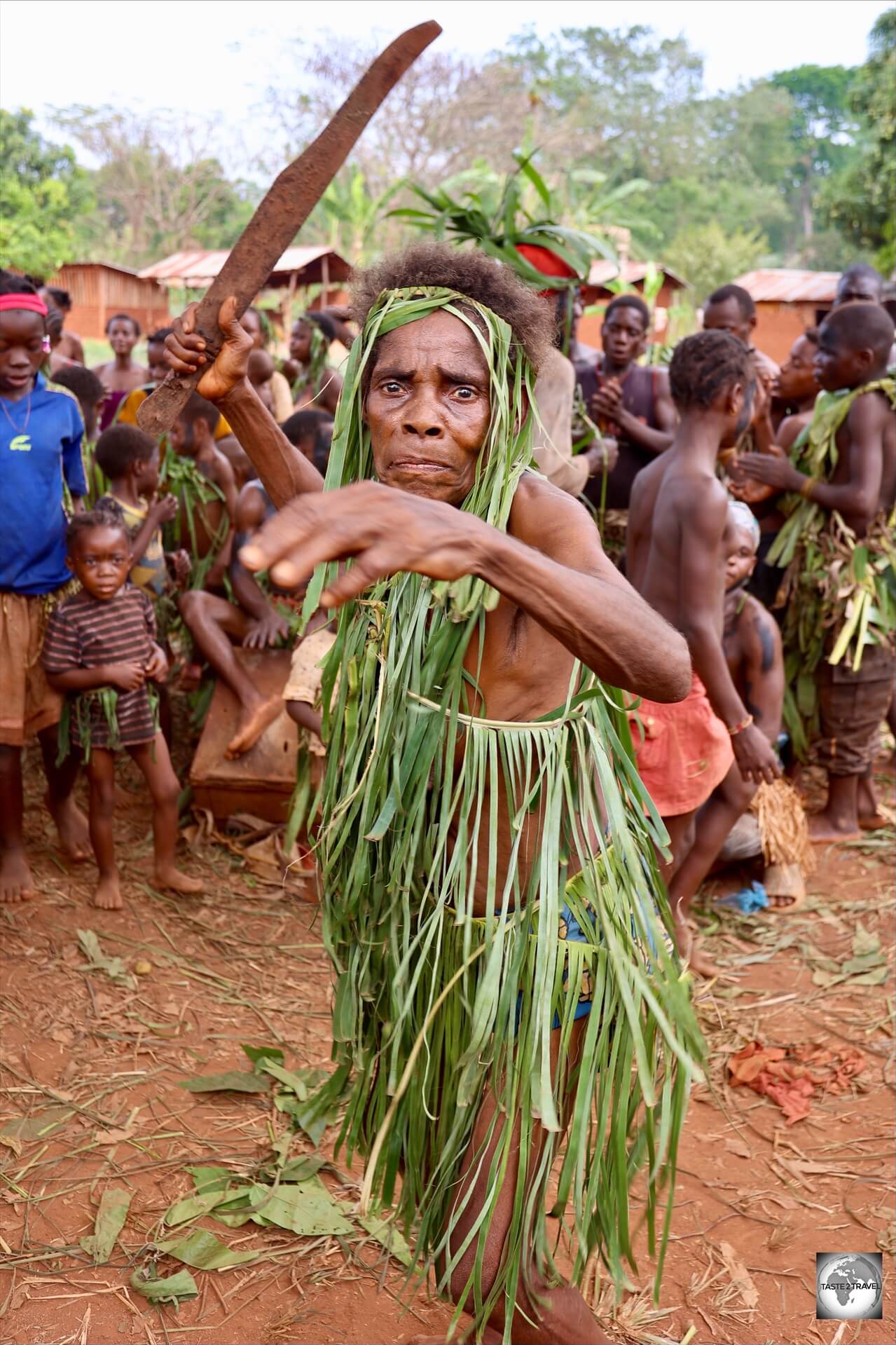
Aka Pygmies are known for their traditional song and dance.
Far from the crowds and commercial routes of mainstream tourism, CAR offers an off-the-beaten-path experience rich in untouched nature, authentic cultures, and raw beauty.
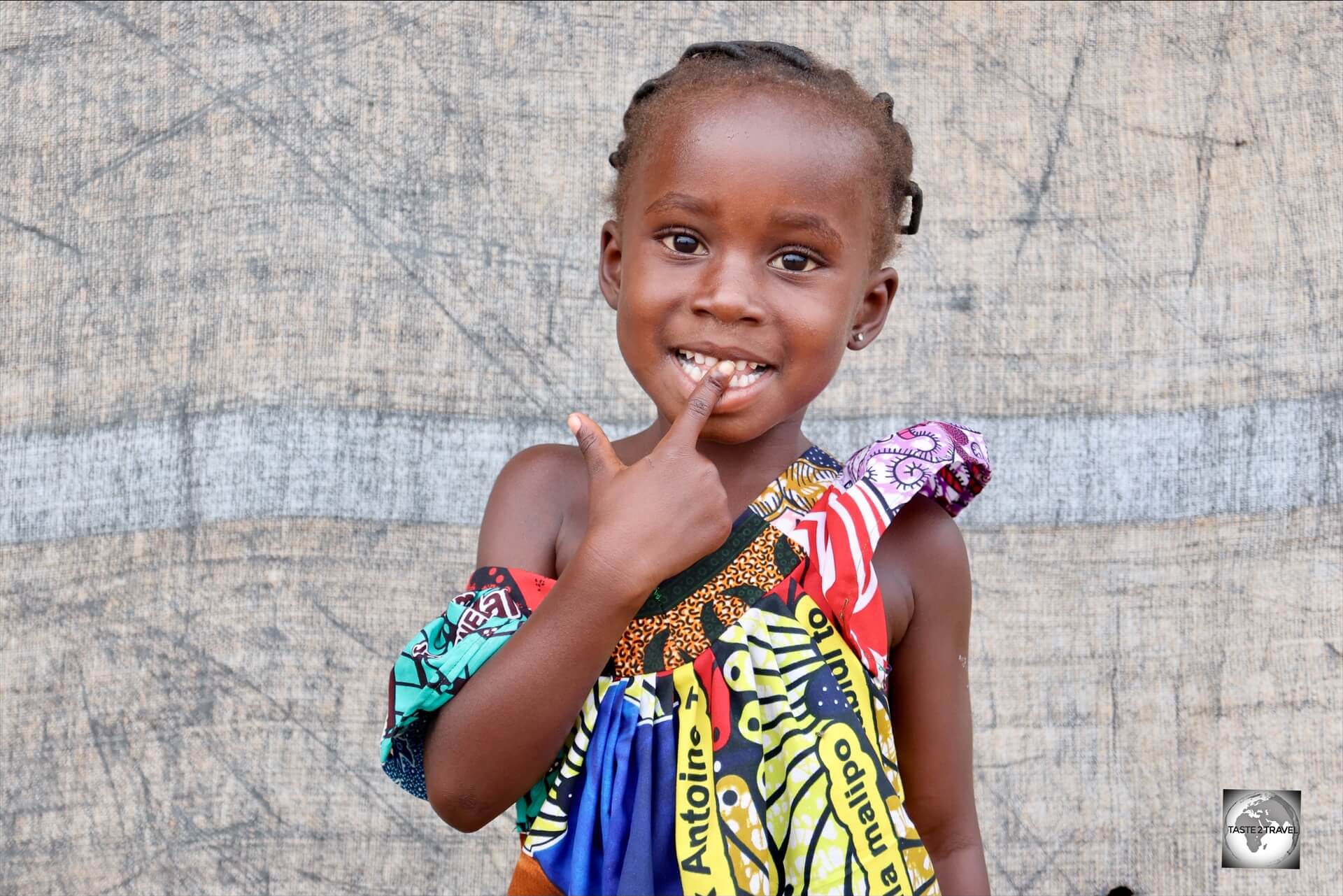
One of the cute inhabitants of “Camp île Bongo Soua”, a refugee camp on the banks of the Ubangi River in Bangui.
The Central African Republic has had a long and turbulent history of violent conflict and political instability.

A young woman, waiting on the banks of the Ubangi River, which flows past Bangui.
Though the journey to the CAR can be challenging, the reward is profound: meaningful encounters with local communities, vibrant traditions, and nature in its purest form, including Boali Waterfalls, considered to be the most spectacular waterfall in Central Africa.

Aka Pygmies are known for their traditional song and dance.
A destination for intrepid travellers, the Central African Republic awaits with stories few have heard – and even fewer have seen for themselves.
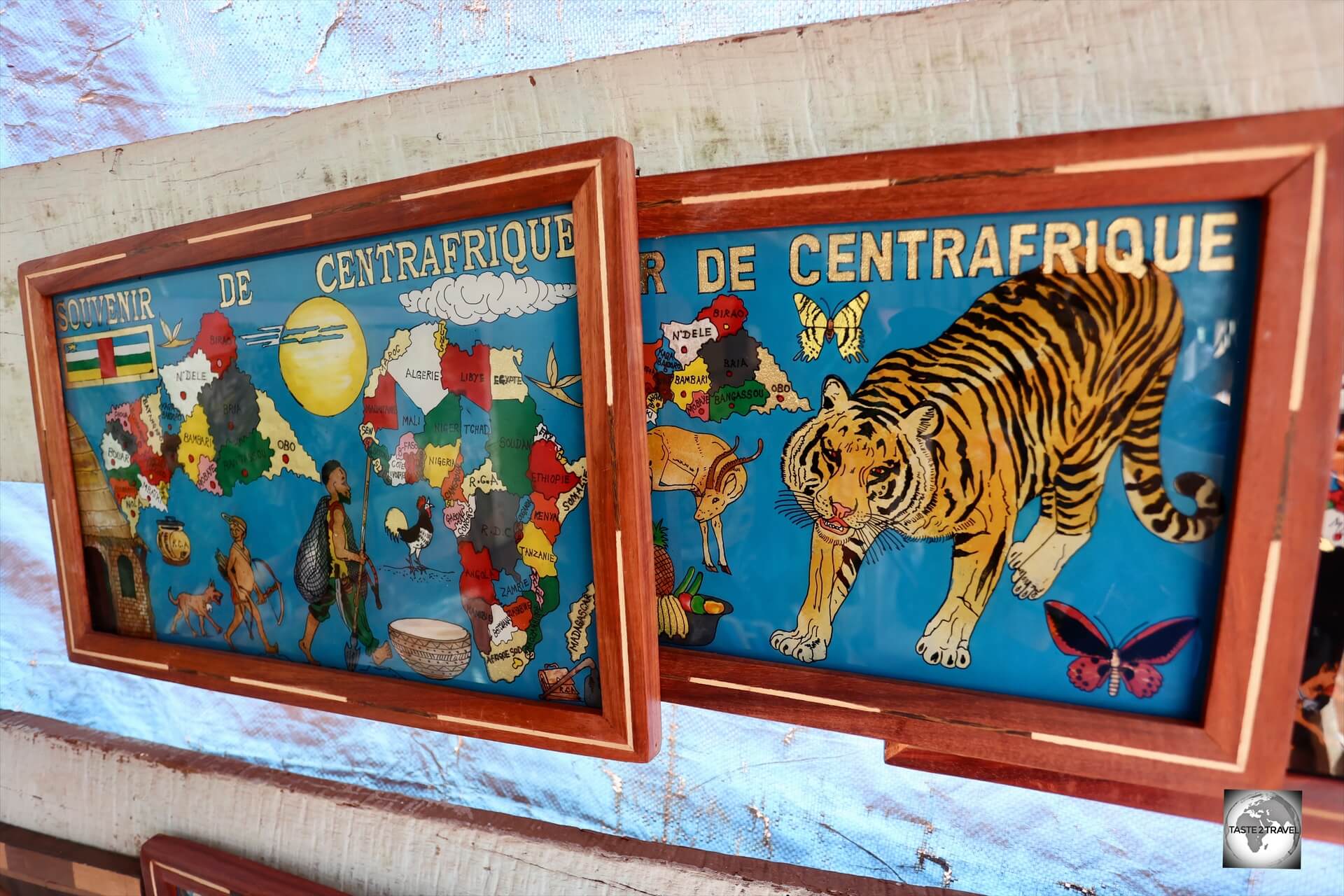
Souvenirs for sale at the Centre Artisanal in Bangui.
While I normally travel solo, I chose to travel to CAR with a group of 10 fellow travels from the Nomad Mania website.
We travelled with a local travel guide/ fixer, Steve Whulmer Abraham Yandault, who is the owner of Sway Tour in Bangui.
Steve organised the all-important Message Porte, a letter of invitation (LOI), which allows you to collect your visa on arrival at Bangui Airport.
I have included the contact details for Steve in the ‘Tour Guide‘ section below.
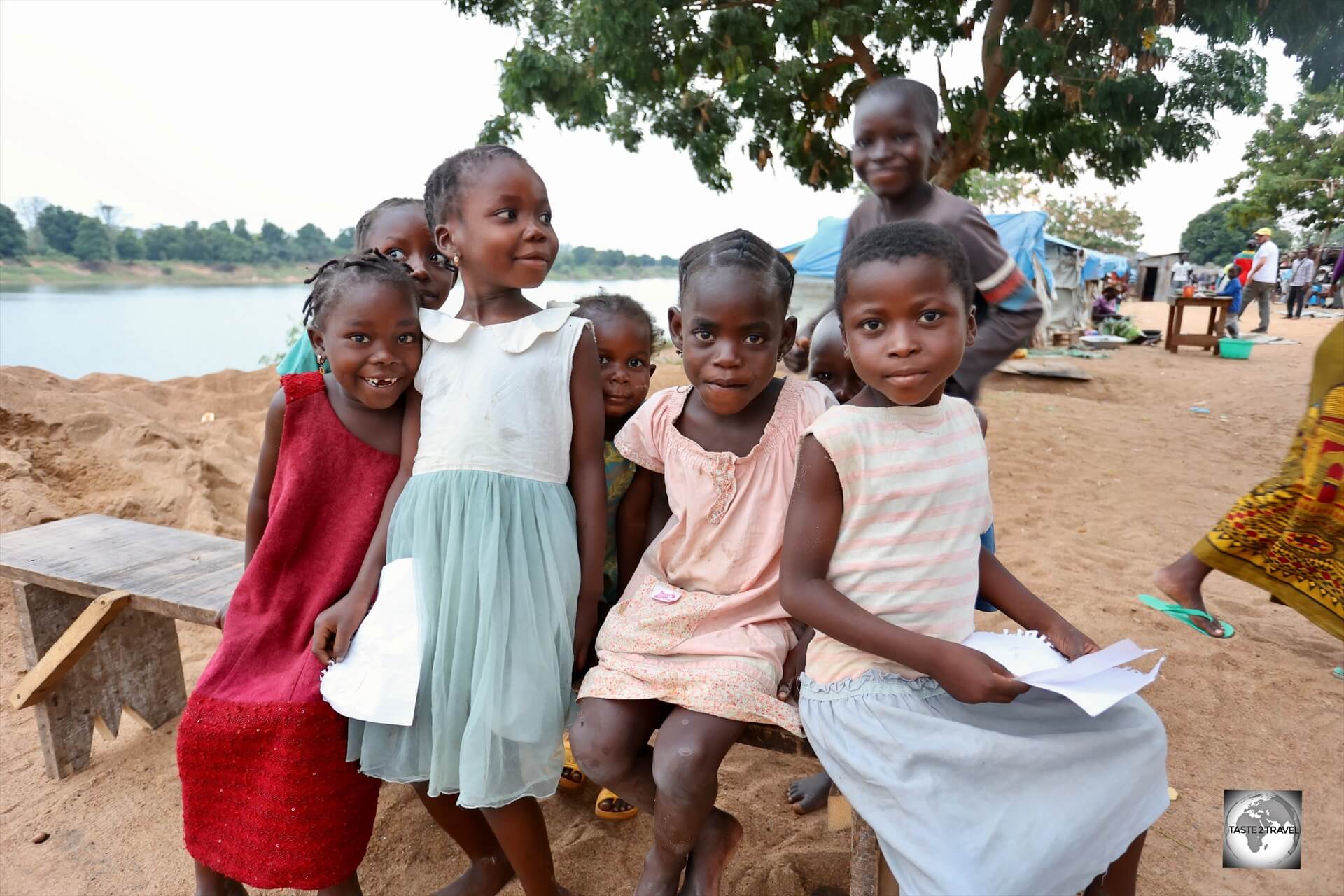
Children at “Camp île Bongo Soua”, a refugee camp which houses those who lost their homes on nearby Bongo Soua Island (background) due to flooding.
From a photography point of view, there is an abundance of amazing photos waiting to be taken in the CAR, with the locals especially keen to pose for the camera.
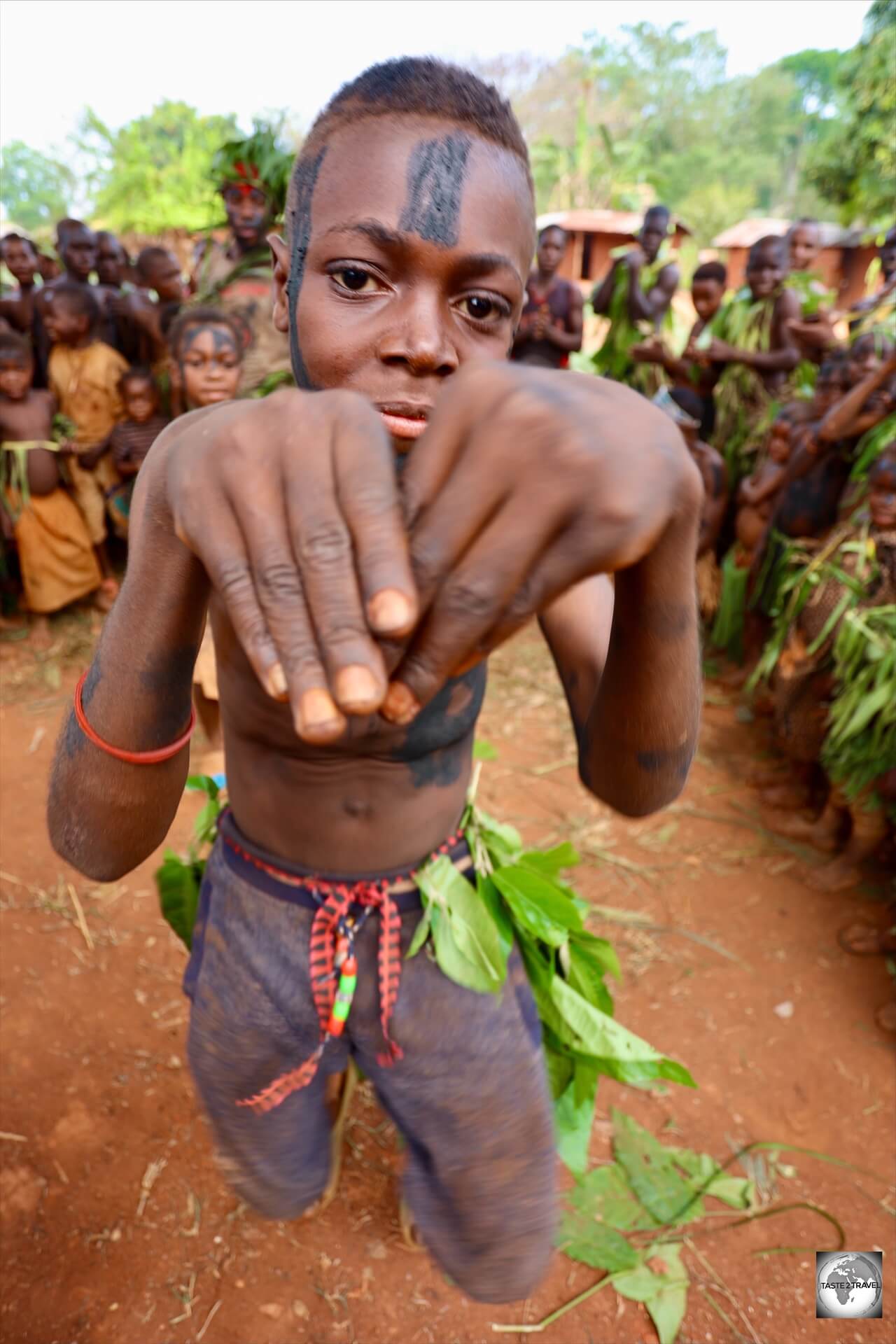
An Aka Pygmy youth, during a dance performance.
I have included just a small fraction of my photos in this travel guide, including some from a trip which was made to an Aka Pygmy tribe in the south-west of the country.
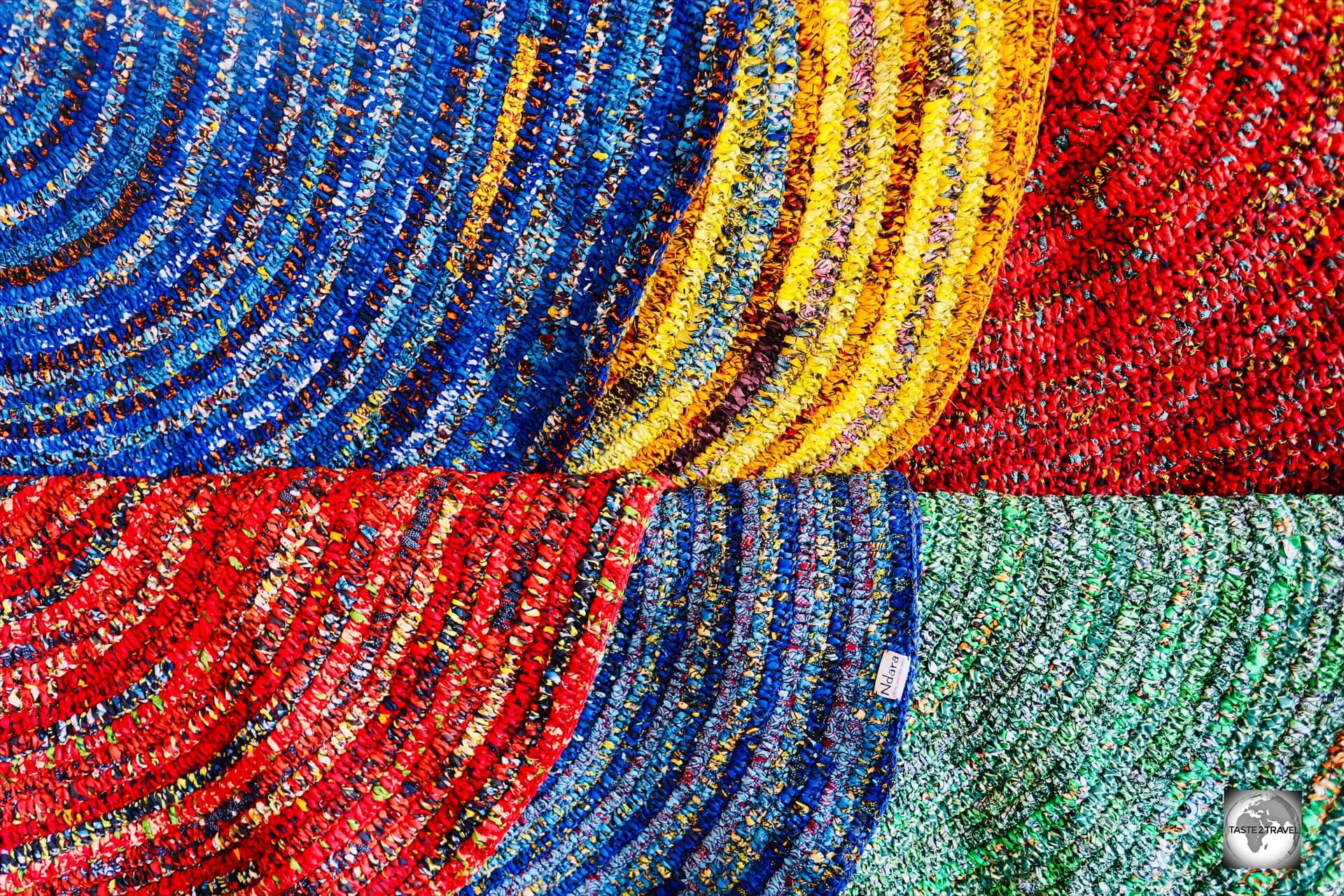
Braided rugs, in a rainbow of colours, at the Ndara Boutique in Bangui.
The Central African Republic, is a country which is often misunderstood and portrayed in a negative light but which is an interesting and engaging destination, with positive, good news stories and friendly and welcoming locals.
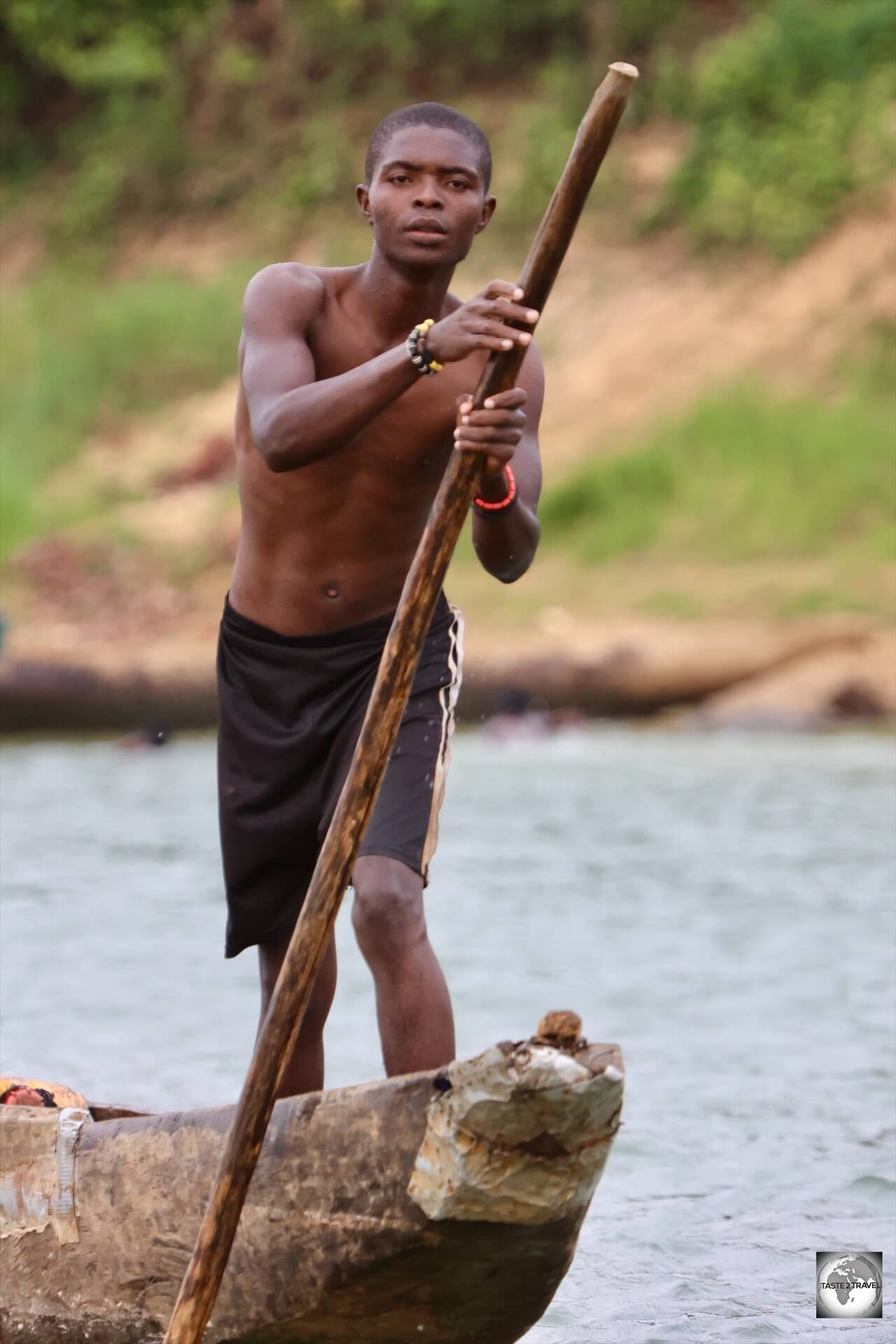
Travelling by pirogue on the Ubangi River.
Location
Located 4 degrees north of the Equator, the Central African Republic (CAR) is a landlocked country located almost in the geographic centre of the African continent.
Being landlocked, CAR depends heavily on Cameroon for access to seaports.
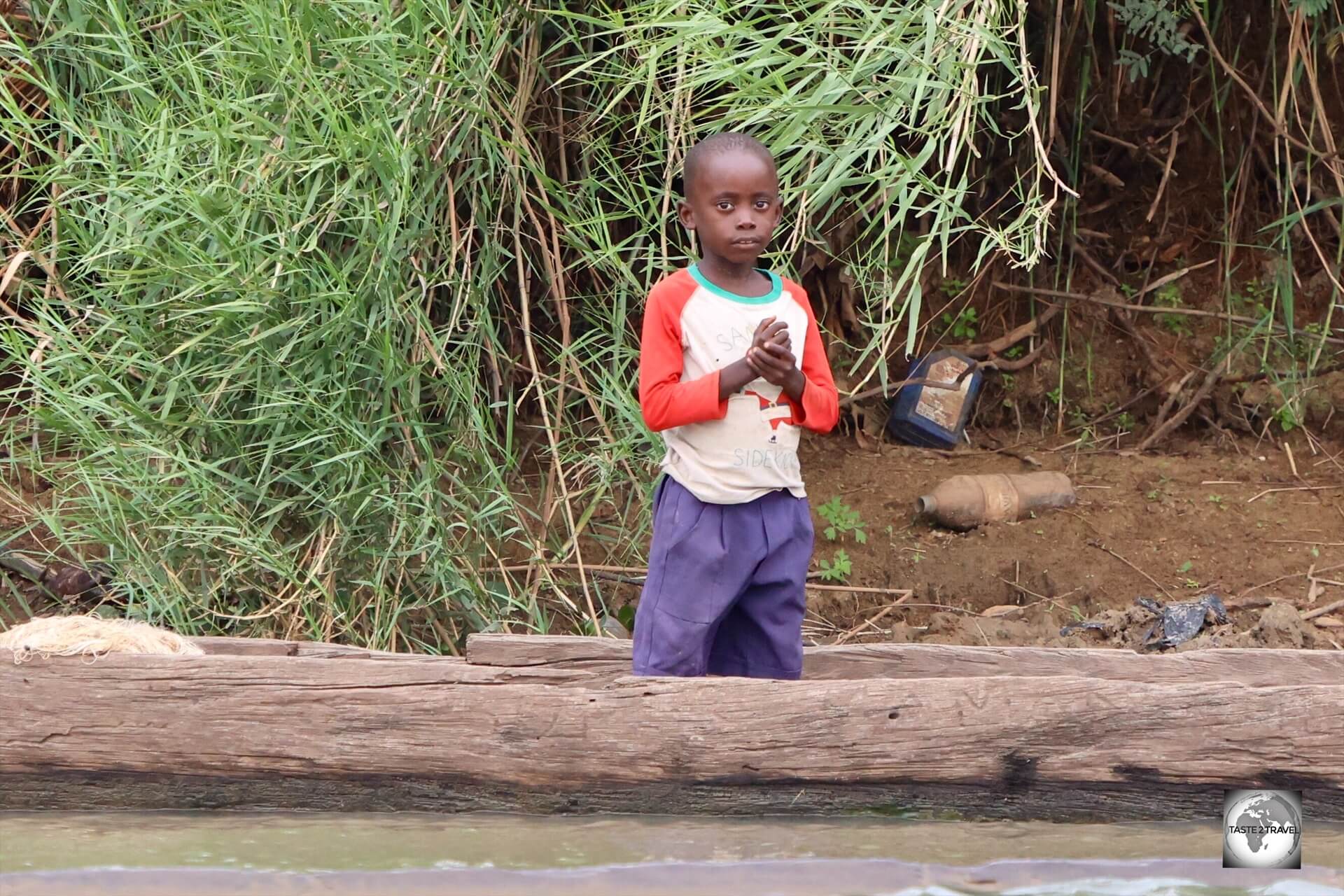
The Ubangi River, which flows through Bangui, is a part of the Congo River Basin and a major tributary of the Congo River.
River transport on the Ubangi River, and overland trade routes, are vital lifelines.
The terrain of the country is mostly savanna, with dense tropical forests in the south and semi-arid areas in the north.
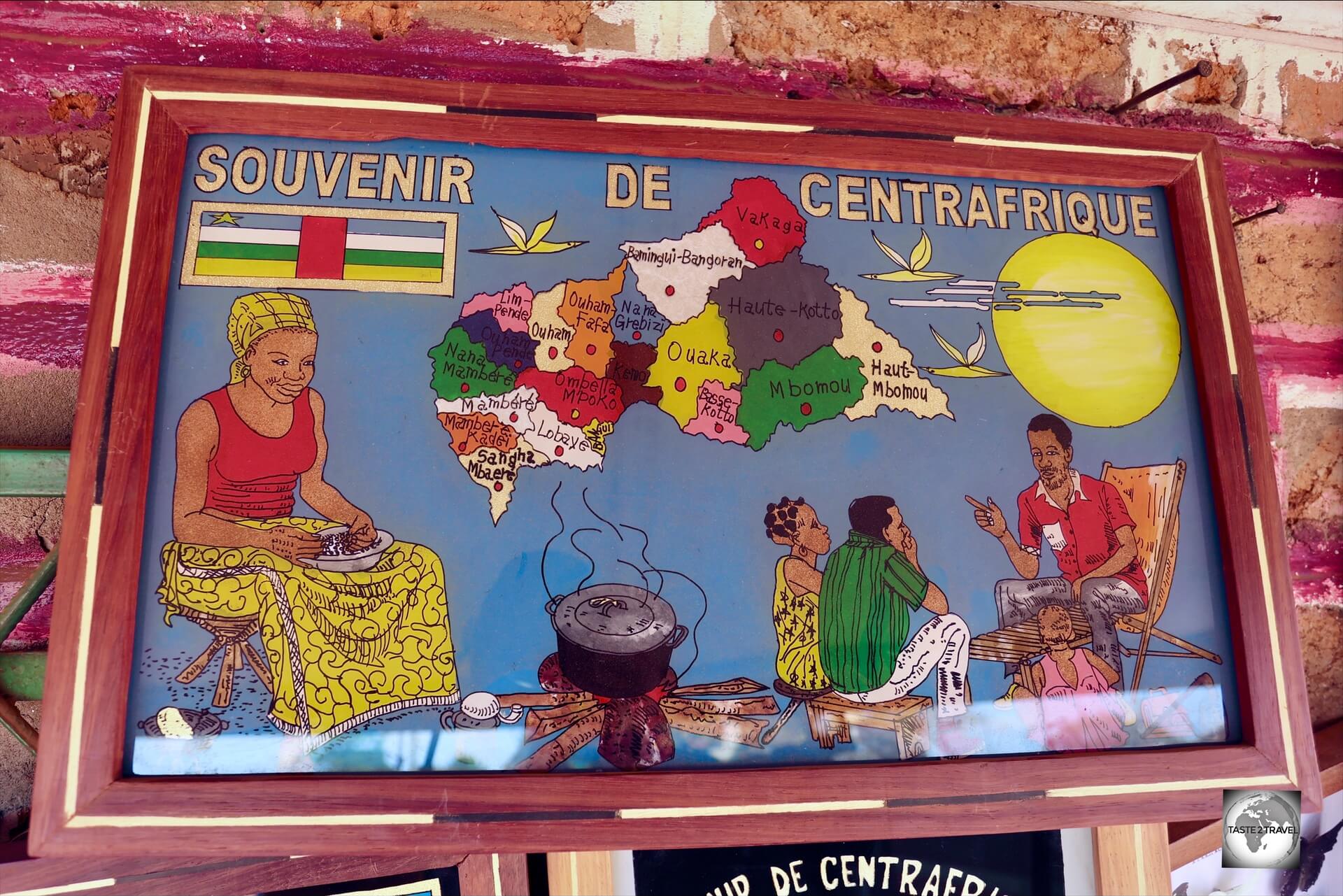
The Central African Republic is divided into 20 prefectures, as shown on this souvenir map at the Artisanal Market in Bangui.
The Central African Republic is divided into 20 prefectures.
These prefectures are further subdivided into 84 sub-prefectures.
CAR shares borders with six countries which are:
- North: Chad
- East: Sudan and South Sudan (click to read my travel guide!)
- South: Democratic Central African Republic and Republic of the Congo (click to read my travel guide!)
- West: Cameroon
Two major rivers are the Ubangi, which forms the southern border with DRC, and Sangha, both tributaries of the Congo River system.

The Ubangi River forms the border between the CAR and the DRC.
With a total length of 1,060 km (660 mi), the Ubangi River is the largest tributary of the Congo River and allows river navigation from Bangui to Brazzaville (capital of the Republic of Congo) and Kinshasa (capital of the DRC).

A fisherman, on the Ubangi River, which flows past Bangui, the capital of the Central African Republic.
Bangui, CAR’s capital, lies directly on the Ubangi River, across from the DRC.
History
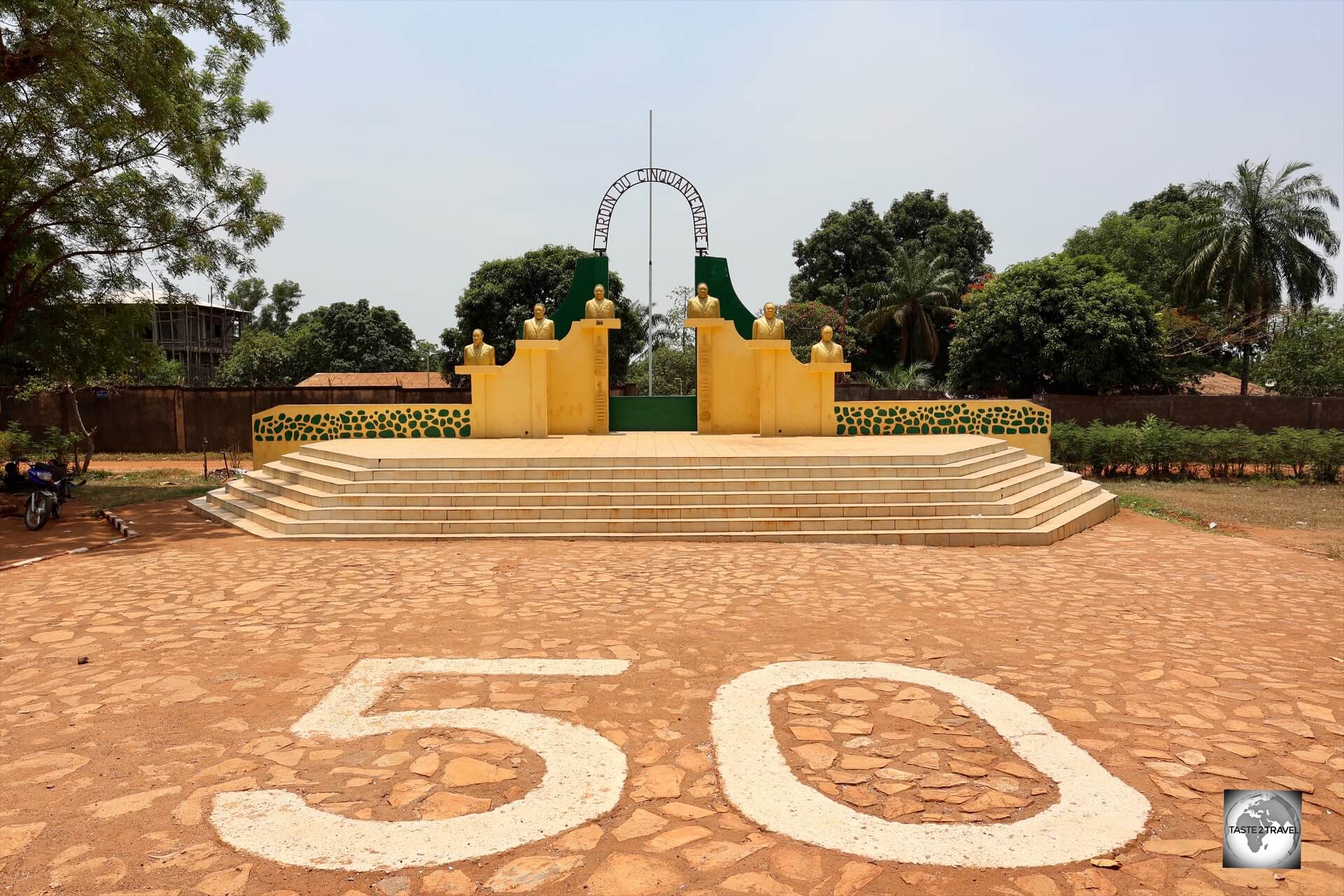
The “Jardin du Cinquantenaire” (50th Anniversary Garden) was established to celebrate 50 years of independence on the 1st of December 2008.
The Central African Republic (CAR) has a complex and turbulent history marked by colonisation, political instability, coups, and conflict.
Pre-Colonial Era
Before European colonisation, the region now known as CAR was home to various ethnic groups and kingdoms, such as the Banda, Baya, and Zande peoples.
These groups had their own systems of governance and trade networks, and some were linked to trans-Saharan trade routes.
Slave raiding from neighbouring regions, including the Sahel and Sudan, heavily affected local populations.
Colonial Rule (Late 1800s – 1960)
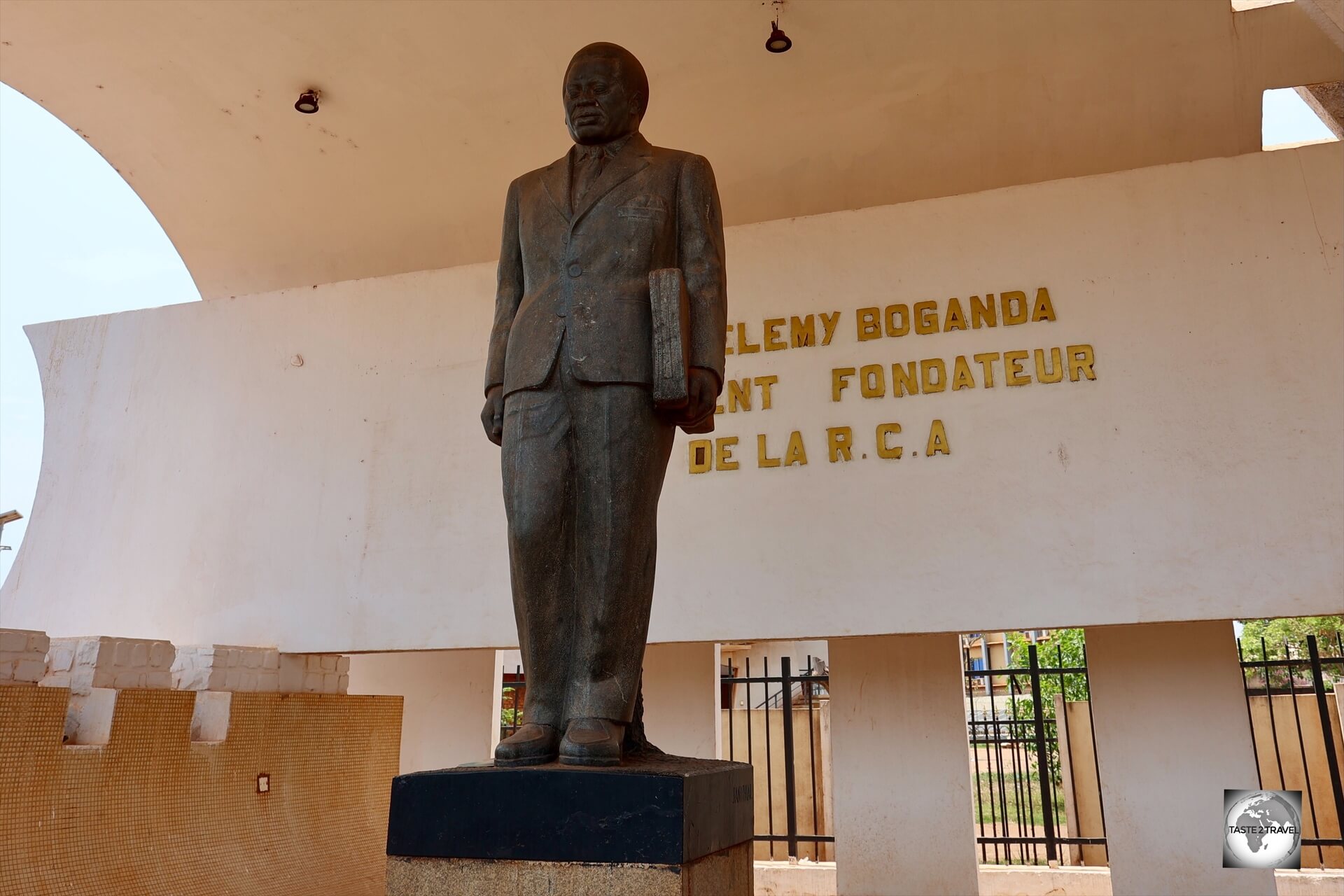
This monument in Bangui is dedicated to Barthélemy Boganda, leader of the CAR Independence movement and the first Premier of the CAR.
In the late 19th century, during the “Scramble for Africa,” France colonised the area, incorporating it into French Equatorial Africa in 1910.
The region was known as Ubangi-Shari.
During this time, French rule was exploitative, with forced labor and harsh treatment of local populations.
Resistance was met with brutal suppression.
After World War II, political reform movements gained traction.
Barthélemy Boganda emerged as a key figure advocating for autonomy.
A monument in Bangui is dedicated to Boganda, who was the leader of the CAR Independence movement and the first Premier of an autonomous Central African Republic.
Independence and Early Postcolonial Period (1960–1981)
CAR gained independence from France on August 13, 1960.
David Dacko became the first president.
In 1966, Jean-Bédel Bokassa led a coup and ruled as a dictator.
In 1976, he declared himself Emperor Bokassa I and renamed the country the Central African Empire, staging a lavish coronation funded by state coffers.
In 1979, France intervened to remove Bokassa in “Operation Barracuda” after his regime became internationally condemned for human rights abuses.
Political Instability and Civil Wars (1981–Present)
During the 1980s and 1990s, the country saw a series of coups and short-lived governments.
Despite occasional elections, political instability persisted.
In the early 2000s, François Bozizé seized power in a 2003 coup.
Although initially welcomed, his rule became increasingly authoritarian.
In 2013, the Séléka Rebellion, led by a coalition of mostly Muslim rebel groups known as Séléka, overthrew Bozizé, leading to sectarian violence.
In response, Christian militias called anti-Balaka emerged, creating a cycle of revenge killings
International forces intervened, and a UN peacekeeping mission (MINUSCA) remains active today.
Faustin-Archange Touadéra has served as president since 2016, winning reelection in 2020.
However, the government still struggles with limited control outside the capital, Bangui, due to rebel groups and weak institutions.
The CAR faces ongoing humanitarian issues, with widespread displacement, poverty, and food insecurity.
The government continues to rely on foreign support, including from Russia (notably through Wagner Group mercenaries) and the United Nations, to maintain security.
People
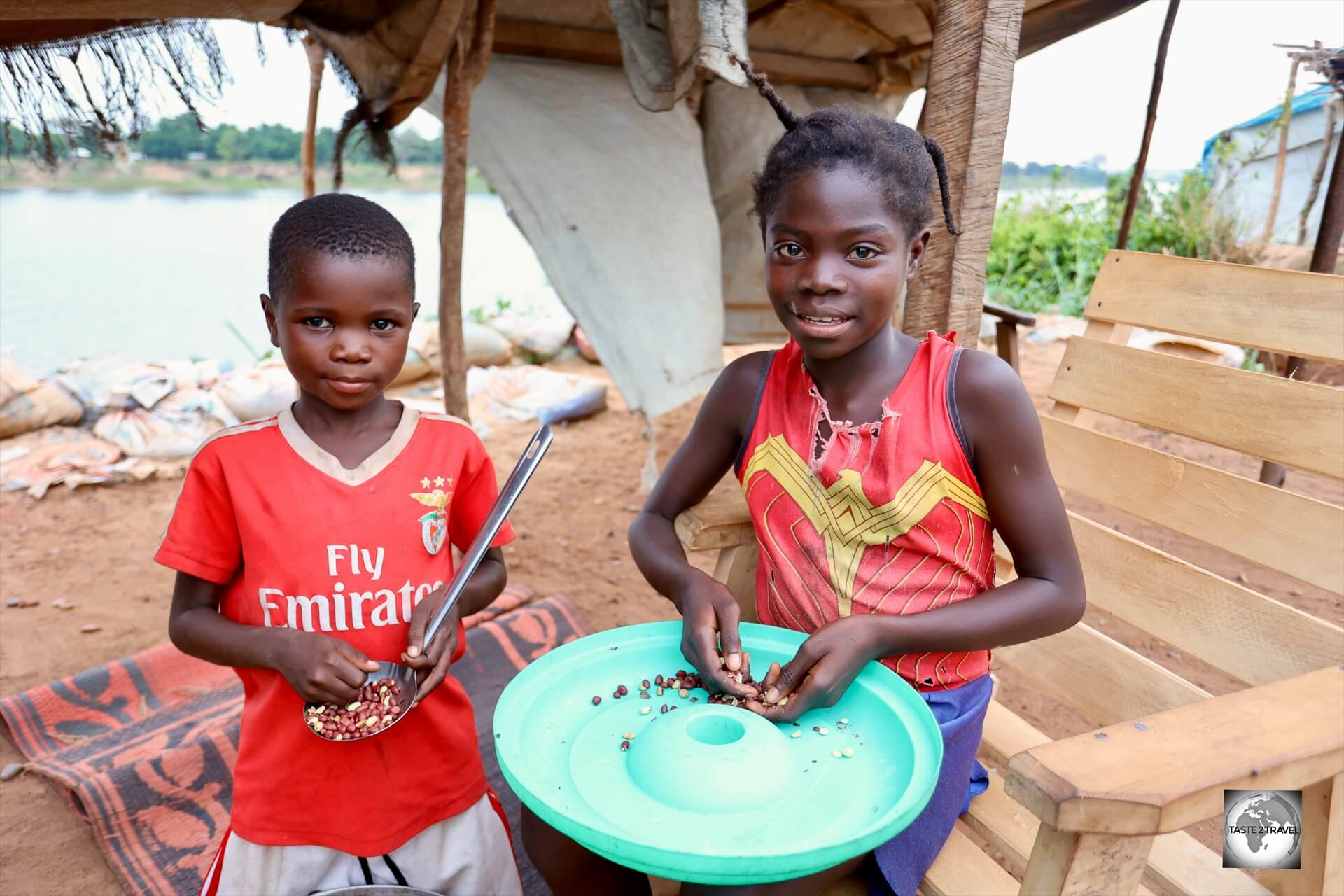
Children in a refugee camp in Bangui, Central African Republic.
The Central African Republic (CAR) is a diverse country with a rich tapestry of ethnic groups.
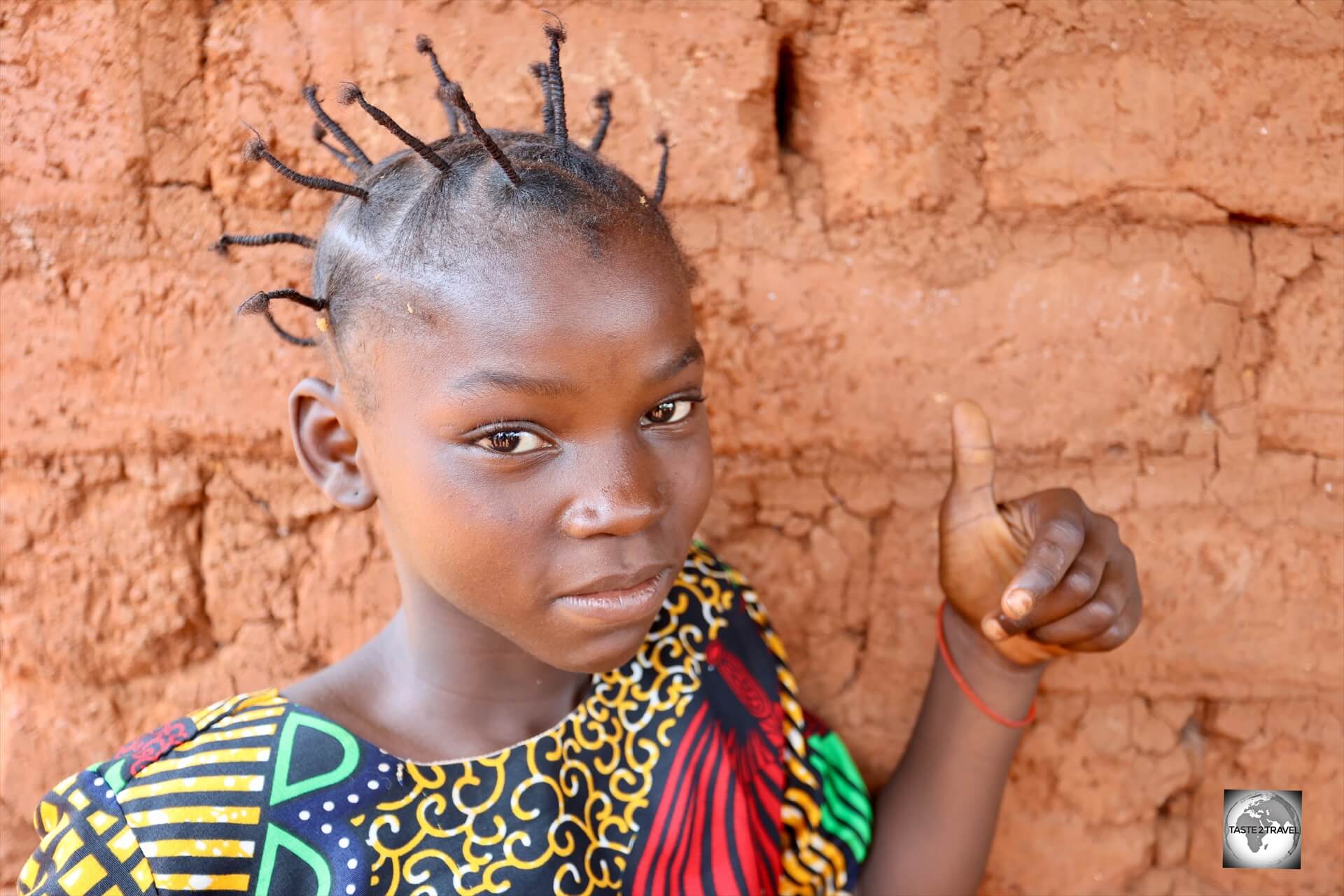
An Ata Pygmy girl.
Though it has a relatively small population (around 5 million), it is home to more than 80 distinct ethnic groups.
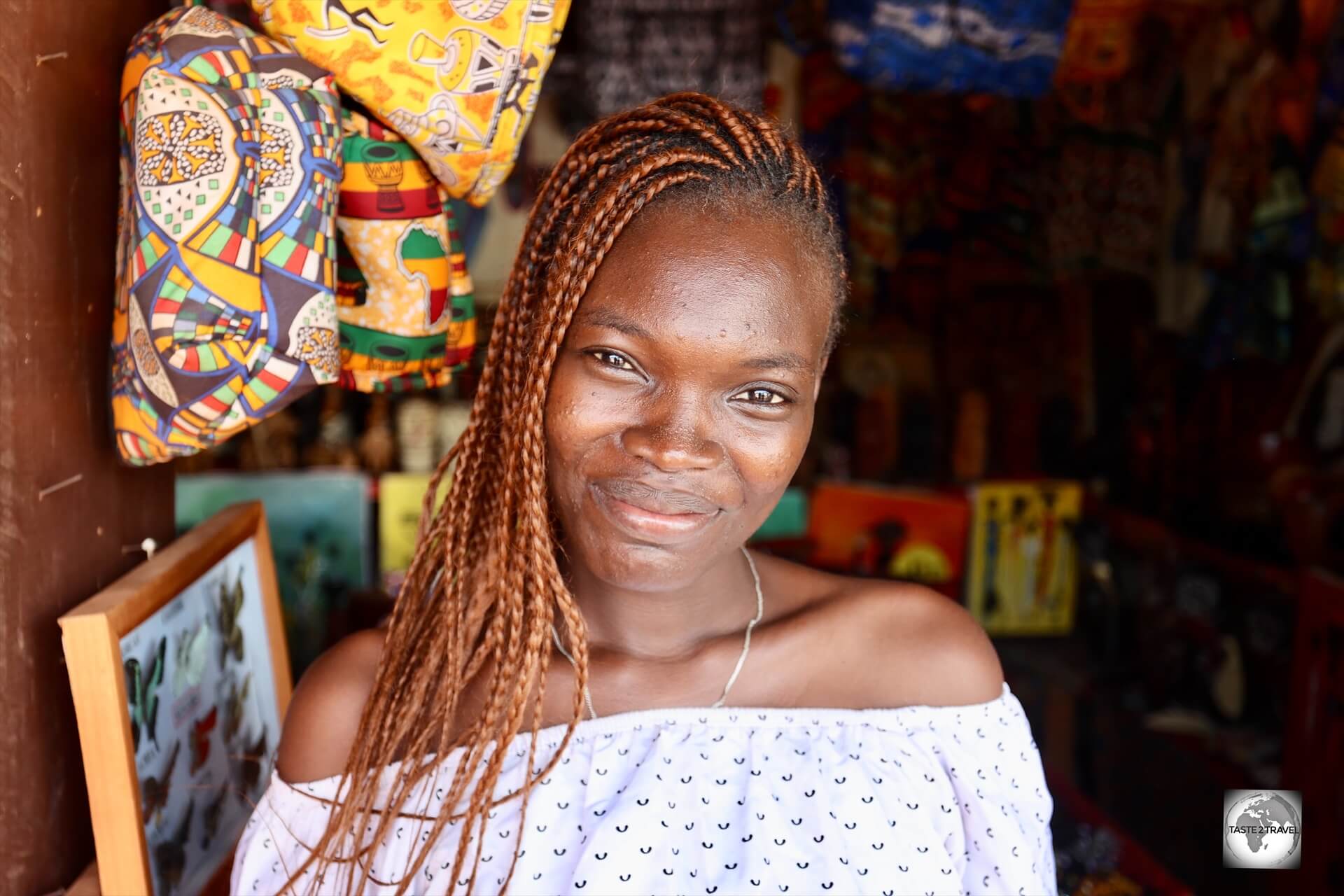
A friendly shop owner at the Artisanal Market in Bangui.
These groups can be broadly categorised into several major ethnolinguistic clusters, primarily of Bantu, Sudanic, and Ubangian origins.
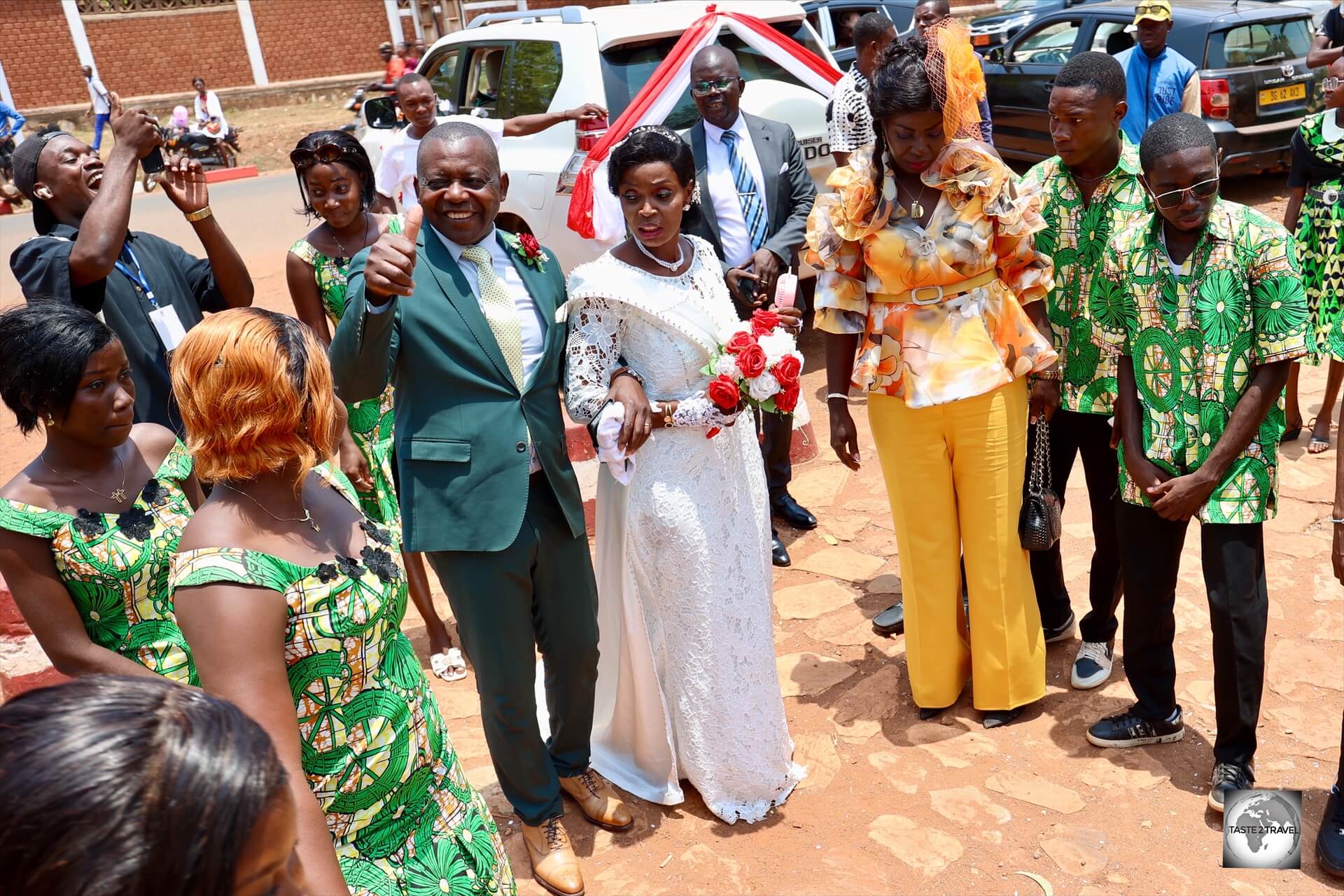
A traditional Christian wedding in Bangui, the capital of the Central African Republic.
In terms of religion, the people of the CAR practice Christianity (Catholic and Protestant), Islam (mainly among the Fulani and some northeastern groups), and traditional African religions.
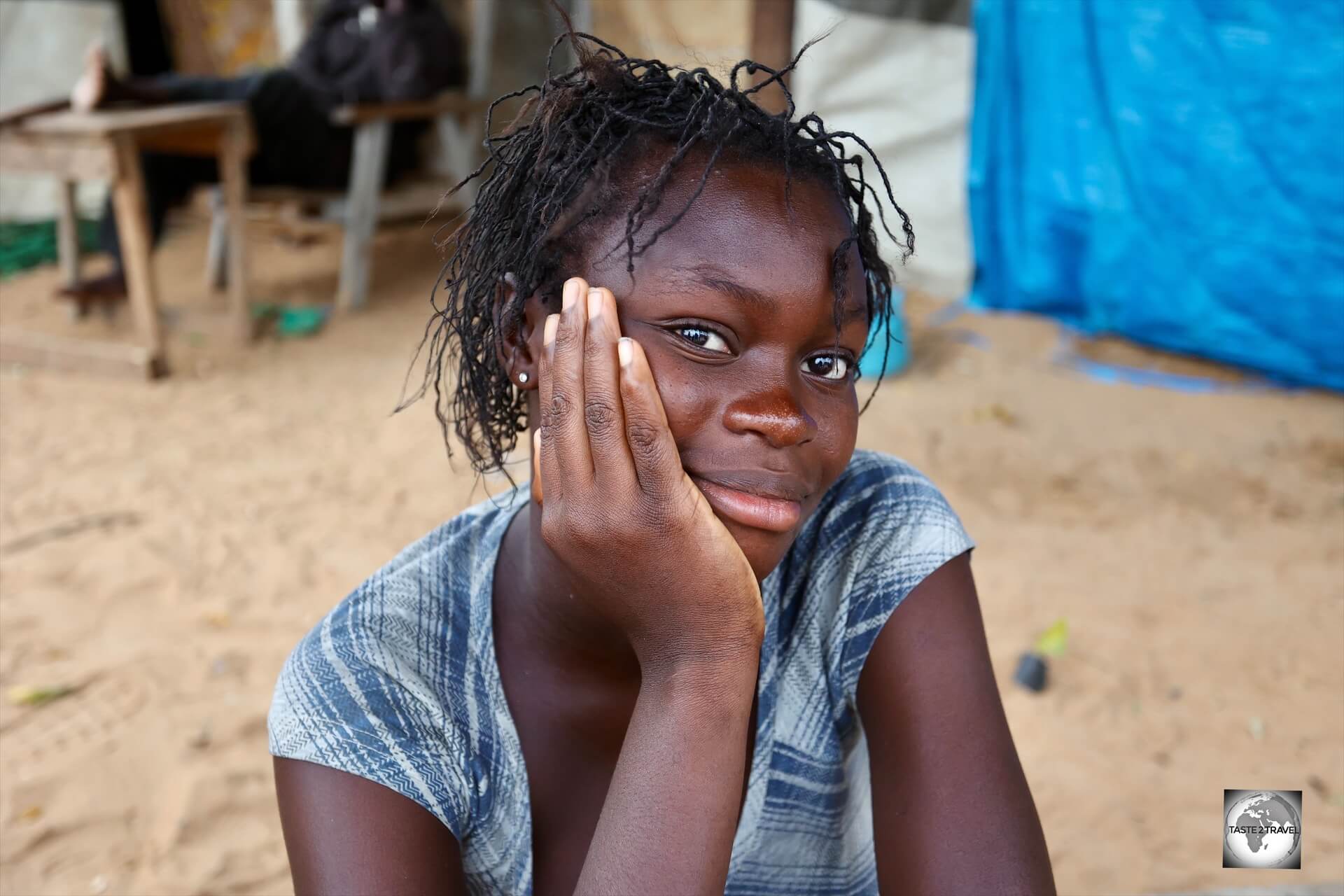
The Central African Republic is home to more than 80 different ethnic groups.
Political and religious tensions have sometimes aligned with ethnic divisions, especially during the civil conflicts since 2013.
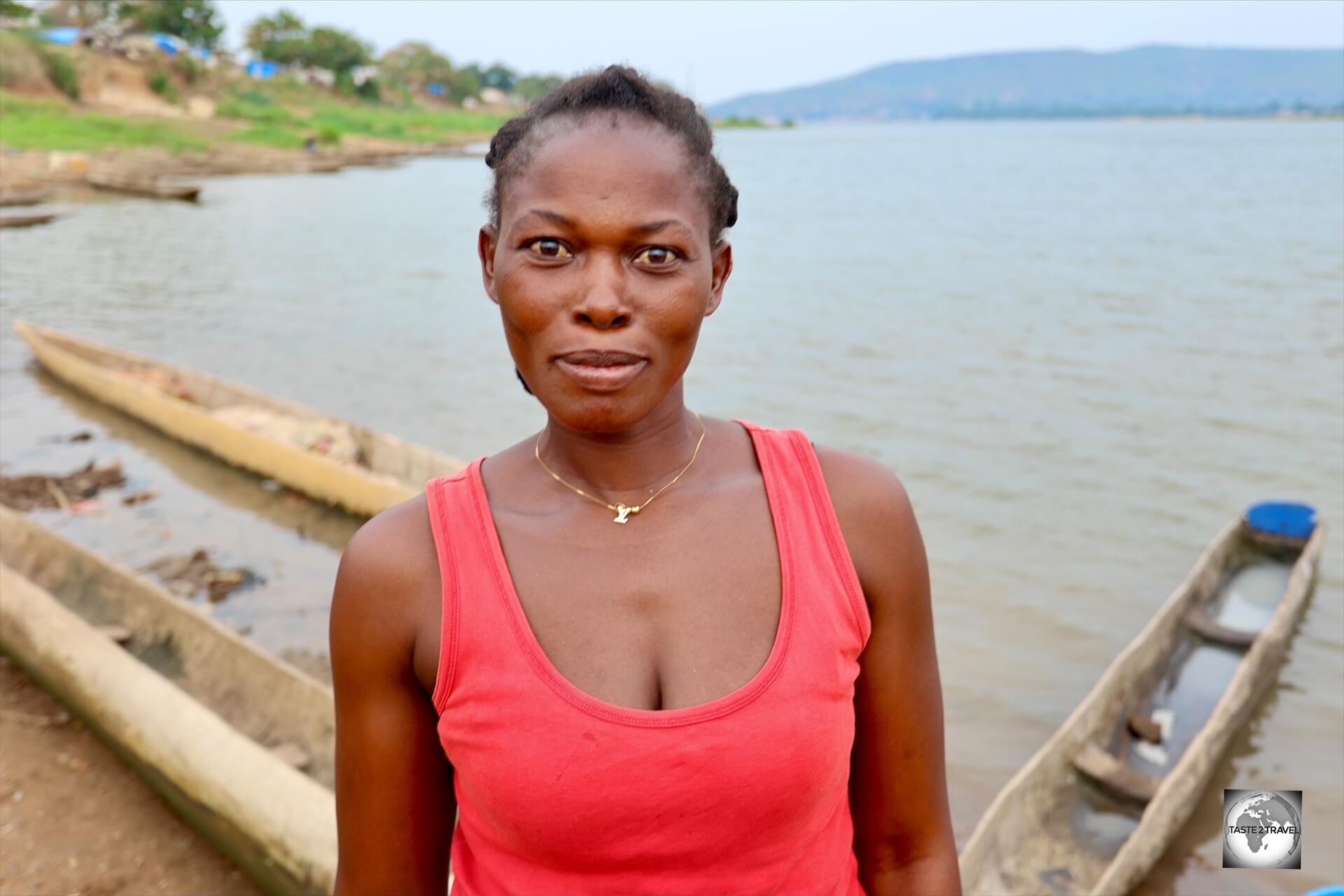
A resident of “Camp île Bongo Soua”.
Flag
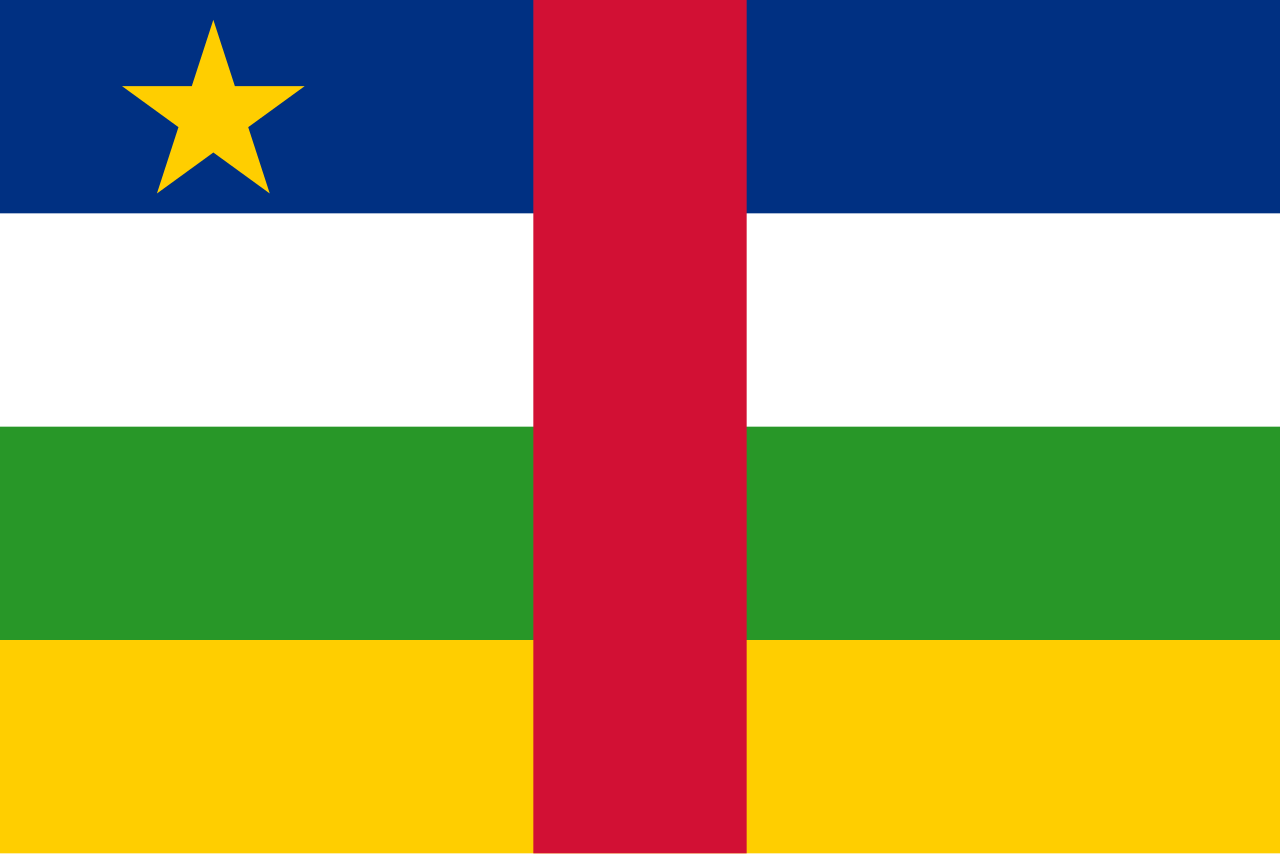
Flag of the Central African Republic.
With its distinct design, the flag of the Central African Republic features four horizontal stripes of blue, white, green and yellow, and a single vertical band of red, with a yellow five-pointed star in the upper left corner.
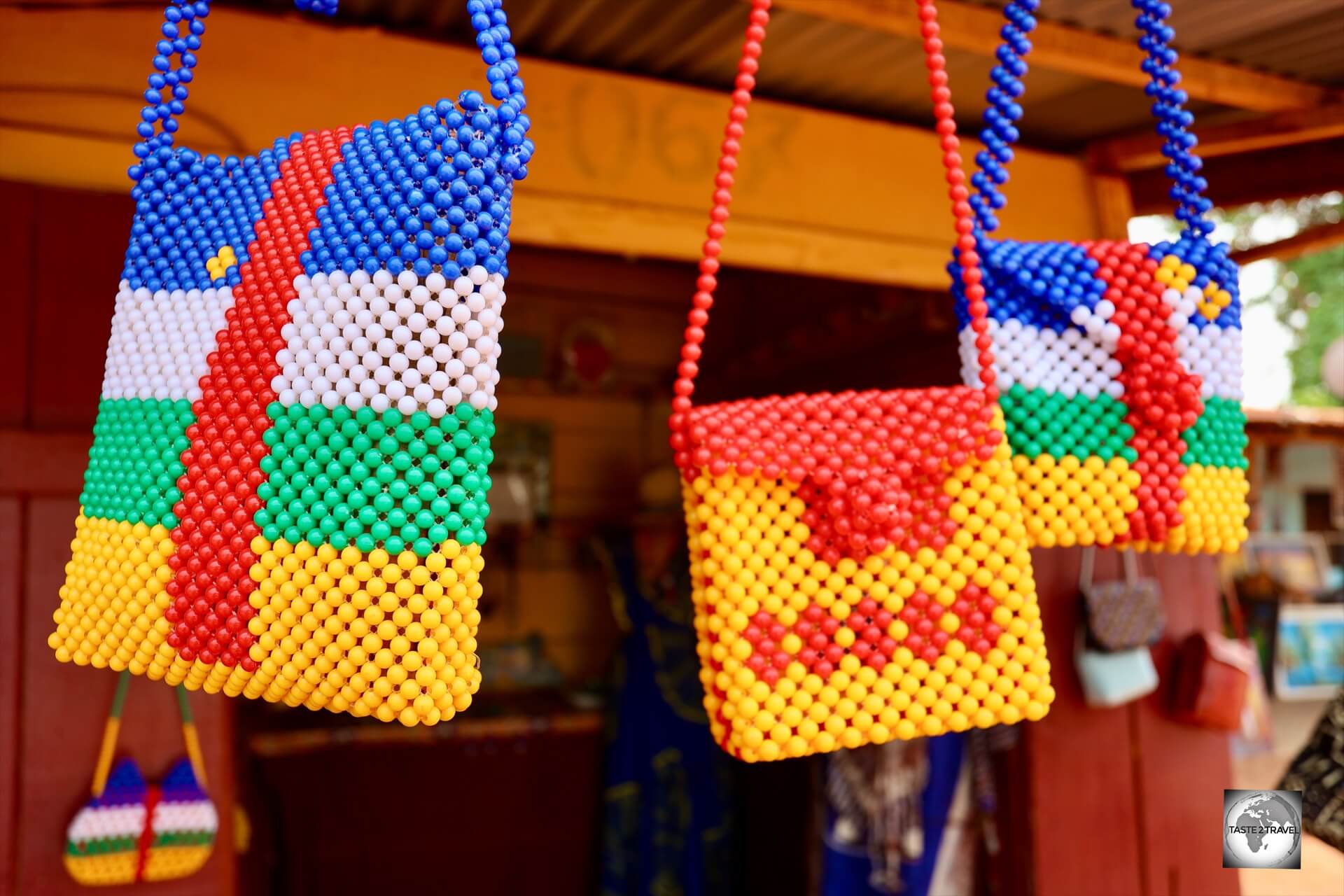
Beaded bags, in the colours of the flag of the CAR, at a craft market in Bangui.
Each colour on the flag carries specific meanings:
- Blue: Liberty and the sky.
- White: Peace and dignity.
- Green: Hope and faith, and the lush forests of the south.
- Yellow: Tolerance and the savannas of the north.
- Red (vertical stripe): Unity and the blood shed for independence and sacrifice.
- Yellow Star: Independence, a guiding light, and aspiration toward a better future.
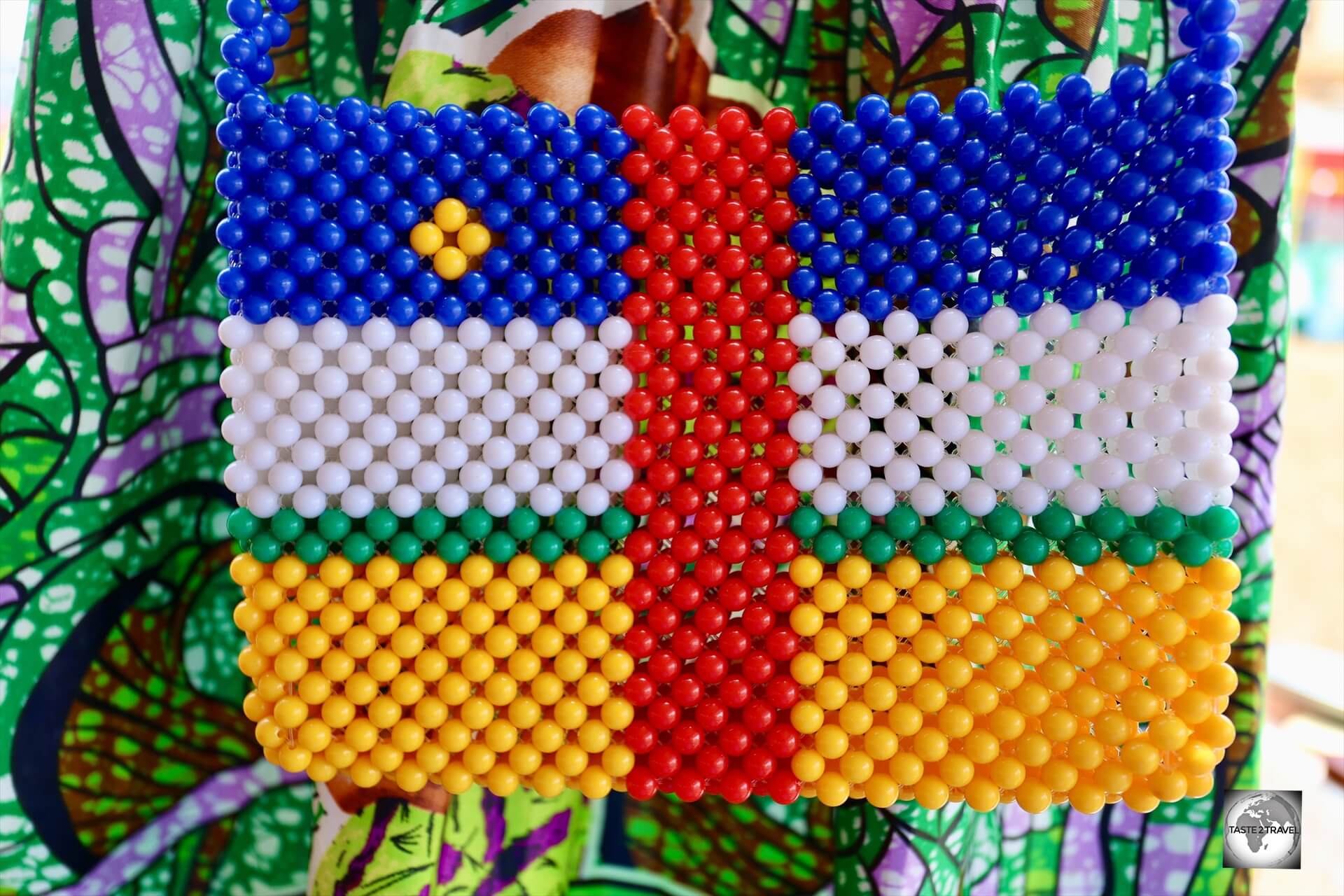
As a flag geek, I was happy to purchase this beaded flag bag as my souvenir of the CAR.
The flag is an iconic symbol in the country, appearing on bead-work bags, paintings and other souvenirs.
The flag was adopted on December 1, 1958, when the country gained autonomy from France (before full independence in 1960).
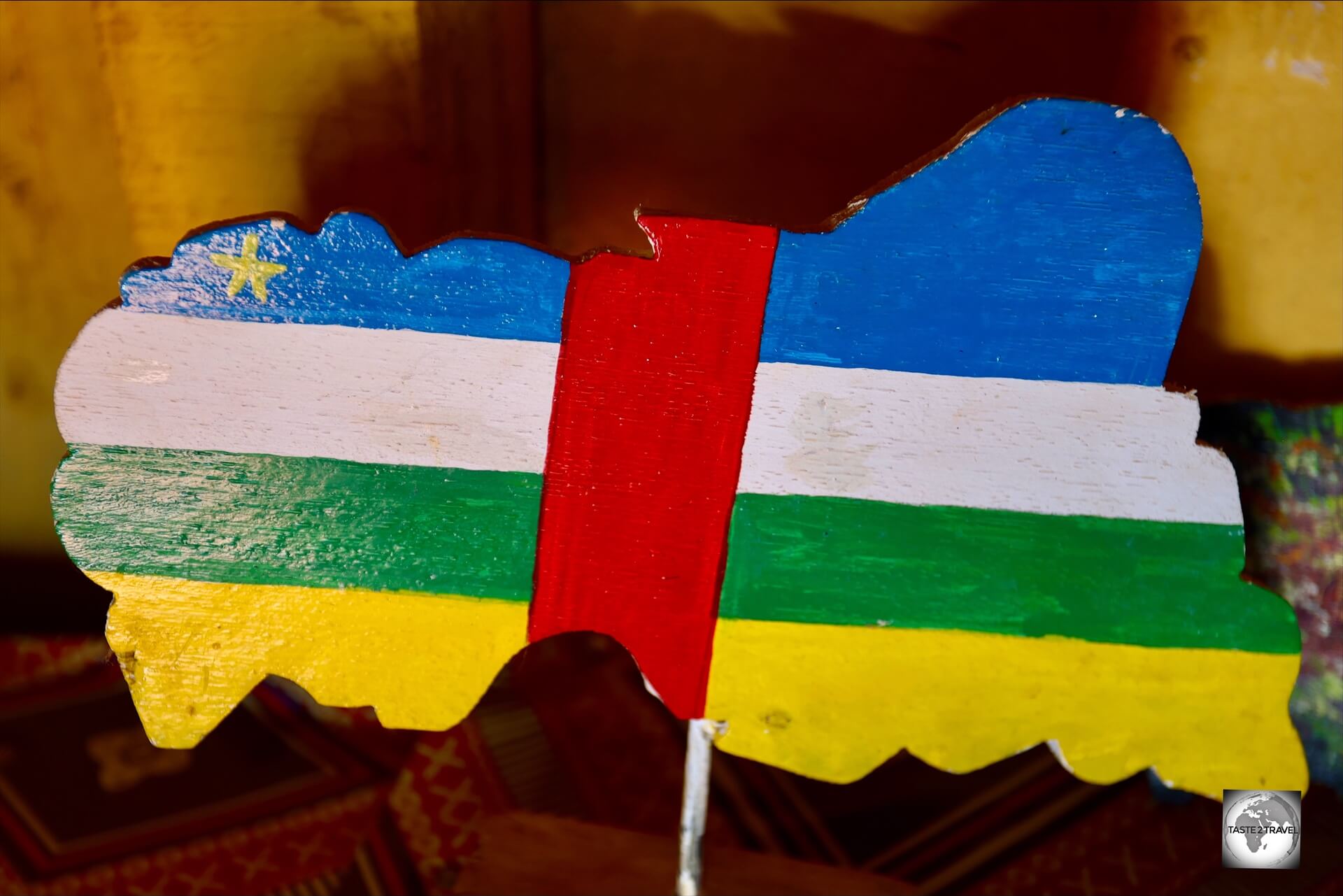
A wooden map of the Central African Republic, painted with the colours of the national flag.
The design was created by Barthélemy Boganda, a key figure in CAR’s independence movement and its first Prime Minister.
He wanted the flag to symbolise the coming together of Africa (green and yellow) and France (blue and white), with red as the shared blood of humanity – a call for unity across race and continent.
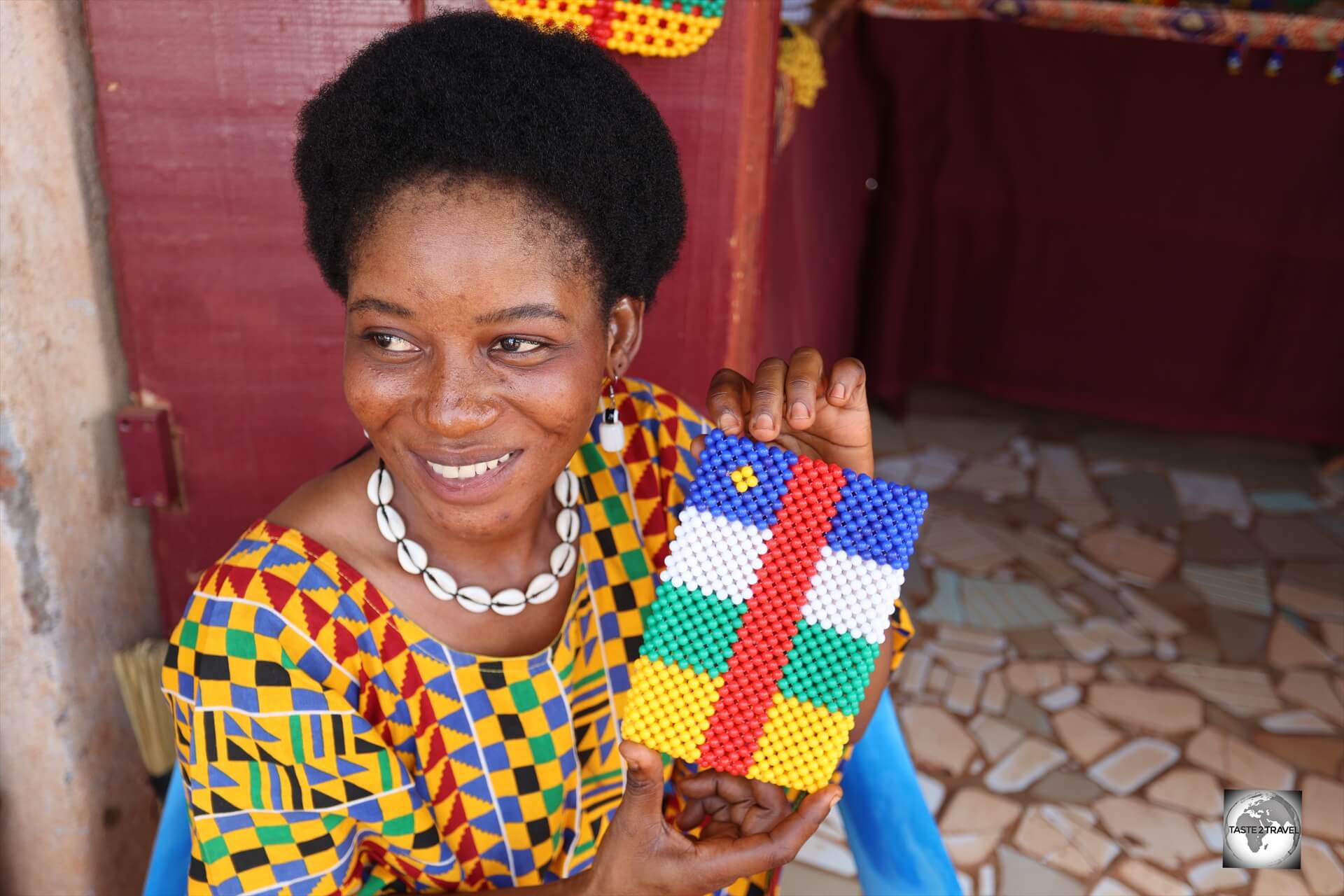
A craft shop owner in Bangui, displaying a CAR flag-themed mobile phone beaded carrier.
The yellow star is intended to be indicative of independence, as well as a symbol of African unity, progress and tolerance.
Currency
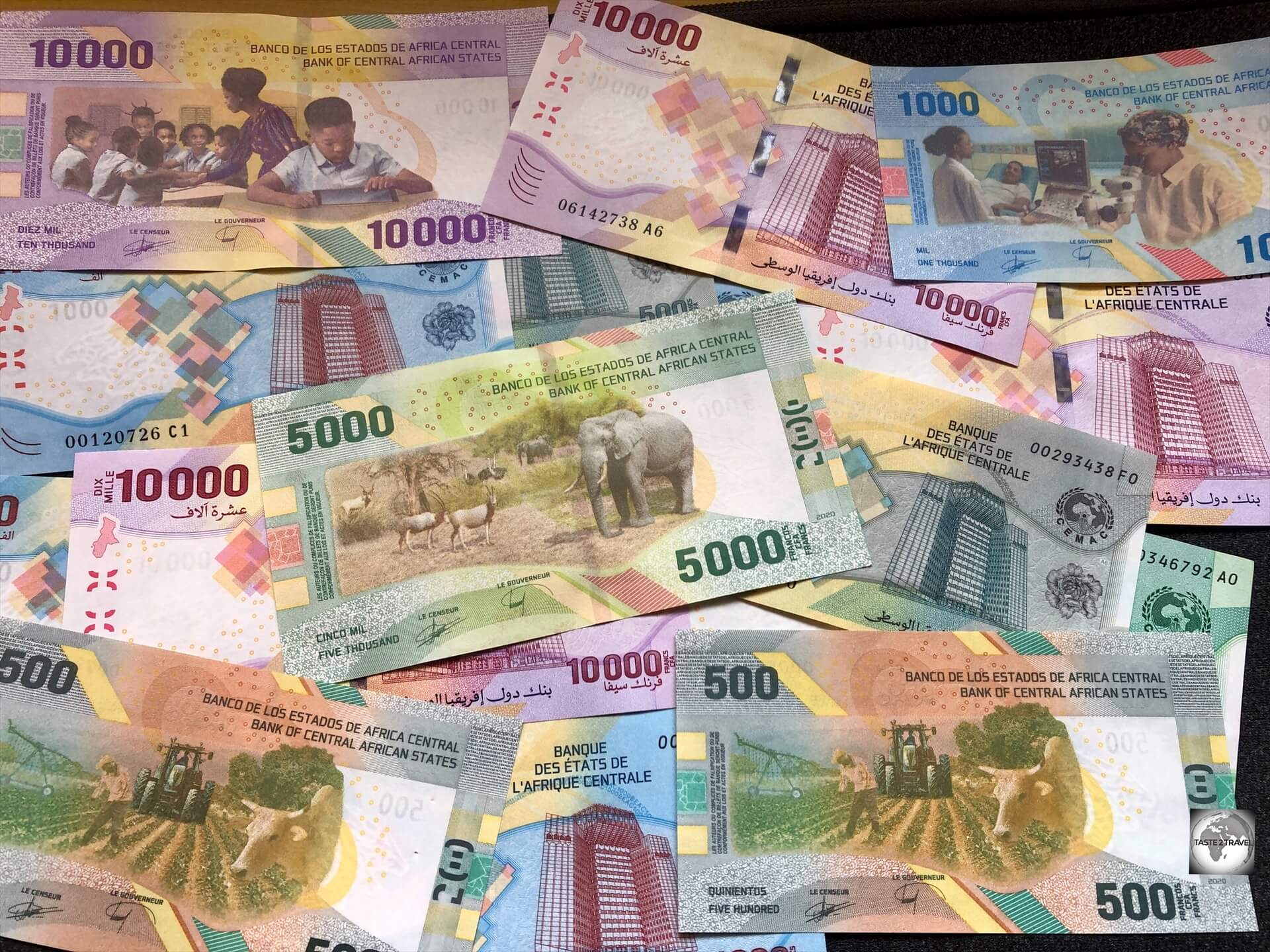
The currency of the Central African Republic is the Central African CFA franc, abbreviated as XAF.
The currency of the Central African Republic is the Central African CFA franc, abbreviated as XAF or sometimes written as FCFA (from Franc de la Coopération Financière en Afrique Centrale).
Apart from the Central African Republic, this currency is used by five other countries in Central Africa, including – Equatorial Guinea, Republic of the Congo (click to view my travel guides), Cameroon, Chad and Gabon.
The CFA franc is pegged to the Euro, with a fixed exchange rate, providing stability in international transactions.
Currently, €1 = 655.96 CFA francs.
This peg has meant that travel costs in all countries in the CFA zone are much higher than costs on the non-CFA countries.
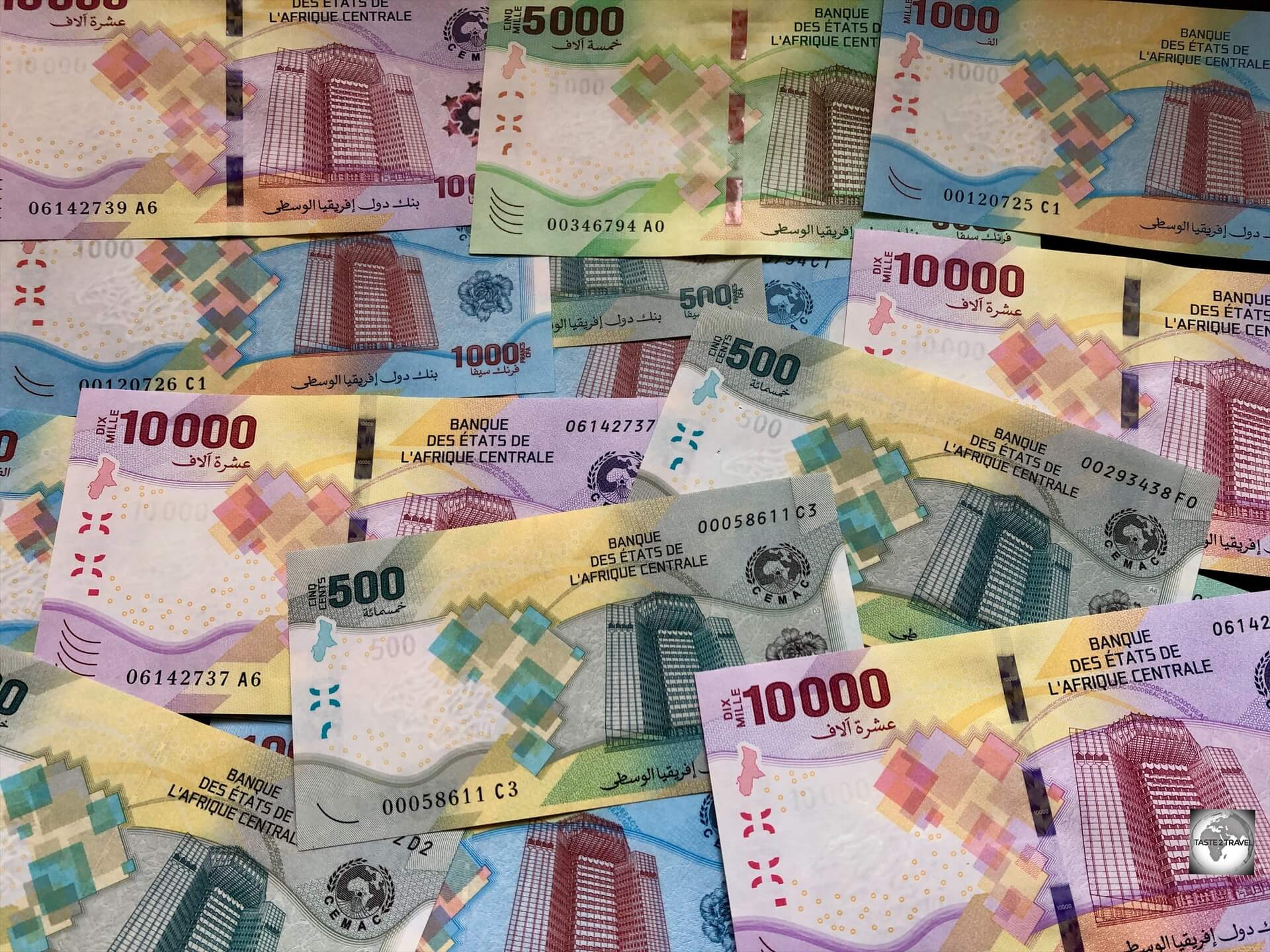
The currency of the Central African Republic is the Central African CFA franc, which is the official currency of six central African nations.
The currency is issued and regulated by the Bank of Central African States (BEAC), which is the central bank for the Central African Economic and Monetary Community (CEMAC).
The bank is headquartered in Yaoundé, Cameroon, with the headquarters building featured on the front of all banknotes.
The CFA franc is denoted by the symbol “FCFA” or “XAF” and is available in both coins and banknotes.
Coins are available in denominations of 1, 2, 5, 10, 25, 50, 100, and 500 francs, while banknotes are issued in denominations of 500, 1,000, 2,000, 5,000, and 10,000 francs.
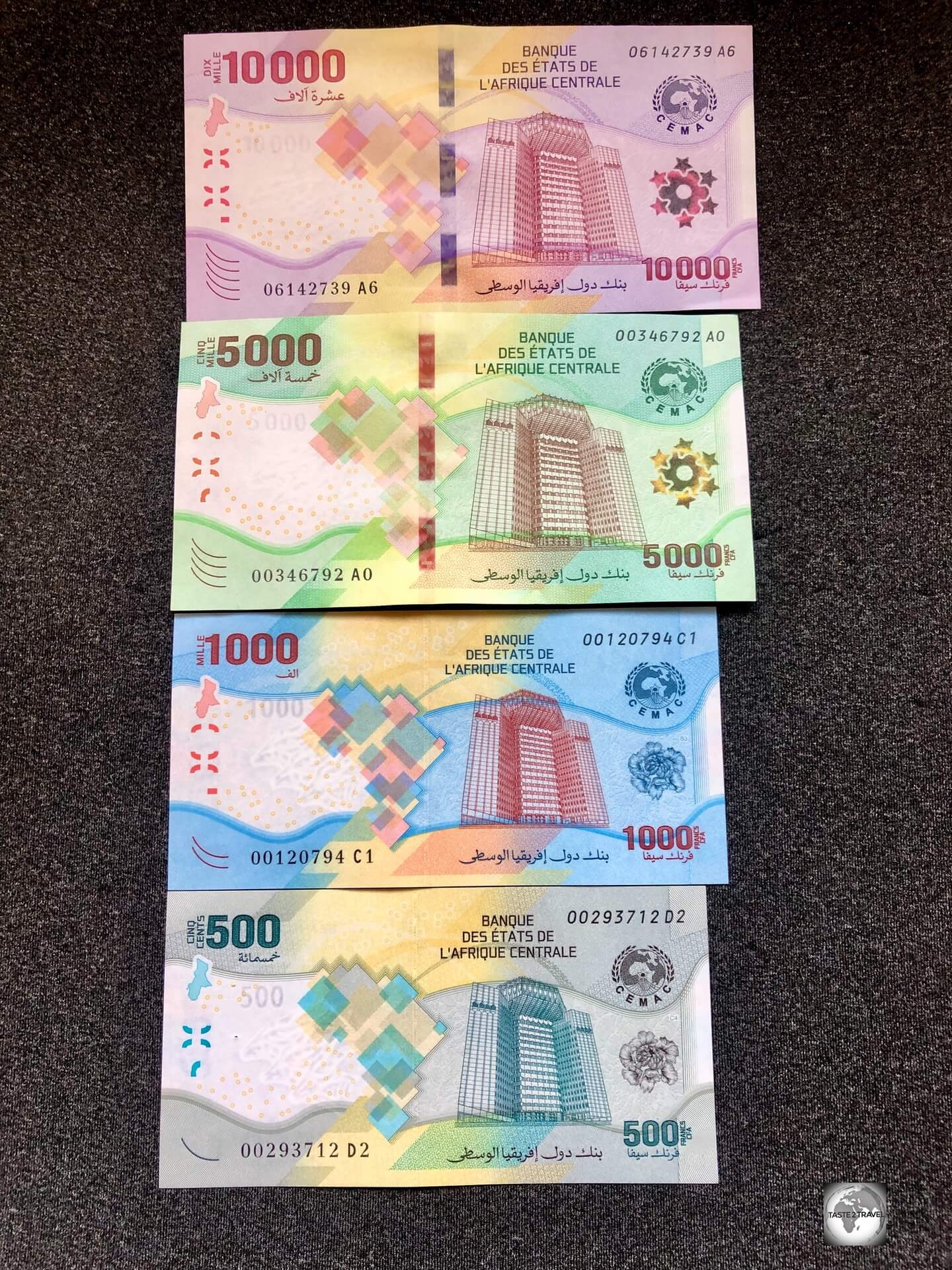
Almost a full set of (uncirculated) CFA franc banknotes – with the 2,000 missing!
Credit Cards
Like almost all other African countries, cash is king in Central African Republic with credit cards rarely accepted.
It is advisable to have some local currency on hand for all transactions, as well as Euros for larger purchases or in case of emergencies.
ATMs
ATMs are available in Bangui, where you can withdraw cash using international debit or credit cards at any Eco Bank ATM.
Conveniently, there is an Eco Bank ATM located in the lobby of the Ledger Plaza Hotel.
Money Exchange
Money exchange is available at the Lebanese-owned Bangui Mall which is located on Av. de I’Independance.
Contact Details for Bangui Mall
- Email: Info@banguimall.net
- Telephone: +236 70400400 / +236 70900090 / +236 72900900
Costs
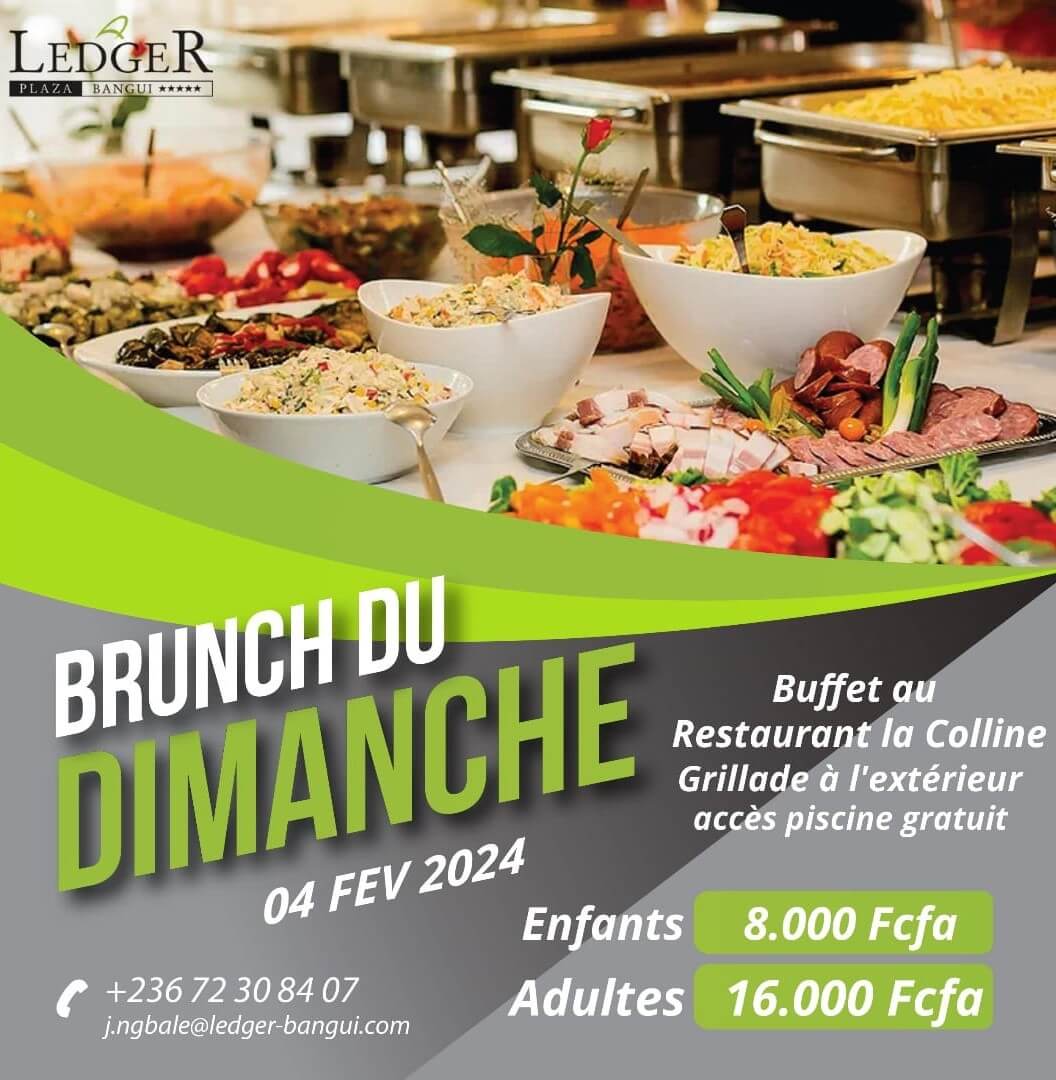
Sunday Brunch at the Ledger Plaza Bangui costs XAF 16,000 per adult.
Source: Ledger Plaza Bangui.
Like most other countries in Central Africa, especially the former French colonies in the CFA currency zone, travel costs in the CAR are not cheap with flight tickets on the limited airlines, and hotel beds in the limited hotels, all being sold at a premium.
Overall Budget: For a mid-range traveller, expect to spend at least $150-$300 per day, and potentially much more.
Factors like the duration of the trip, the type of accommodation chosen, and the frequency of dining at restaurants will all impact the total cost.
Sample costs:
- Cappuccino at the Ledger Plaza Bangui Hotel: XAF 2,000 (US$3.50)
- Bottle (.33l) of Coke/ Sprite: XAF 1,000 (US$1.73)
- Small bottled water: XAF 1,000 (US$1.73)
- Bottle of Beer: XAF 2,000 (US$3.50)
- Inexpensive meal at a local restaurant: XAF 3,000 (US$5.20)
- Sunday buffet lunch at the Ledger Plaza Bangui Hotel: XAF 16,000 (US$27.70)
- Standard hotel room at the Ledger Plaza Bangui Hotel: €210 (US$238)
Tour Guide/ Fixer
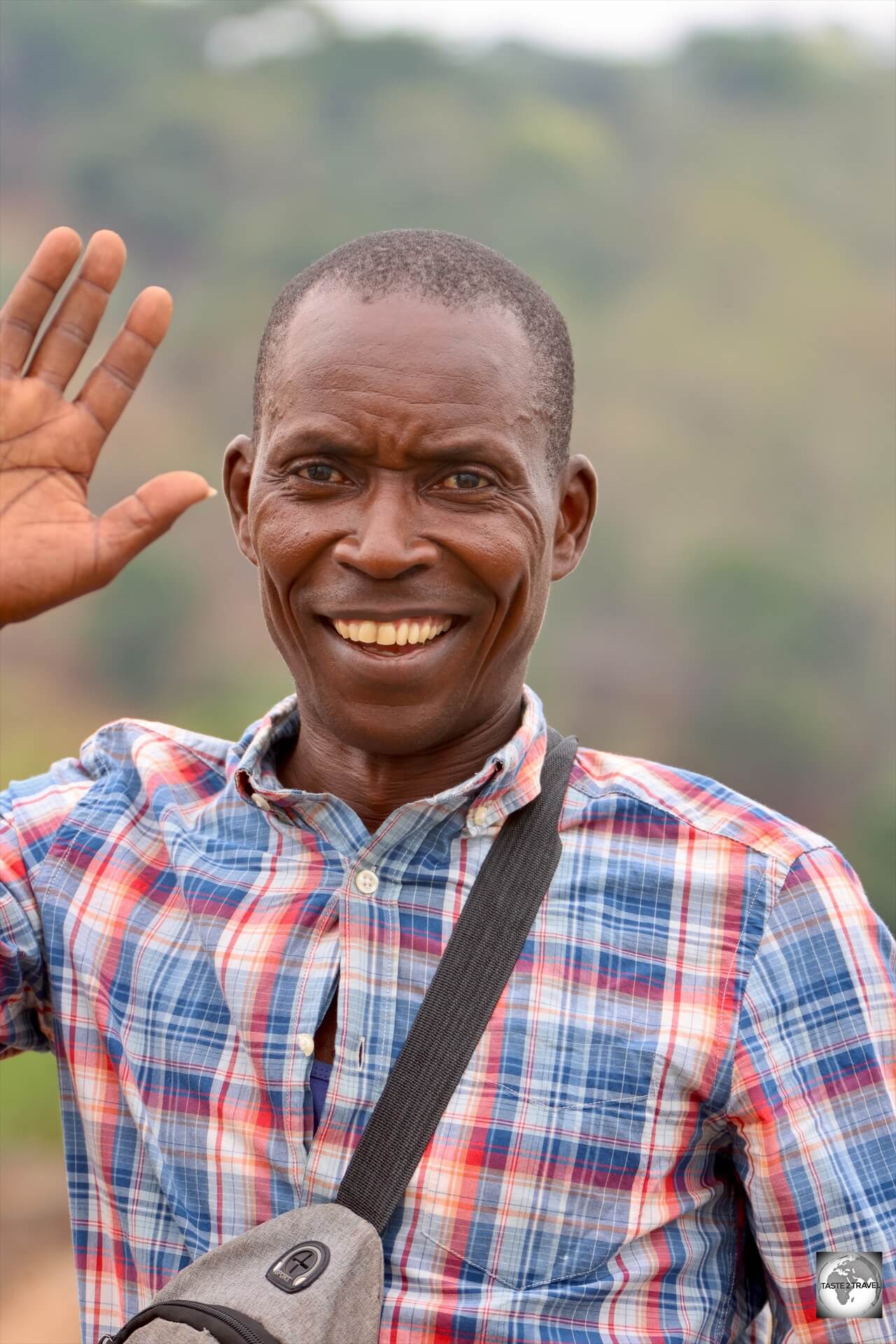
My tour guide in the CAR was Steve Whulmer Abraham Yandault, who is the owner of Sway Tour in Bangui.
I travelled to the Central African Republic as part of a group tour organised by Harry Mitsidis, the founder of Nomad Mania.
I normally travel solo, and of the 245 countries and territories which I have visited, this was only the 2nd time I have travelled as part of a group, the other being a 10-day tour of North Korea (DPRK) where one must travel on a group tour.
You can read more about my DPRK trip in my North Korea Travel Guide.
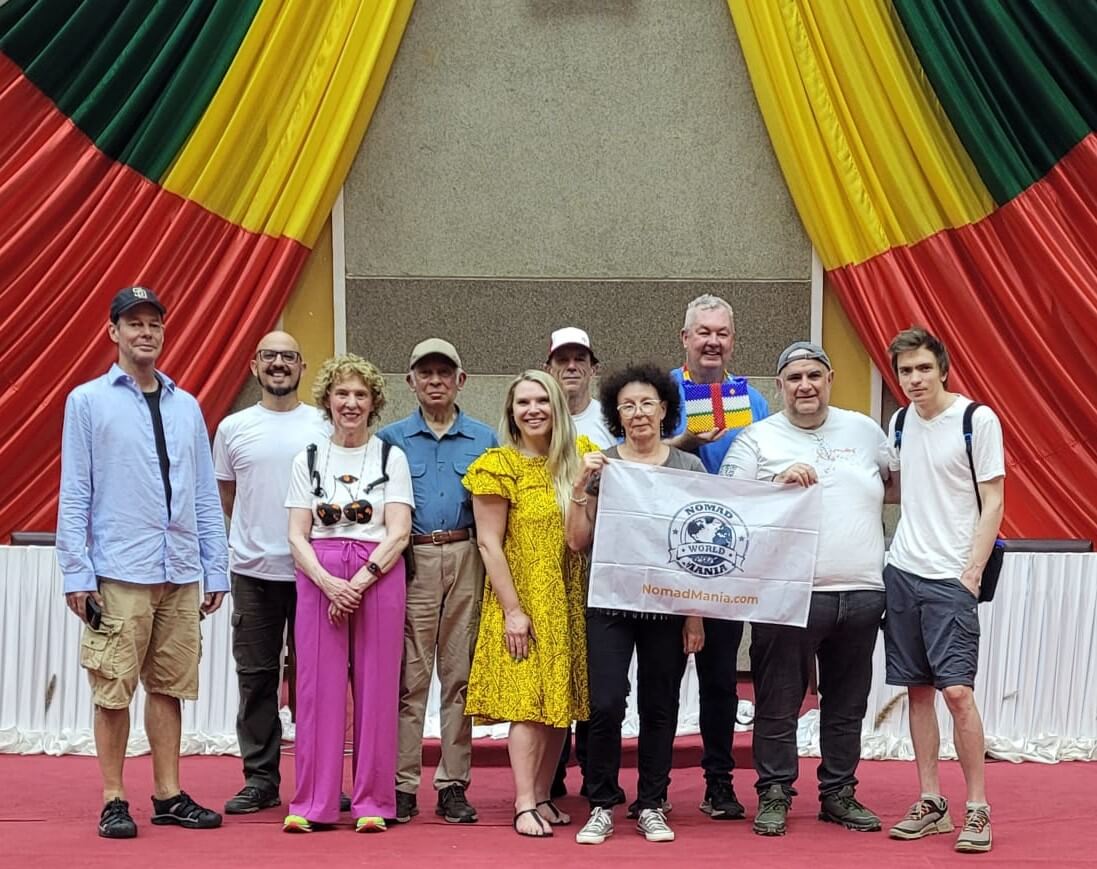
I travelled to the Central African Republic with nine other Nomad Maniacs as part of a tour organised by Harry Mitsidis, the founder of Nomad Mania.
All ground arrangements were handled by our trusty guide, Steve Whulmer Abraham Yandault, who is the owner of Sway Tour in Bangui.
Steve speaks limited English and is clearly much more comfortable conversing in French.
If you wish to plan a trip to the Central African Republic, Steve can organise a tour and the all-important Message Porte, a letter of invitation (LOI), which allows you to collect your visa on arrival at Bangui Airport.
Contact details for Steve Whulmer Abraham Yandault at Sway Tour:
- Address: Sway Tour, Avenue Barthelemy Boganda, pk0 Bangui, Central African Republic
- Email: swaytour@gmail.com
- WhatsApp: +23675509486
- WhatsApp (Business): +23672509486
- Facebook: https://www.facebook.com/people/Sway-Tour/100091338070347/?_rdr
- LinkedIn: https://www.linkedin.com/in/sway-tour-travel-and-tourism-agency-430310331/?originalSubdomain=cf
Sightseeing
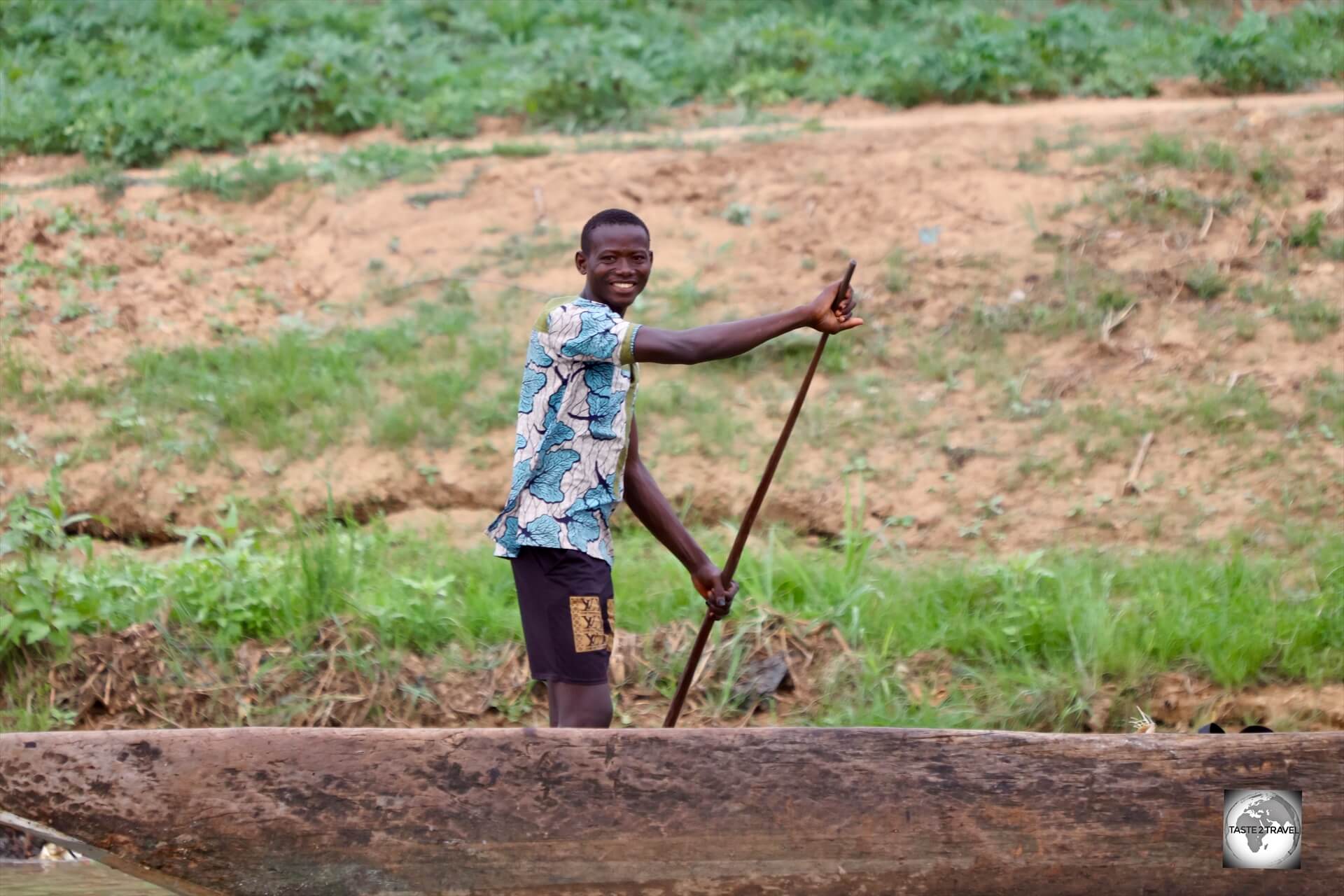
A highlight of Bangui, the Ubangi River is a significant waterway throughout Central Africa, which eventually flows into the Congo River.
Bangui
Notre-Dame of Bangui Cathedral
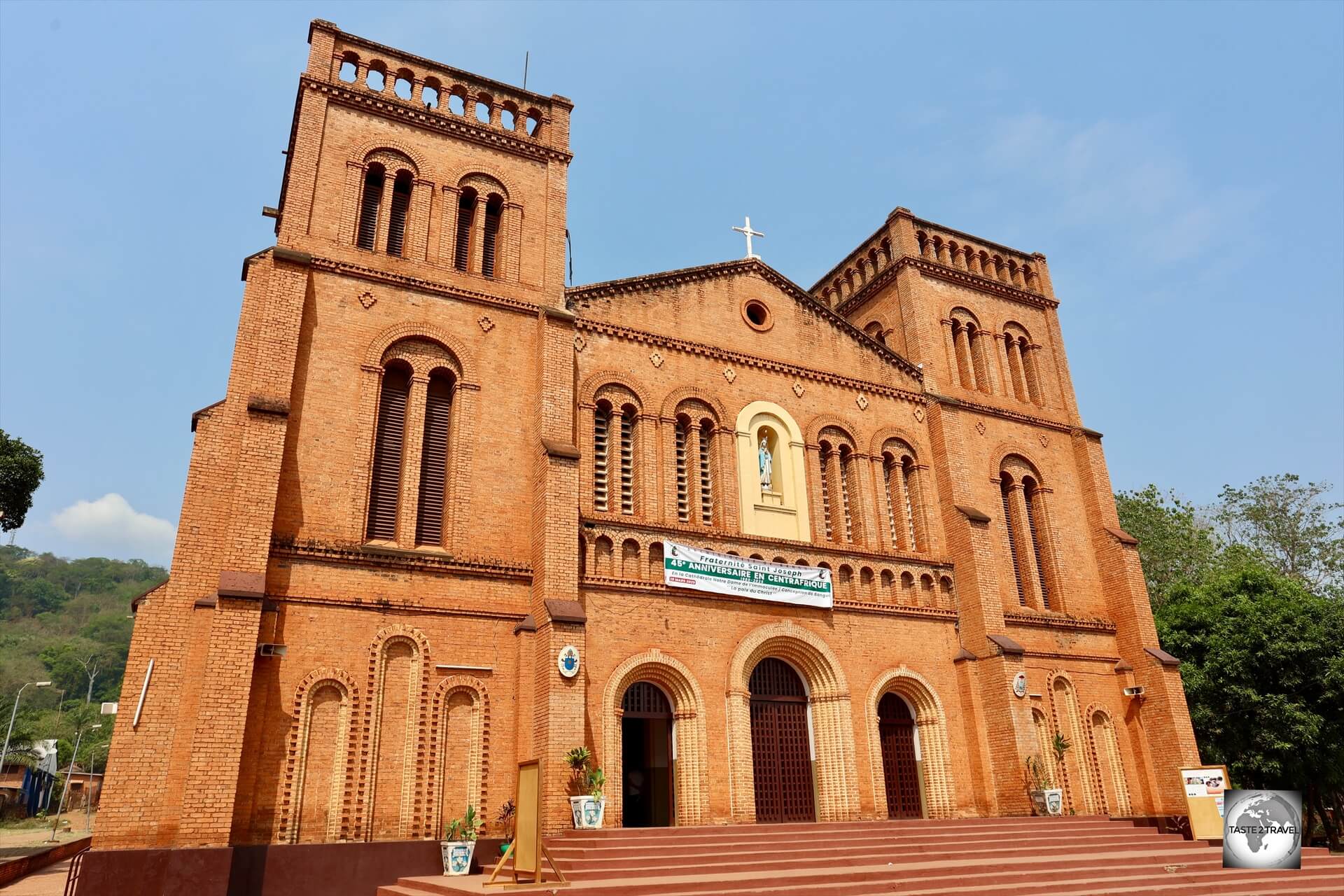
Blending European and Central African architectural influences, the Notre-Dame of Bangui Cathedral is a Roman Catholic cathedral located in the heart of Bangui.
Built in the early 1900s from locally fired bricks, the Notre-Dame of Bangui Cathedral is a large red brick church built in the French colonial style.
The Central African Republic is home to an estimated 2.9 million Christians today, about a third of whom are Roman Catholic.
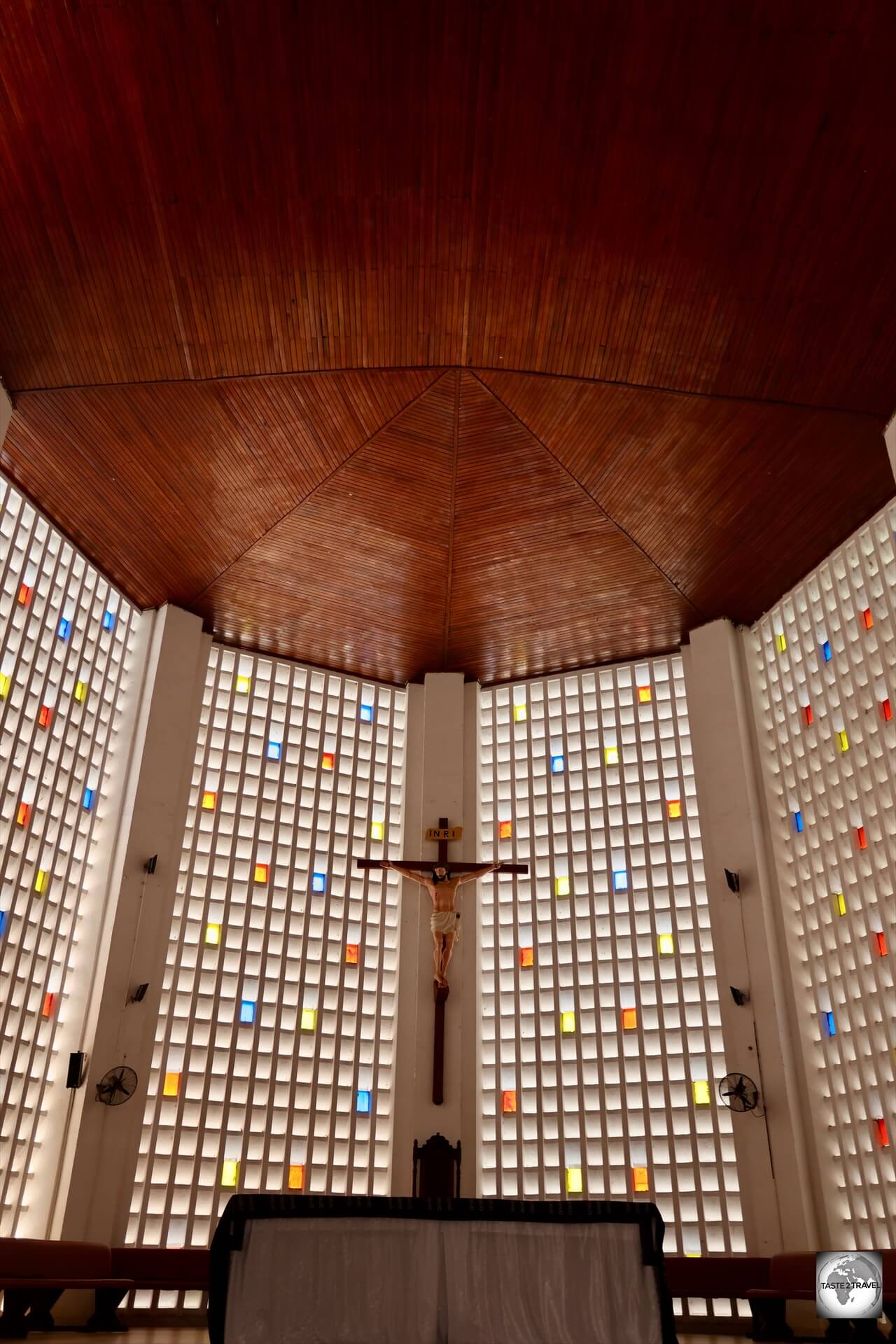
The interior of the Notre-Dame of Bangui Cathedral features a crucifix and four massive windows featuring coloured glass.
Since declaring independence from France in 1960, the Central African Republic has experienced a series of conflicts.
Political unrest in the 1990s prompted then-Archbishop Joachim Ndayen to begin hosting peace talks at the cathedral in 1996.
Later in 1999, Pope John Paul II visited Bangui and spoke about the “difficult and complex situation” facing the country.

In November 2015, Pope Francis visited the cathedral as well as the nearby Grande Mosquée de Bangui.
In November 2015, Pope Francis visited the cathedral as well as the nearby Grande Mosquée de Bangui, offering a message of peace and resilience.
Assemblée Nationale
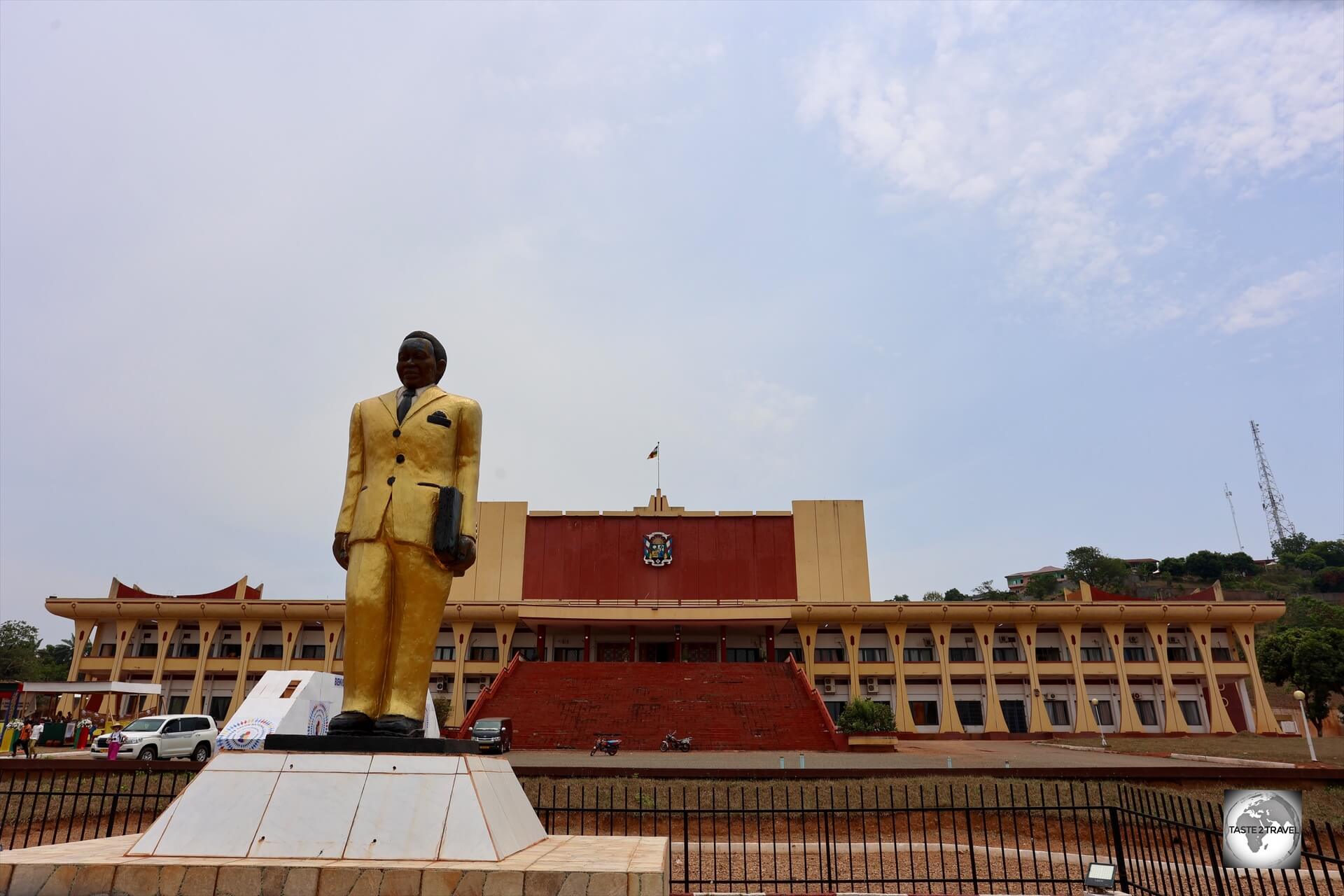
A statue of Barthélemy Boganda, an independence activist, and the first Premier of the Central African Republic, stands outside the National Assembly building in Bangui.
The Assemblée Nationale (National Assembly) is the lower house of the Parliament of the Central African Republic.
The first legislative arm was established in January 1947, however, due to wars, coups and political upheaval over the years, the parliament has experienced great change.

Two giant Central African Republic flags decorate the front wall of the National Assembly chamber.
The current National Assembly was founded on the 27th of March 2016, following the ratification of a new Constitution of the Central African Republic.
A total of 140 members, who serve five-year terms, are elected in single-member constituencies.
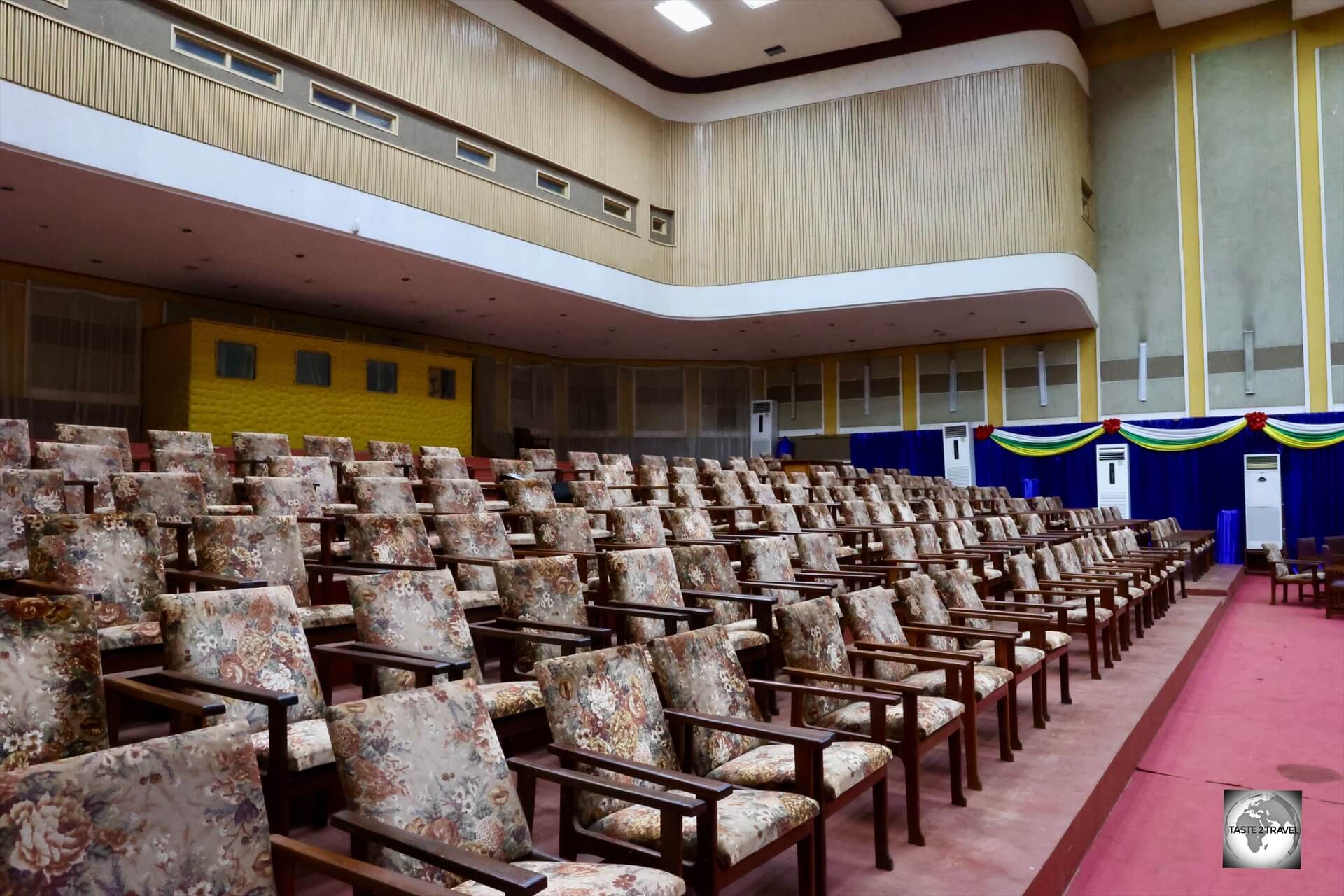
The 140-seat National Assembly is the lower house of the Parliament of the Central African Republic.
The largest party, with 40 seats, is the United Hearts Movement, which was formed in November 2018 as a political association by President Faustin-Archange Touadéra.
The Senate was abolished upon the adoption of the 2023 constitution, and the National Assembly became the sole chamber of the unicameral legislature.
Centre Artisanal de Bangui
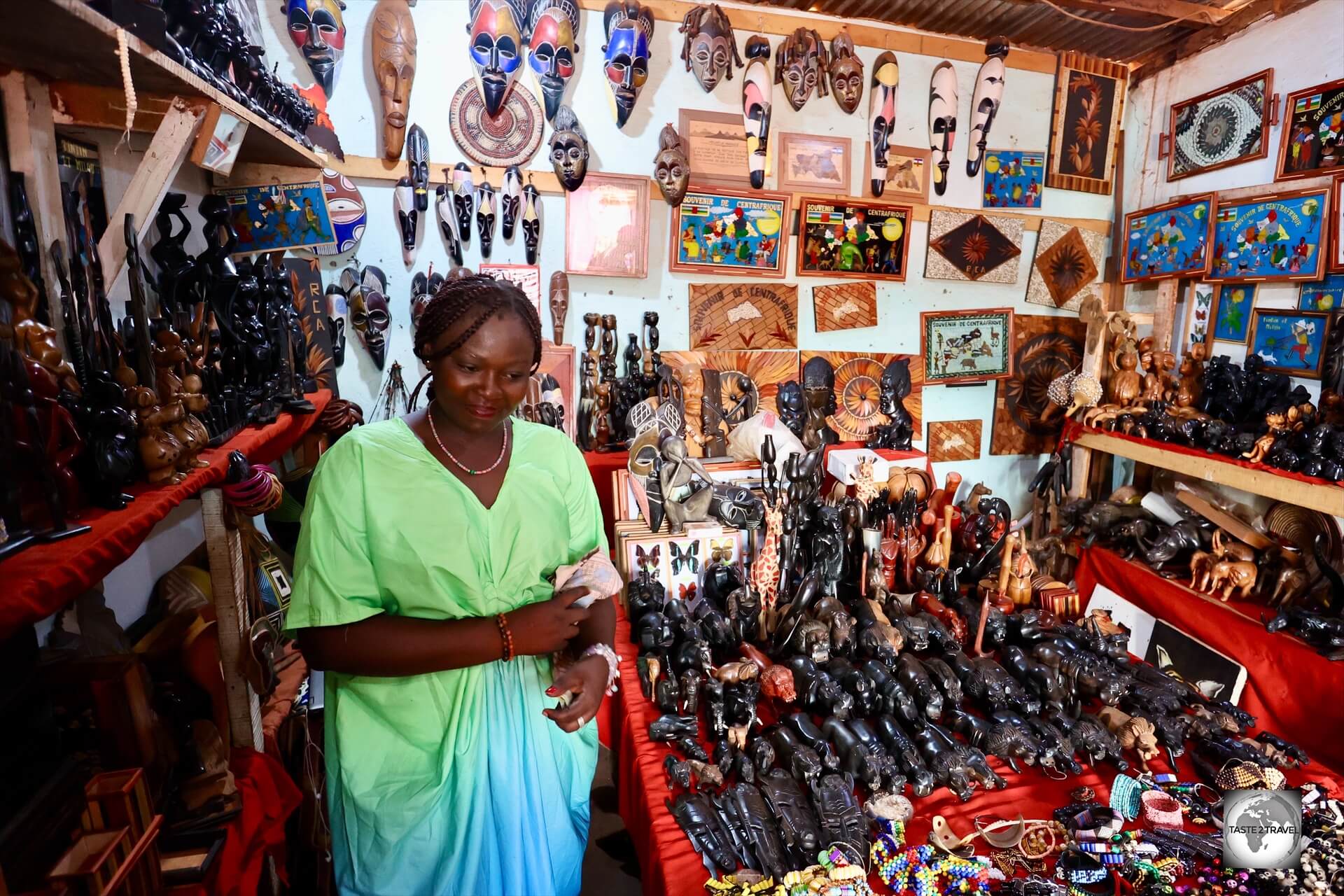
An Aladdin’s cave of handmade souvenirs at the Centre Artisanal (Artisanal Market) in Bangui.
A great place to purchase souvenirs of the Central African Republic is the Centre Artisanal (Artisanal Market) in downtown Bangui where a collection of small shops is arranged around a compound.
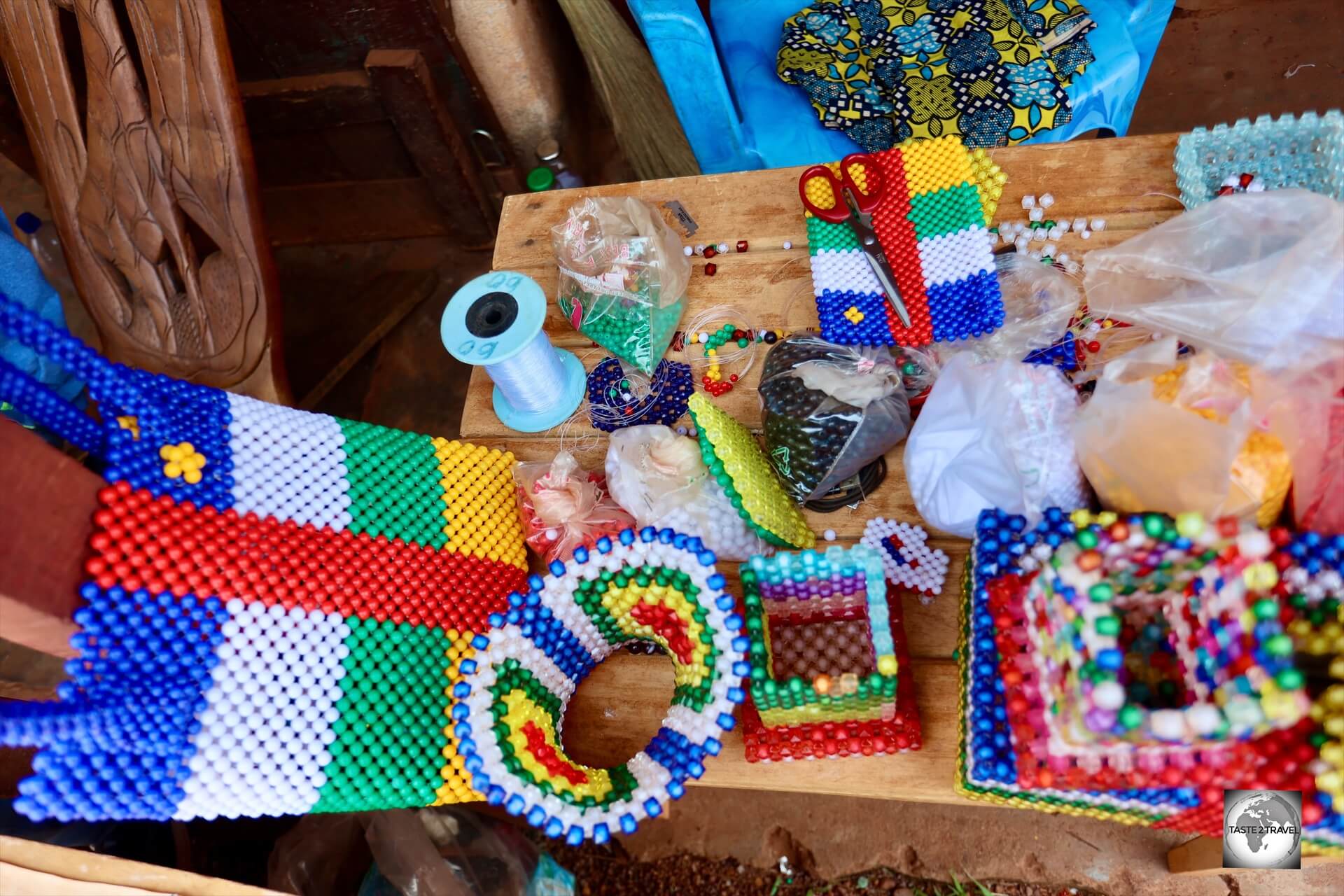
Bead work souvenirs at the Centre Artisanal are very popular, especially those which depict the national flag of the CAR.
These shops are brimming with handmade arts and crafts which are offered at very reasonable prices, although bargaining is essential.
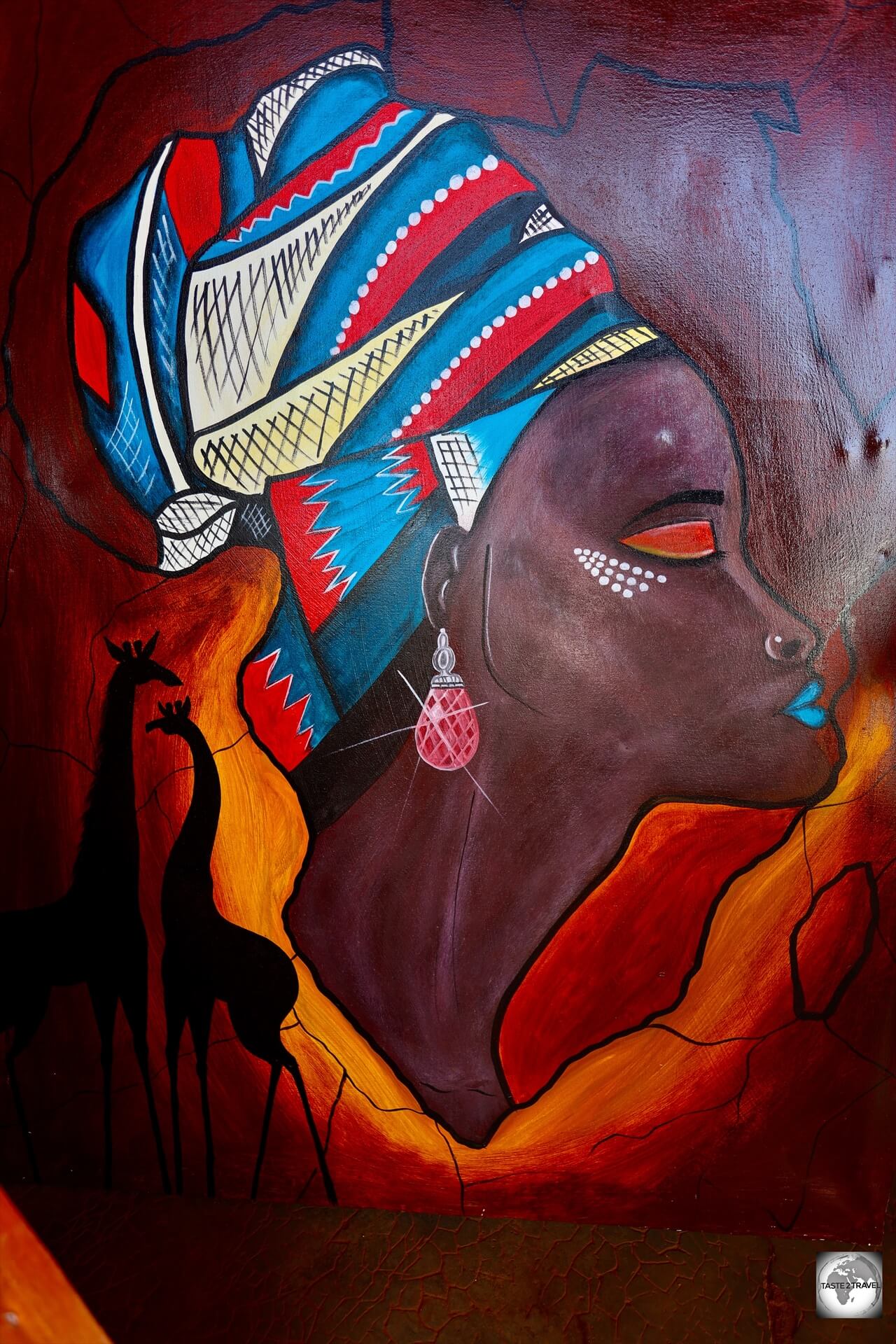
Artwork for sale, at the Artisanal Market in Bangui.
Jardin du Cinquantenaire
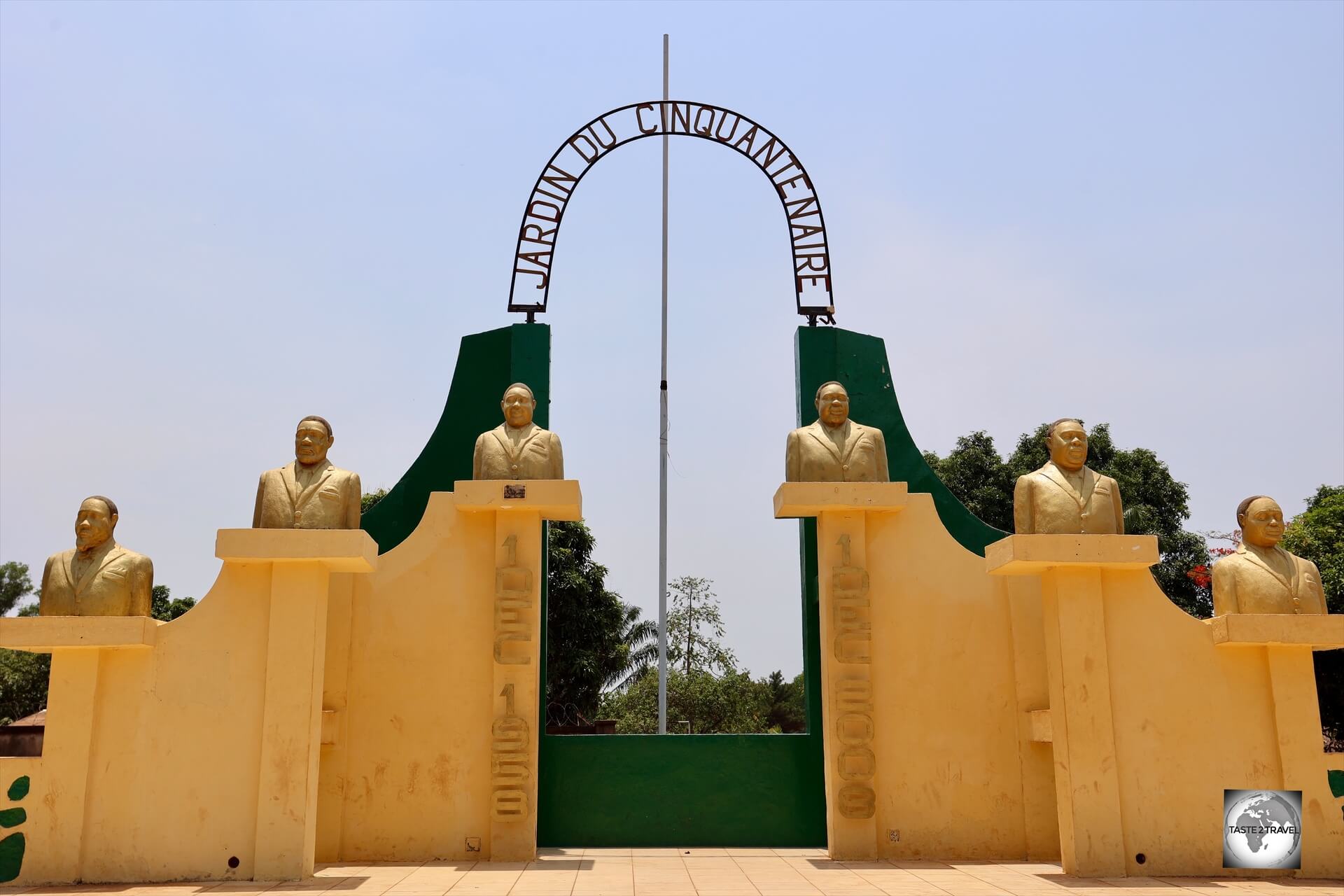
The “Jardin du Cinquantenaire” celebrates 50 years of CAR independence, from the 1st of December 1958 to the 1st of December 2008.
The Jardin du Cinquantenaire (50th Anniversary Garden) is a significant public space in downtown Bangui.
The garden, which was created in 2008, on the occasion of the country’s 50th anniversary of independence from France, serves as both a commemorative site and a recreational space for the residents of Bangui and visitors.
At the centre of the park is a monument which was constructed to celebrate the 50th anniversary of the independence of the Central African Republic, marking an important milestone in the country’s history.
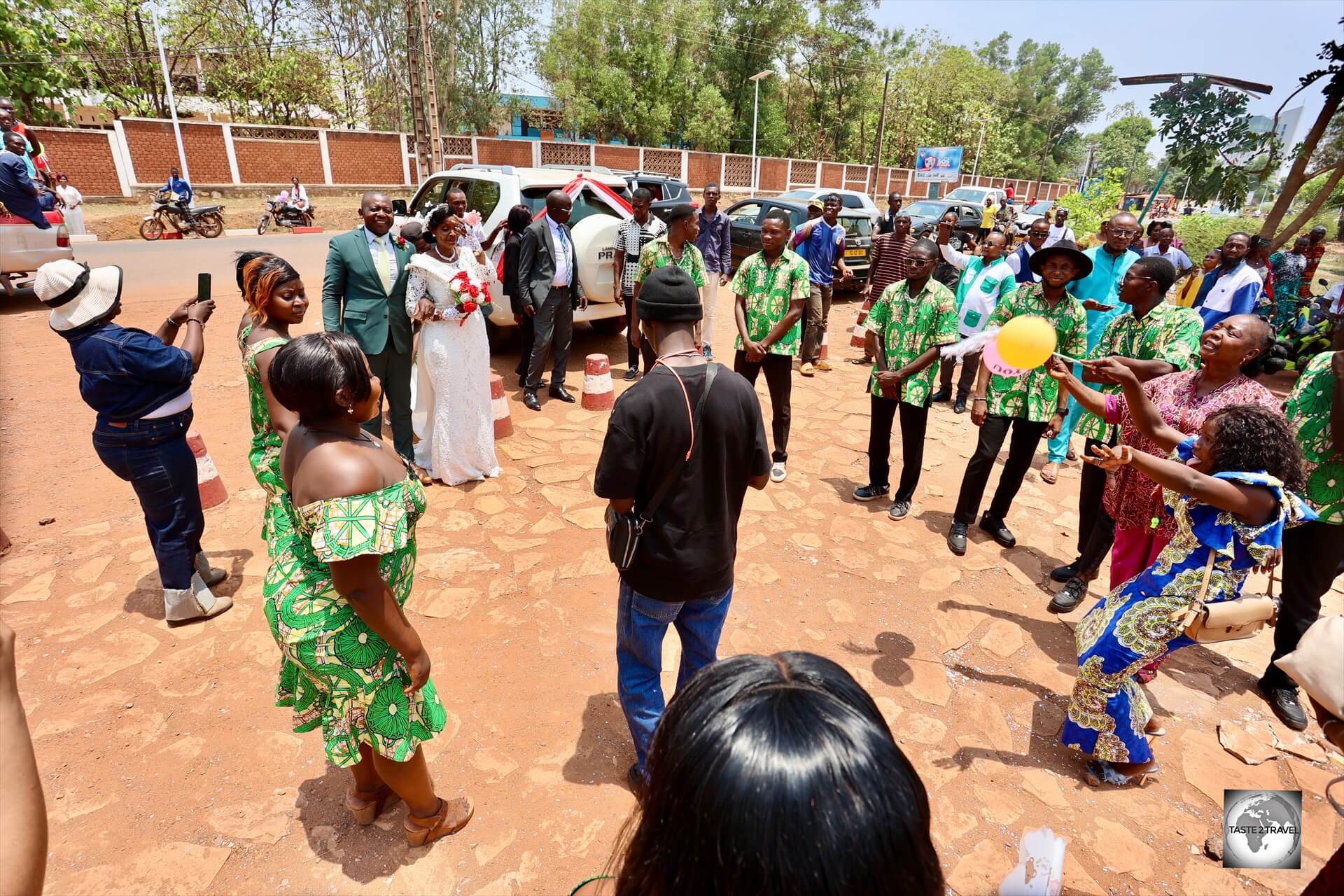
The “Jardin du Cinquantenaire” is a popular stop for wedding photos.
The monument is often seen as a cultural landmark, a place where people can gather to reflect on the country’s history and look forward to the future.
It is also a popular photo stop for newlyweds with one wedding party arriving just as we were visiting.

This mother and daughter were part of the wedding party which stopped for photos at the “Jardin du Cinquantenaire”.
Ndara Boutique
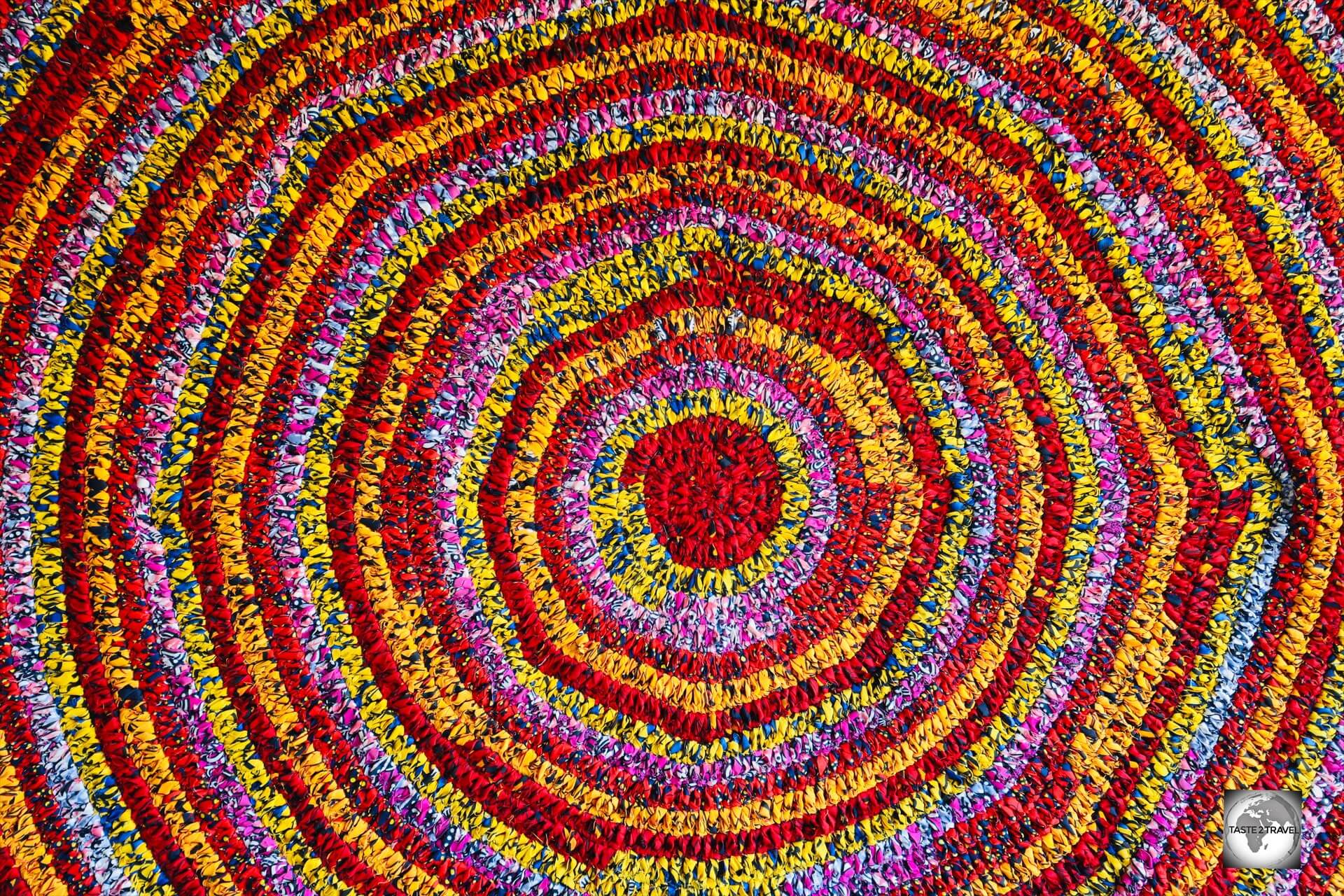
A stunning rug, braided using local fabric, which was made by the talented artisans at Ndara.
A home-grown success story, Ndara was created by Charlotte, a native of the Central African Republic who wanted to empower local women, by training them to become artisans and business managers.

The Ndara Boutique in Bangui sells a range of beautiful, hand-made, gifts all of which are made by the Ndara artisans.
Ndara means ‘to be skilled’ in Sango, the national language of the Central African Republic.
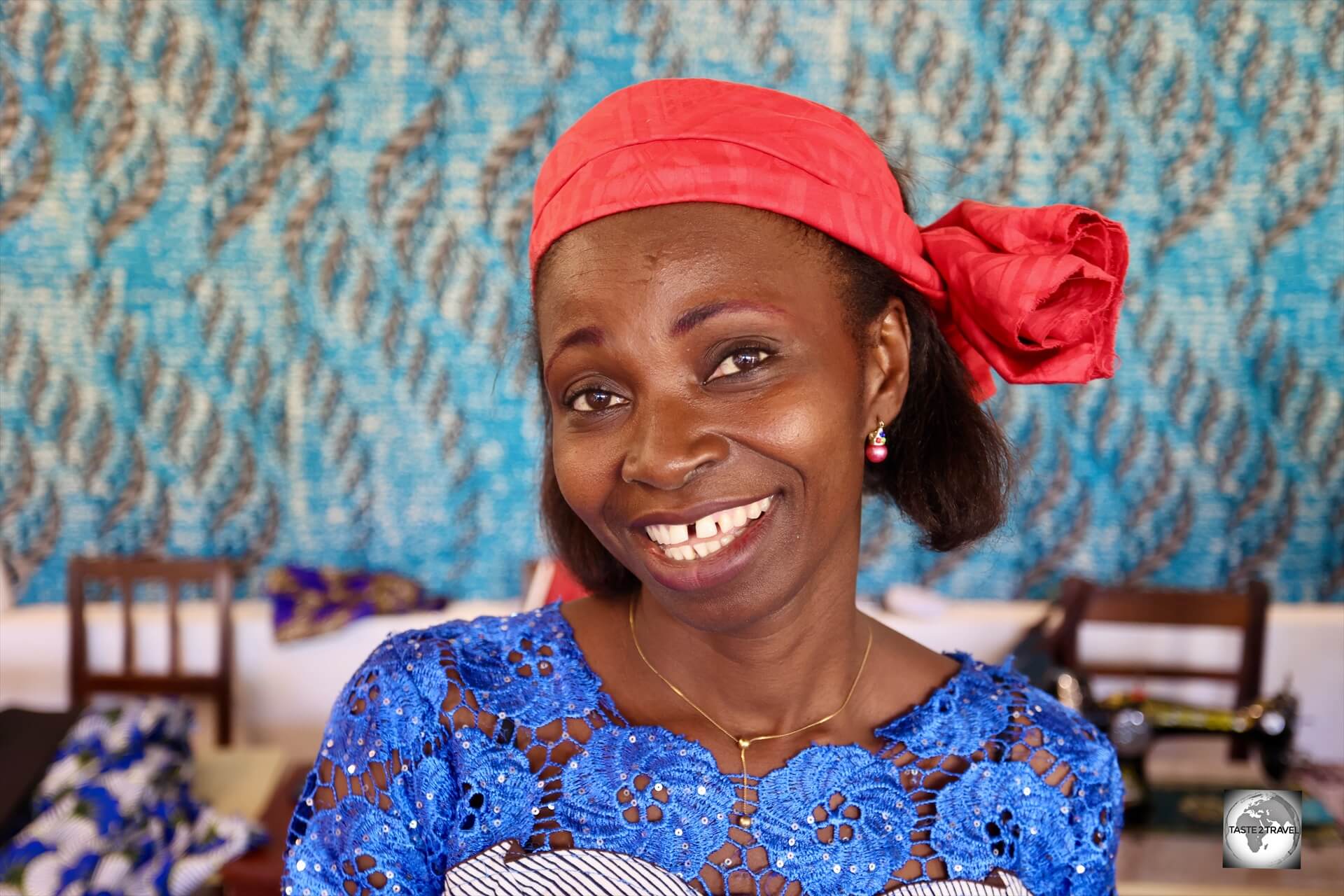
One of the friendly team members at Ndara, where 14 local artisans work full-time.
Ndara grew organically and today, five and a half years after its creation, Ndara employs 14 artisans full time, has a permanent workshop and has opened up a boutique in Bangui.
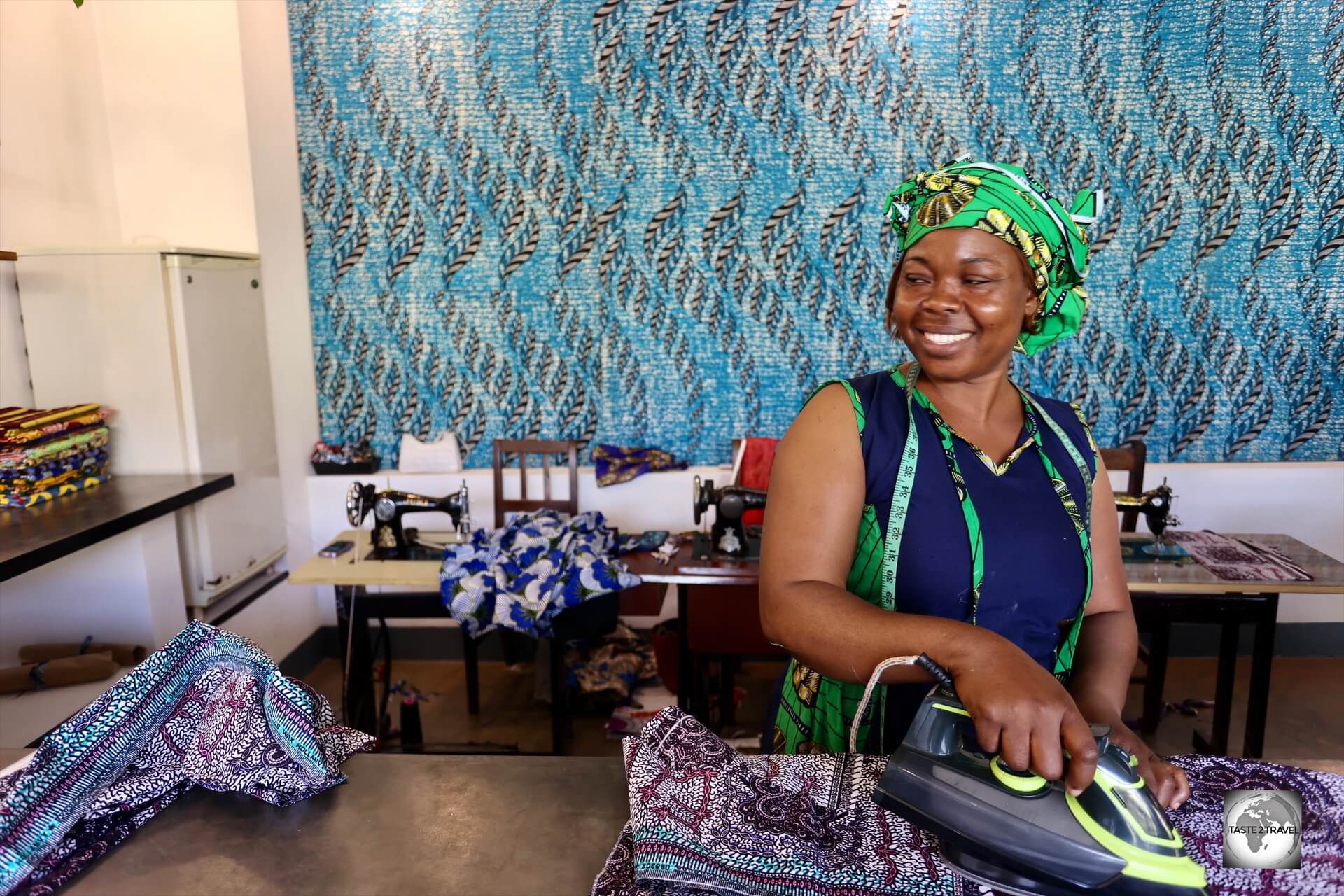
One of 14 female artisans at Ndara, who have been trained to manage the operation of the boutique.
Thanks to weekly classes in literacy, math and leadership, the female artisans, who could not read and write when they joined Ndara, now manage the operation of the boutique.
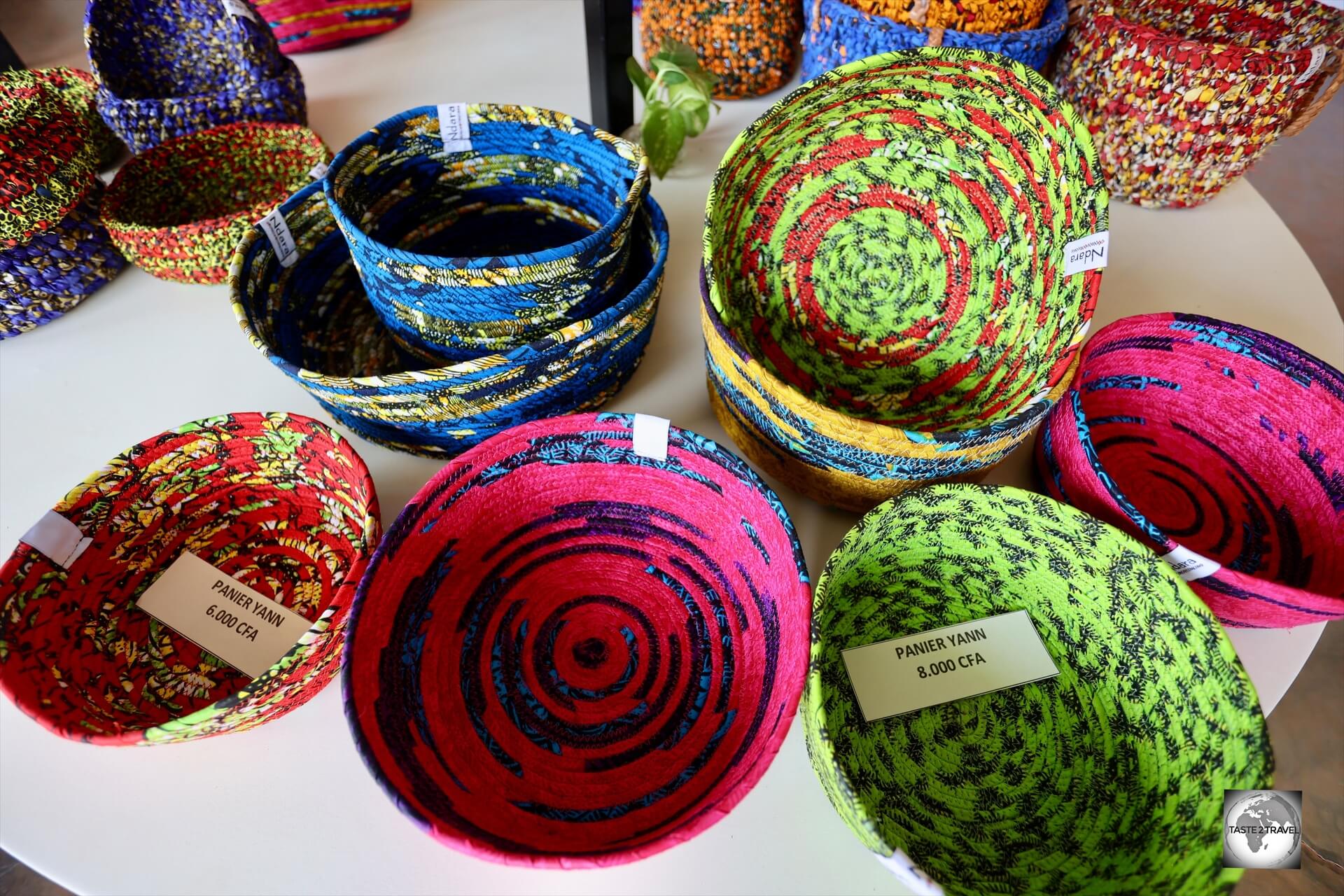
Colourful, hand-woven, baskets for sale at the Ndara Boutique in Bangui.
The boutique is fully managed by the local Ndara team and offers a range of stunning gift items which make for memorable souvenirs.
Ndara Online Shop
Items can be purchased online though the giftshop at: https://ndaratibeafrika.com/collections/all-products-1
Ndara Contact Details
- Website: https://ndaratibeafrika.com/
- Email: info@ndaratibeafrika.com
- Instagram: https://www.instagram.com/ndaratibeafrika/
- Facebook: https://www.facebook.com/ndaratibeafrika
Ubangi River
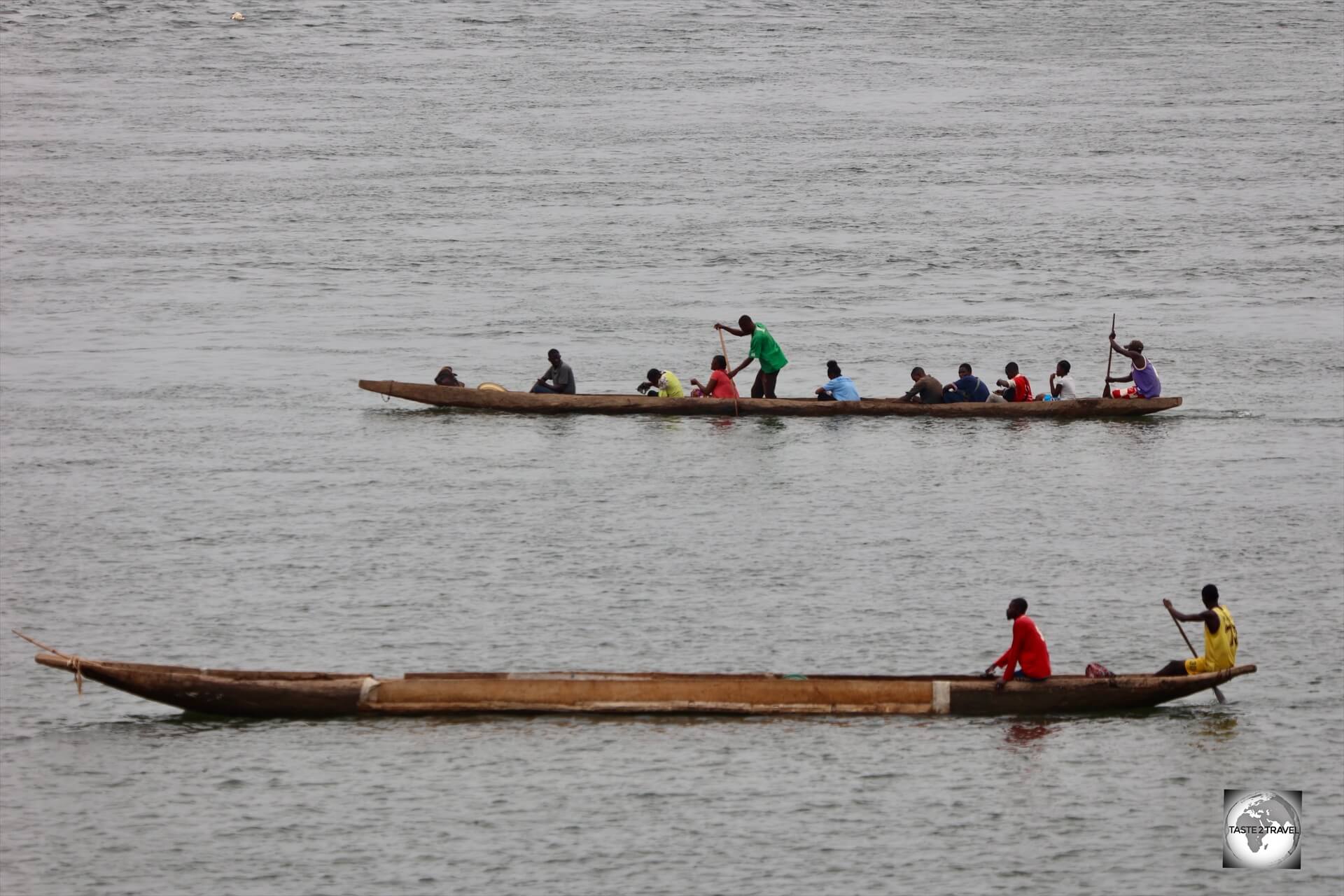
Bangui is located on the Ubangi River, which forms the border between CAR and DRC.
The Ubangi River, also known as the Oubangui, is a major river in Central Africa and the largest right-bank tributary of the Congo River.
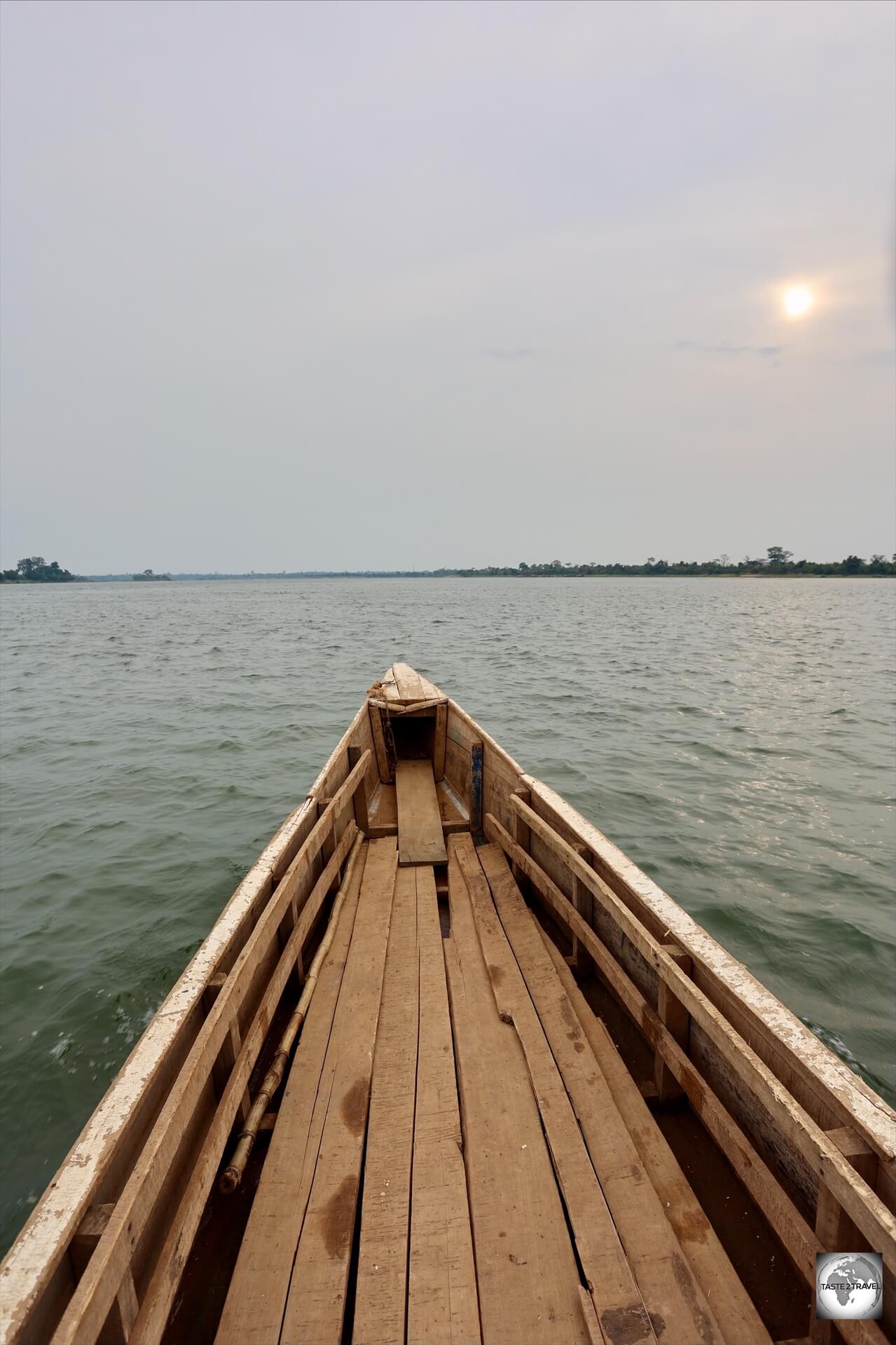
A sunset cruise on the Ubangi River.
The river flows through Bangui, before joining the Congo River.
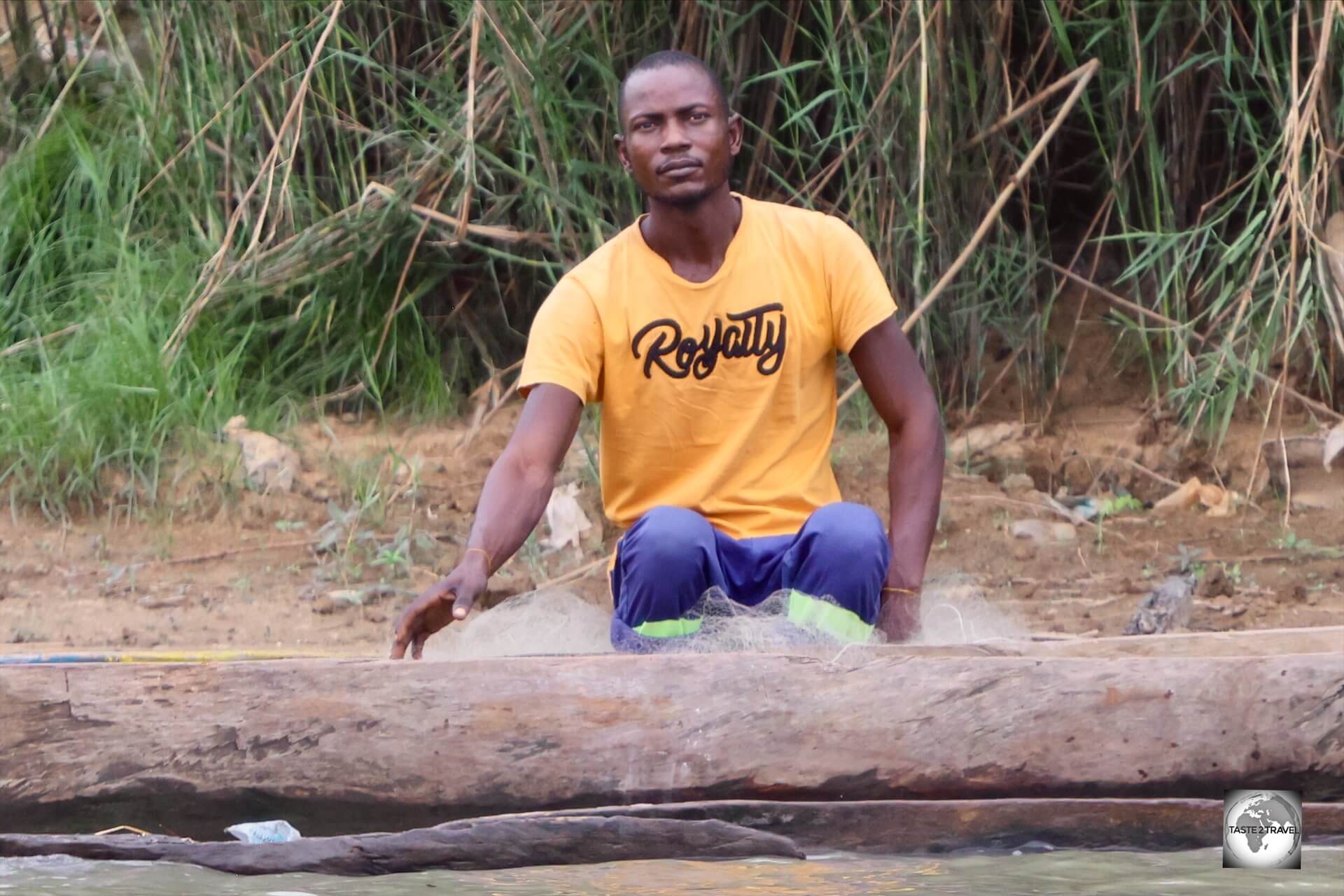
A fisherman on the banks of the Ubangi River.
The Ubangi River is a significant waterway for transportation and is also a source of water for the local population.
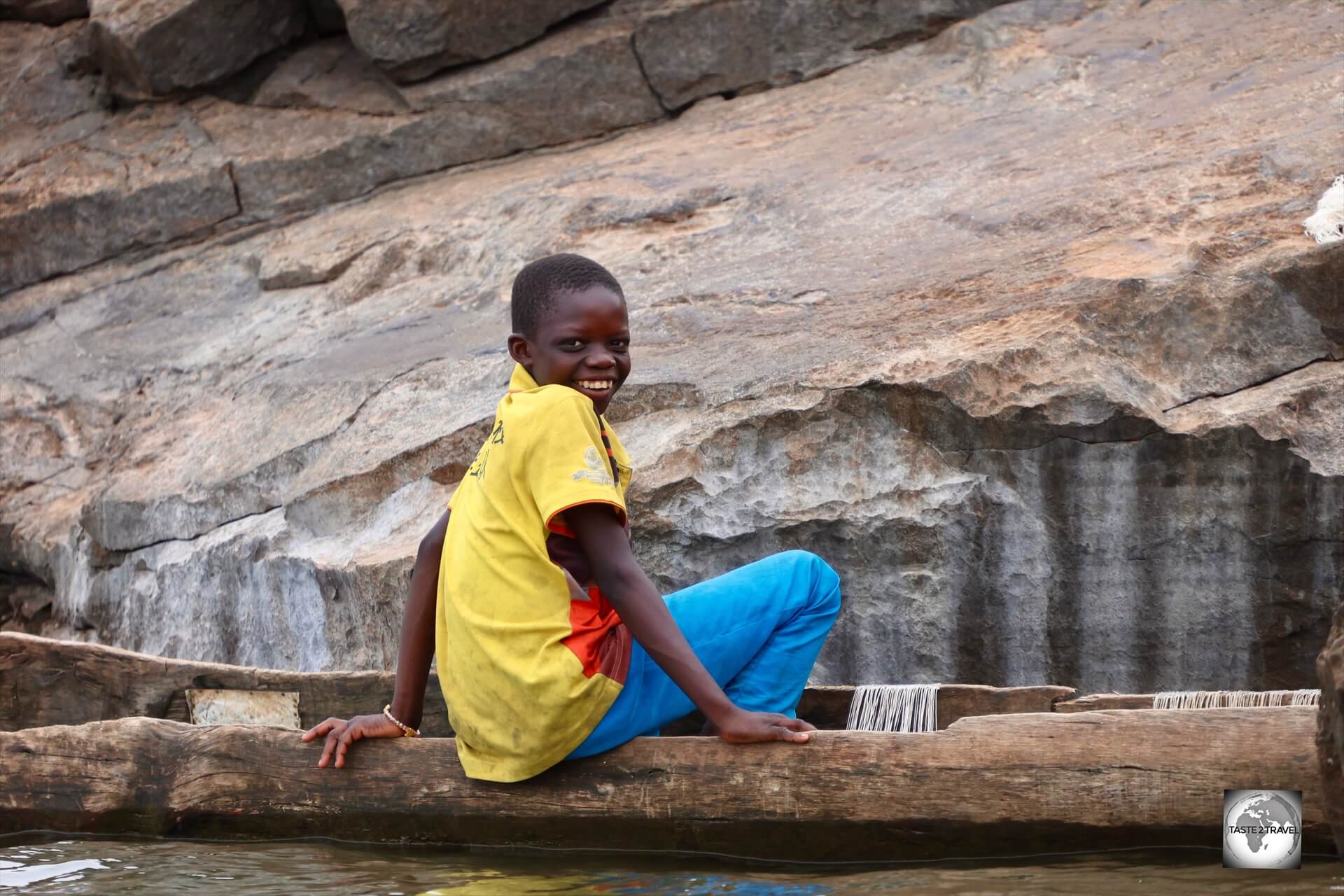
A young fisherman on the Ubangi River.
With a length of about 1,060 km (660 mi), the Ubangi flows west through Central Africa, forming the border between Central African Republic (CAR) and the Democratic Republic of the Congo (DRC).

Bathing in the Ubangi River.
The navigable Ubangi River turns sharply south below Bangui and connects to the Congo River just south of the equator near Brazzaville as its chief northern tributary.
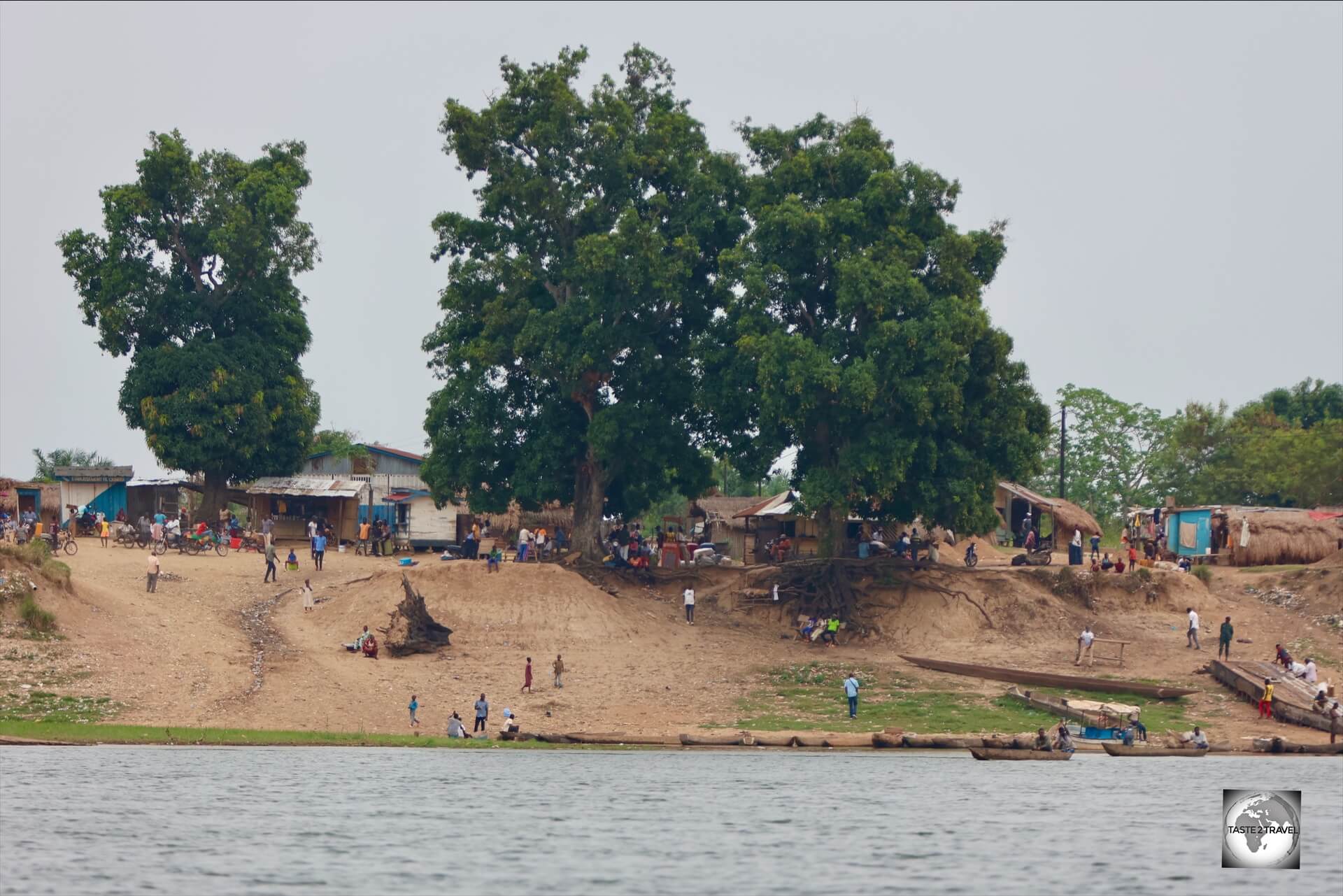
A view of a village, on the DRC side of the Ubangi River.
Directly opposite Bangui is the DRC city of Zongo, which is part of the DRC province of Sud-Ubangi Province.
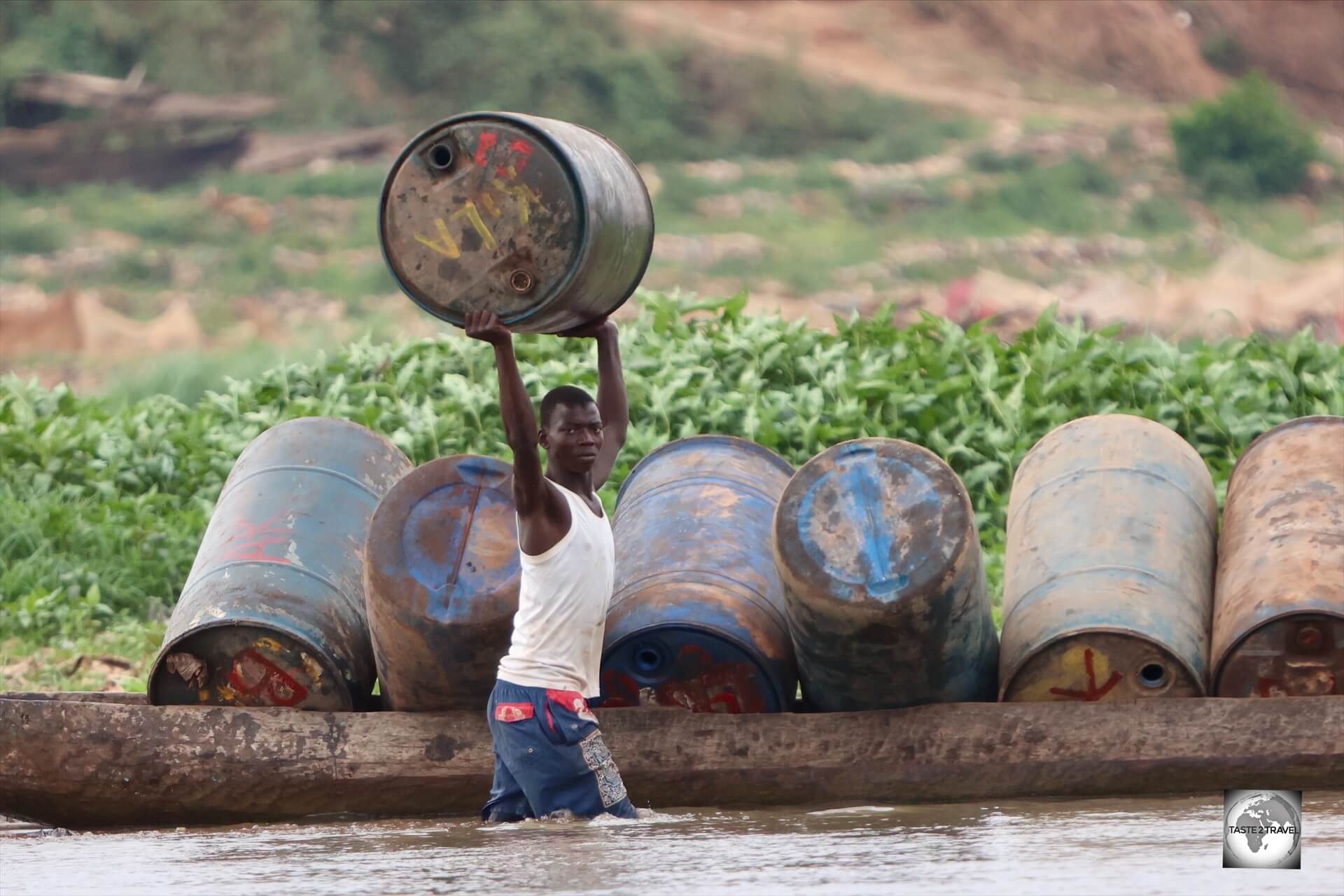
As it forms a border between two countries, there is lots of commercial activity on the Ubangi River.
As part of our trip to Bangui, we did a sunset river cruise on the Ubangi, in a wooden piroque.

Wooden pirogues are the most popular form of transport on the Ubangi River.
Camp île Bongo Soua
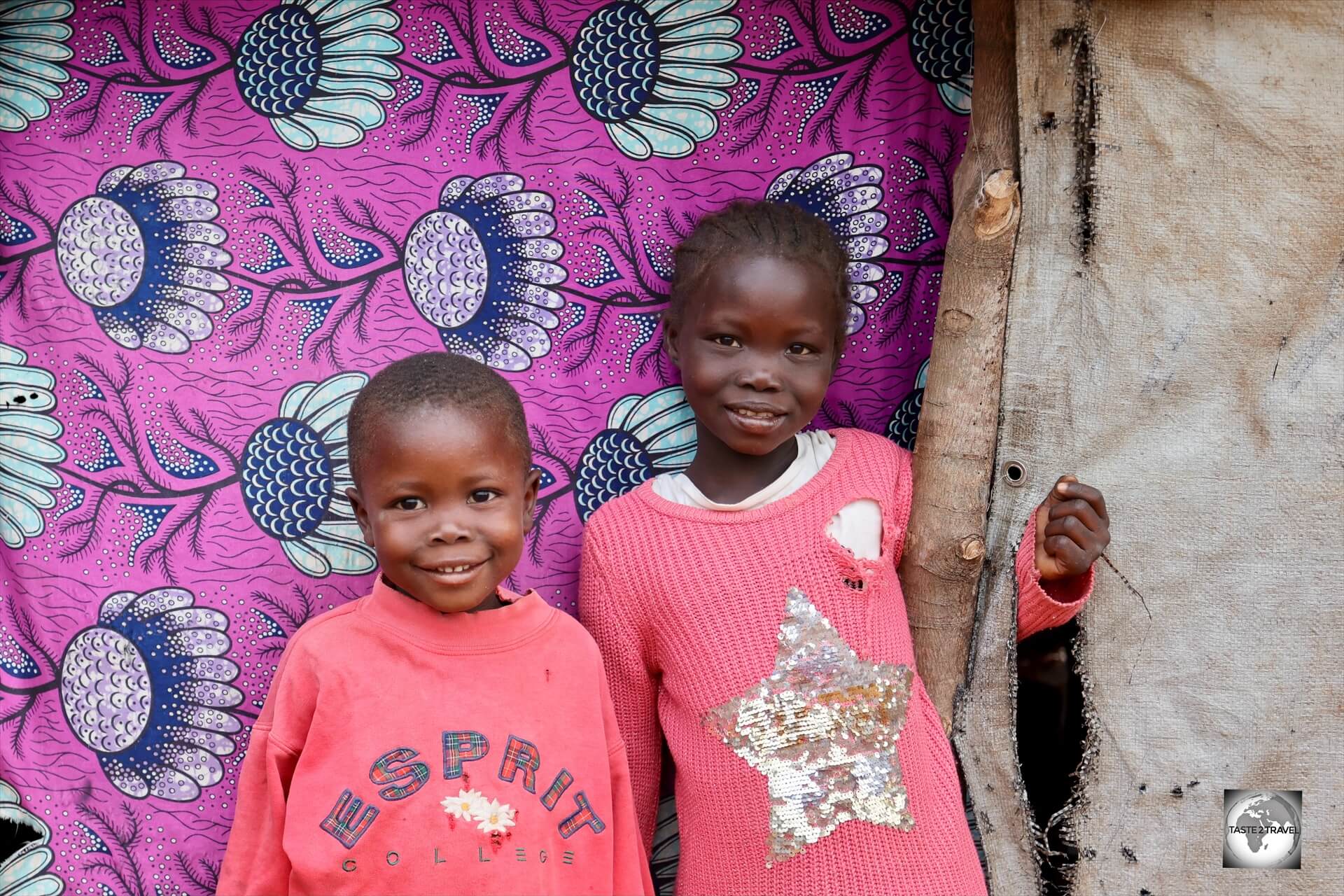
The friendly inhabitants of “Camp île Bongo Soua”, a refugee camp on the banks of the Ubangi River.
A highlight of our sunset river cruise on the Ubangi River was a visit to “Camp île Bongo Soua” (Bongo Soua Island Refugee Camp).

The refugees at “Camp île Bongo Soua” were made homeless when flood waters washed their homes away on nearby Bongo Soua Island.
The friendly and welcoming inhabitants of this riverside refugee camp used to live in houses on nearby Bongo Soua Island, which is located in the middle of the river, directly across from the refugee camp.

The United Nations has provided tarpaulin sheets which has allowed the refugees to build basic shelters which overlook their former island home (background).
The capital city of Bangui, and surrounding areas, have been particularly affected by floods, often due to the overflow of the Ubangi River.
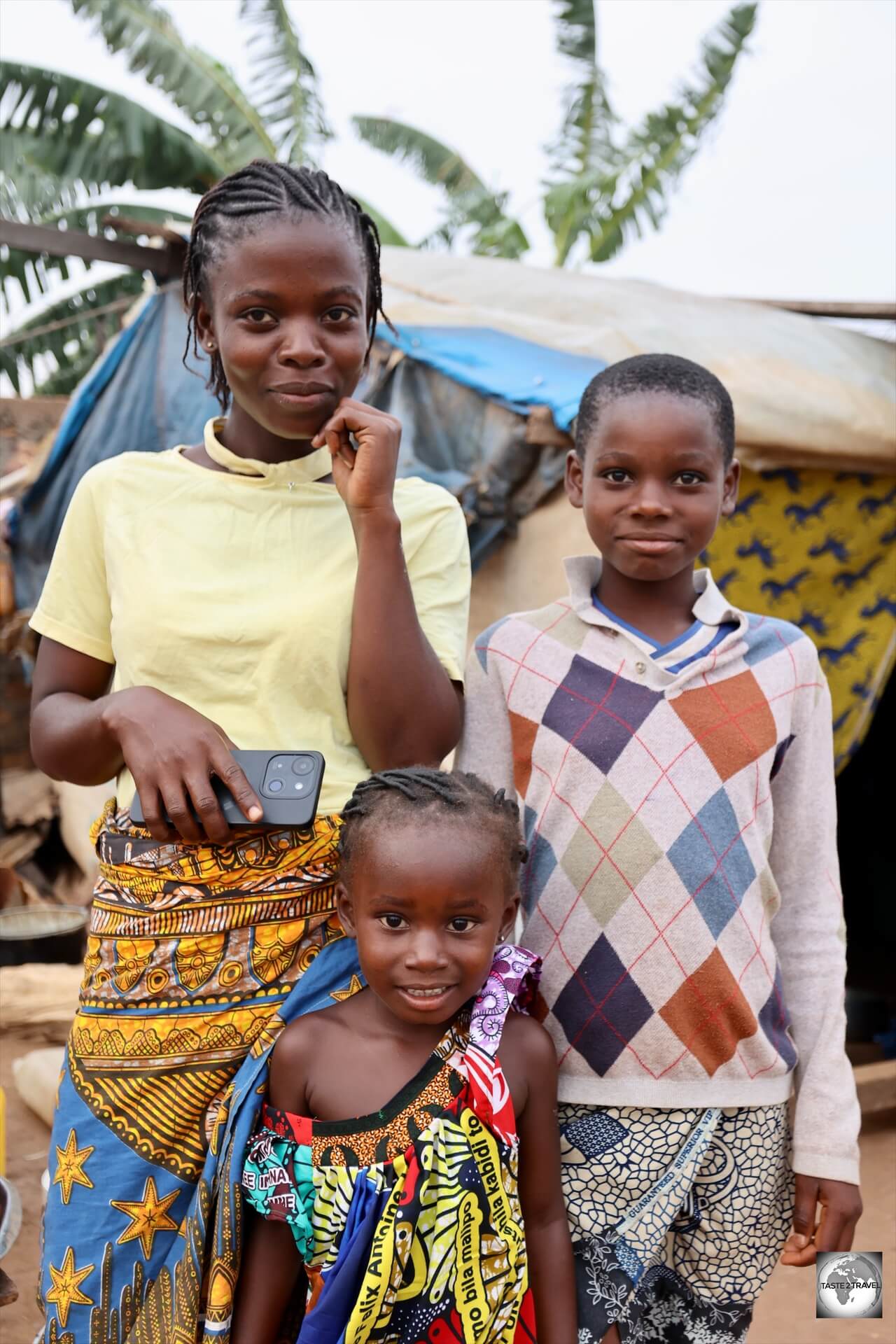
Refugees at “Camp île Bongo Soua”, which is located on the banks of the Ubangi River, in downtown Bangui.
Located in the middle of the Ubangi River, Bongo Soua Island has a history of flooding and, during one particularly bad wet season, the homes of many island residents were completely washed away by floodwaters.
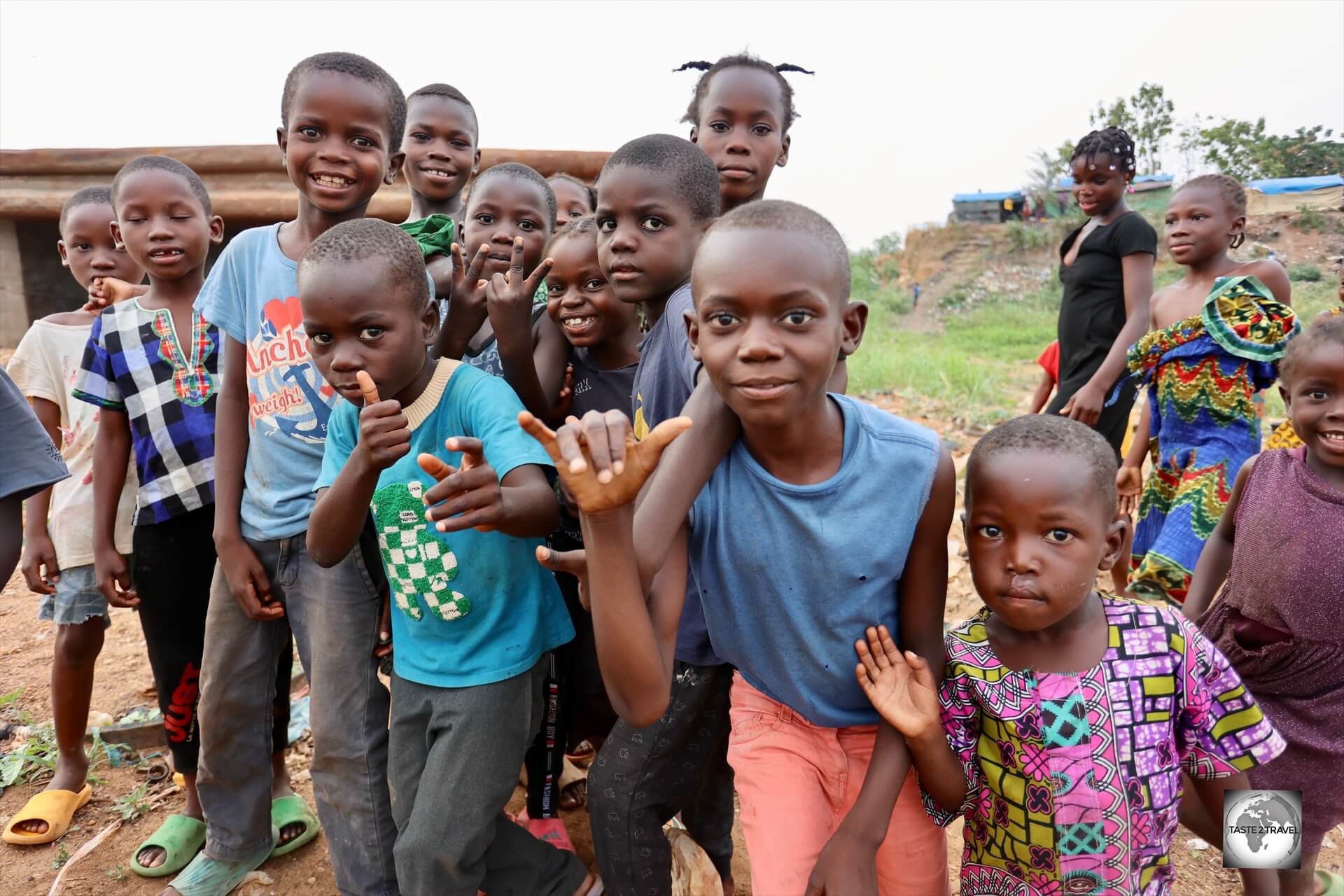
The friendly children at “Camp île Bongo Soua”.
Ever since, they have lived, high above the river, at Camp île Bongo Soua, in makeshift shelters, which have been made from materials supplied by the United Nations.

Despite their living conditions, the inhabitants of “Camp île Bongo Soua” were welcoming and friendly.
Maison Russe

A statue of Yevgeny Prigozhin, the founder of the Wagner Group, who was killed when his plane was shot out of the sky over Russia, stands outside the ‘Maison Russe’ in Bangui.
There have been an estimated 1,000 Wagner mercenaries stationed in CAR since 2018, protecting the government of Faustin-Archange Touadéra against rebels amid the Central African Republic Civil War, and seeking to control and extract valuable natural resources.
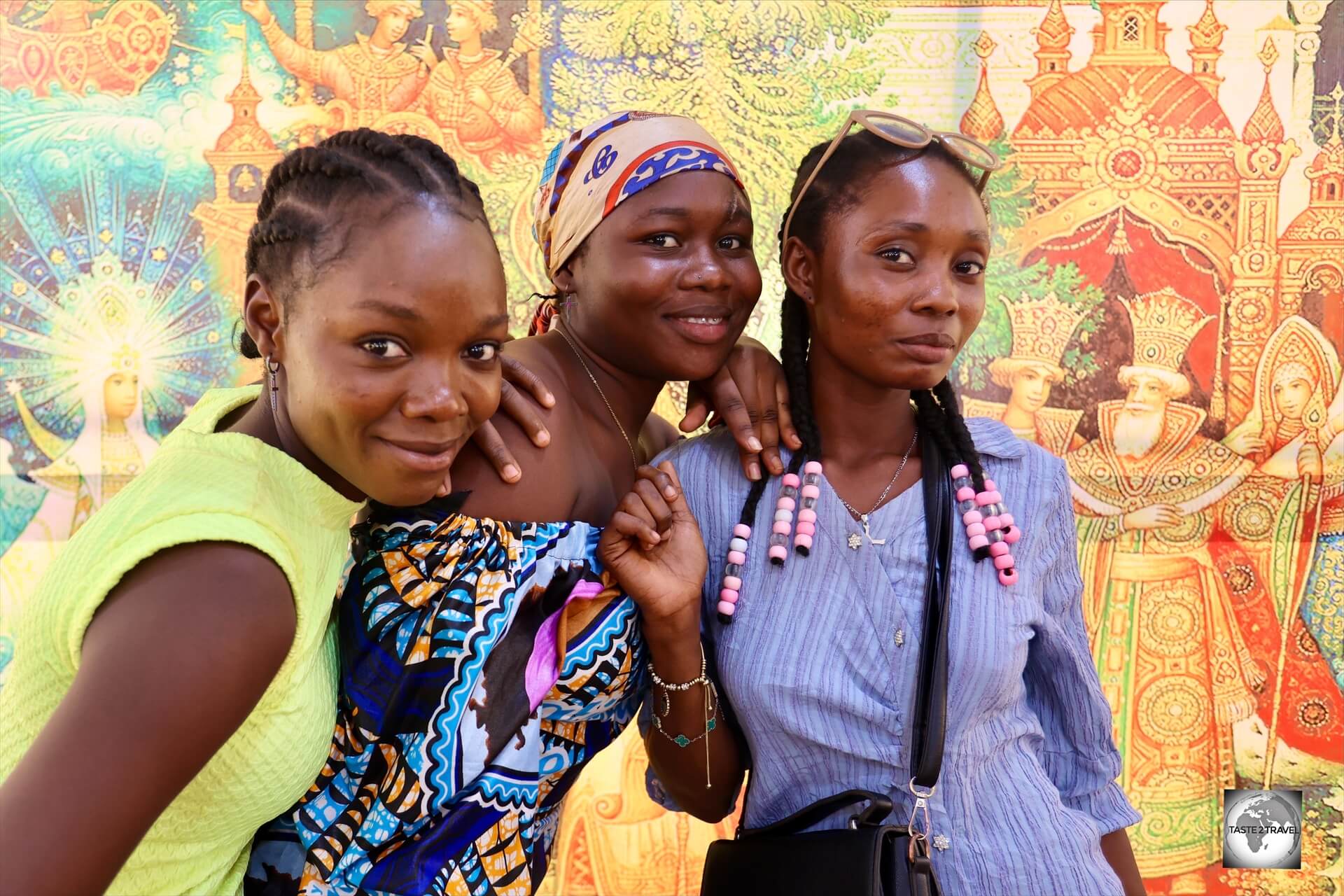
Locals attend Russian language lessons at the Maison Russe in Bangui.
The role of the Wagner Group initially, was to fill a security vacuum left by France after it withdrew its military forces from the country in October 2016.
The country had been in the midst of a civil war since 2012, which left three-quarters of it under rebel control.

The Maison Russe in Bangui is a Russian Cultural Centre sponsored by the Wagner mercenary group.
The Wagner group quickly suppressed the rebels, returning security and order to the country.
For this reason, the people of CAR are generally grateful for Wagner’s presence.
In exchange, Wagner has secured a series of generous mining concessions in the country to prospect for diamonds and gold, and is heavily involved in the timber industry.
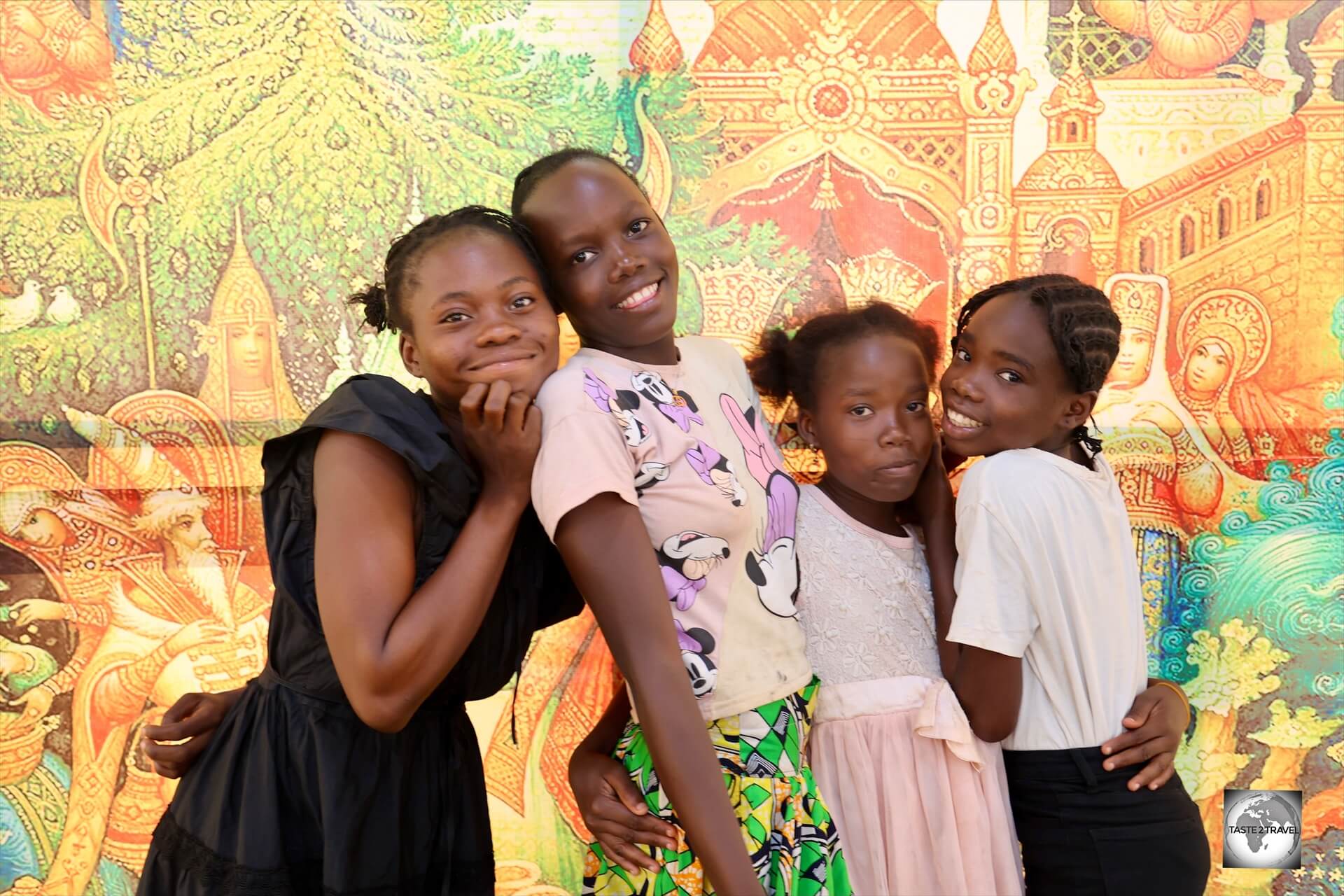
Children inside the Maison Russe, a Russian Cultural Centre which is sponsored by the Wagner mercenary group, in Bangui.
The softer, more diplomatic side of the Wagner Group is expressed in the form of the Maison Russe (Russia House), a Russian cultural centre, language centre and cinema which is located in downtown Bangui, near to the Russian embassy.
A statue of Yevgeny Prigozhin, the founder of the Wagner Group, is installed outside the cultural centre.
Mr Prigozhin was famously killed when his plane was shot out of the sky over Russia.
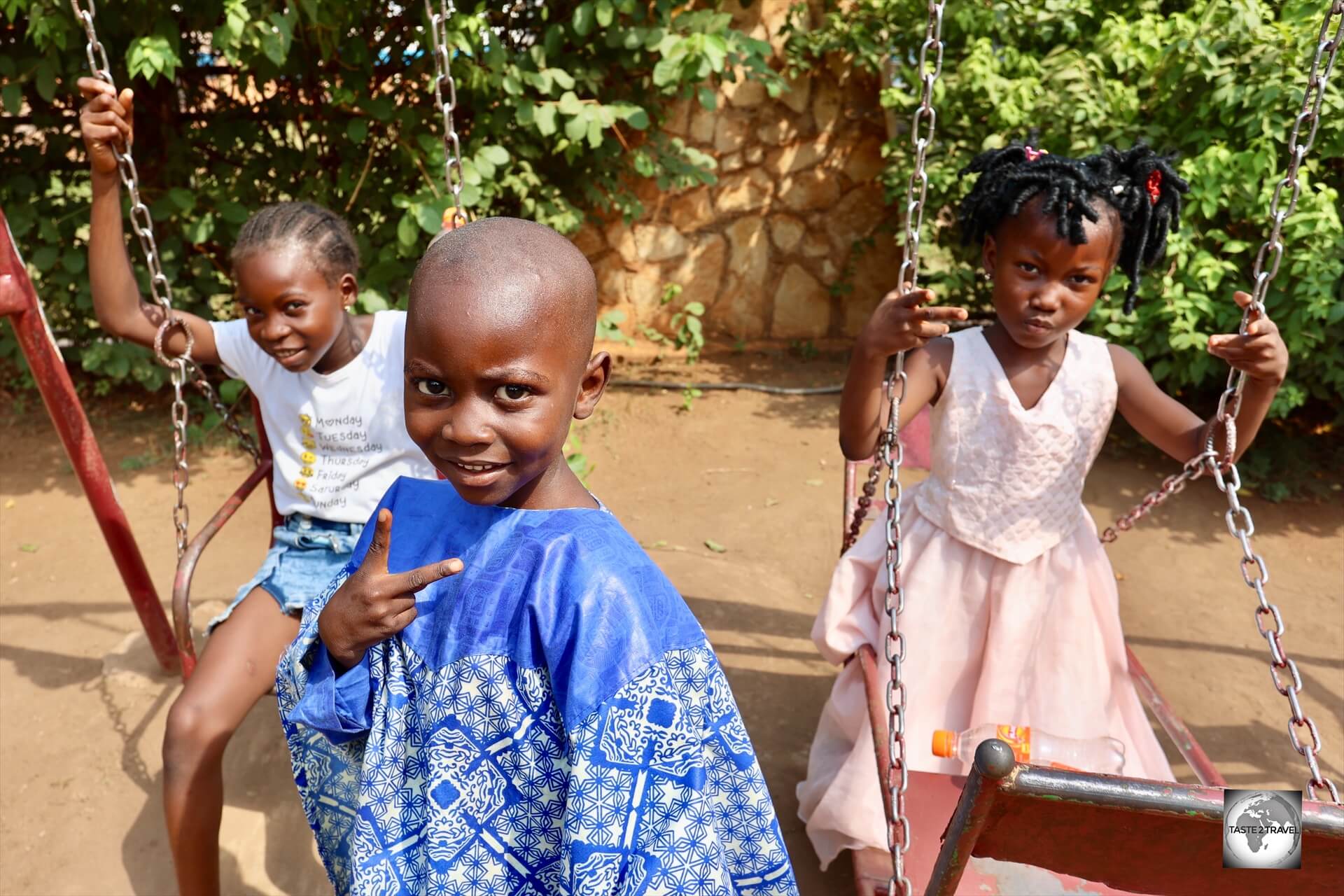
Children, playing on a swing set, in the garden of the Maison Russe in Bangui.
This incident was the culmination of events which commenced on the 23rd of June 2023, when the Wagner Group staged an uprising against the Russian government.
The uprising marked the climax of the Wagner Group–Ministry of Defense conflict, which had begun about six months earlier.
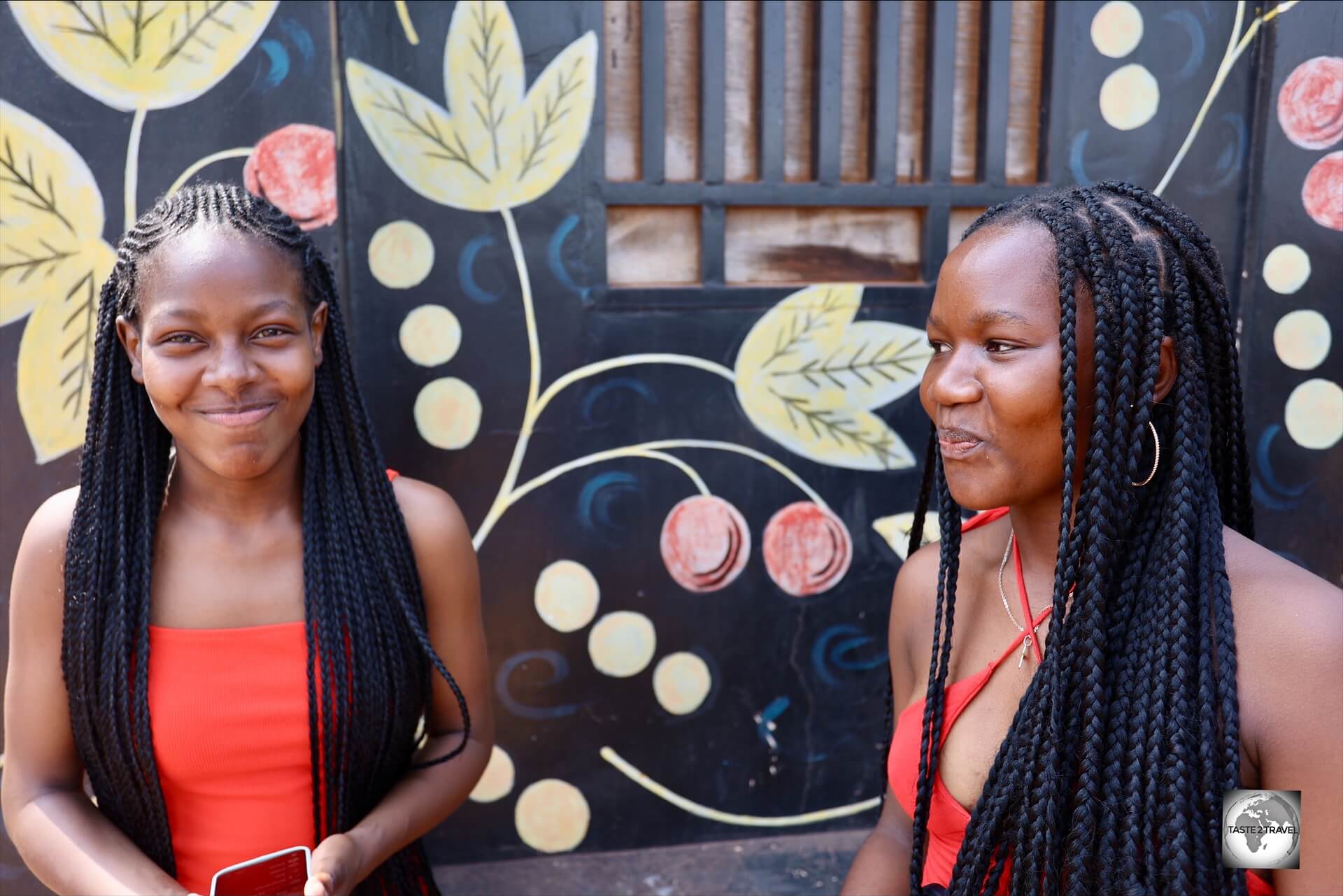
Two Russian language students at the Maison Russe in Bangui.
Prior to his death, on his final trip to the Central African Republic (CAR), the then-Wagner boss Yevgeny Prigozhin visited la Maison Russe where he posed for selfies with his lieutenants and locals.
The institute, and its diverse activities, are stark examples of how the mercenary group has become a stand-in for the Russian state in the Central African Republic.
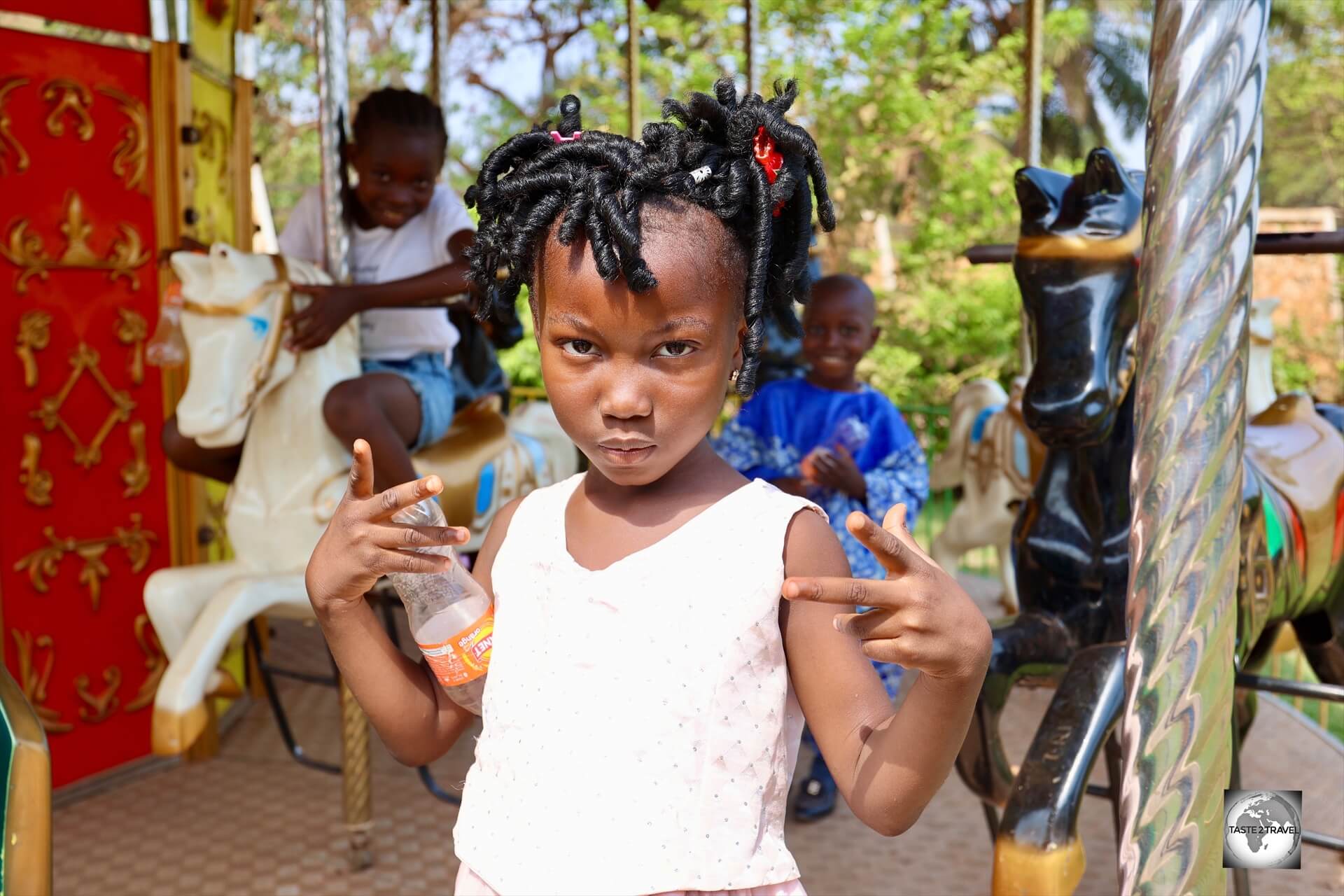
Children play on a carousel in the garden of the Maison Russe in Bangui.
At the cultural centre, a Russian tricolor flag flutters in the garden while children play on a carousel topped with an onion dome.
Inside, locals attend Russian language lessons and Russian cultural events.
Chutes de Boali
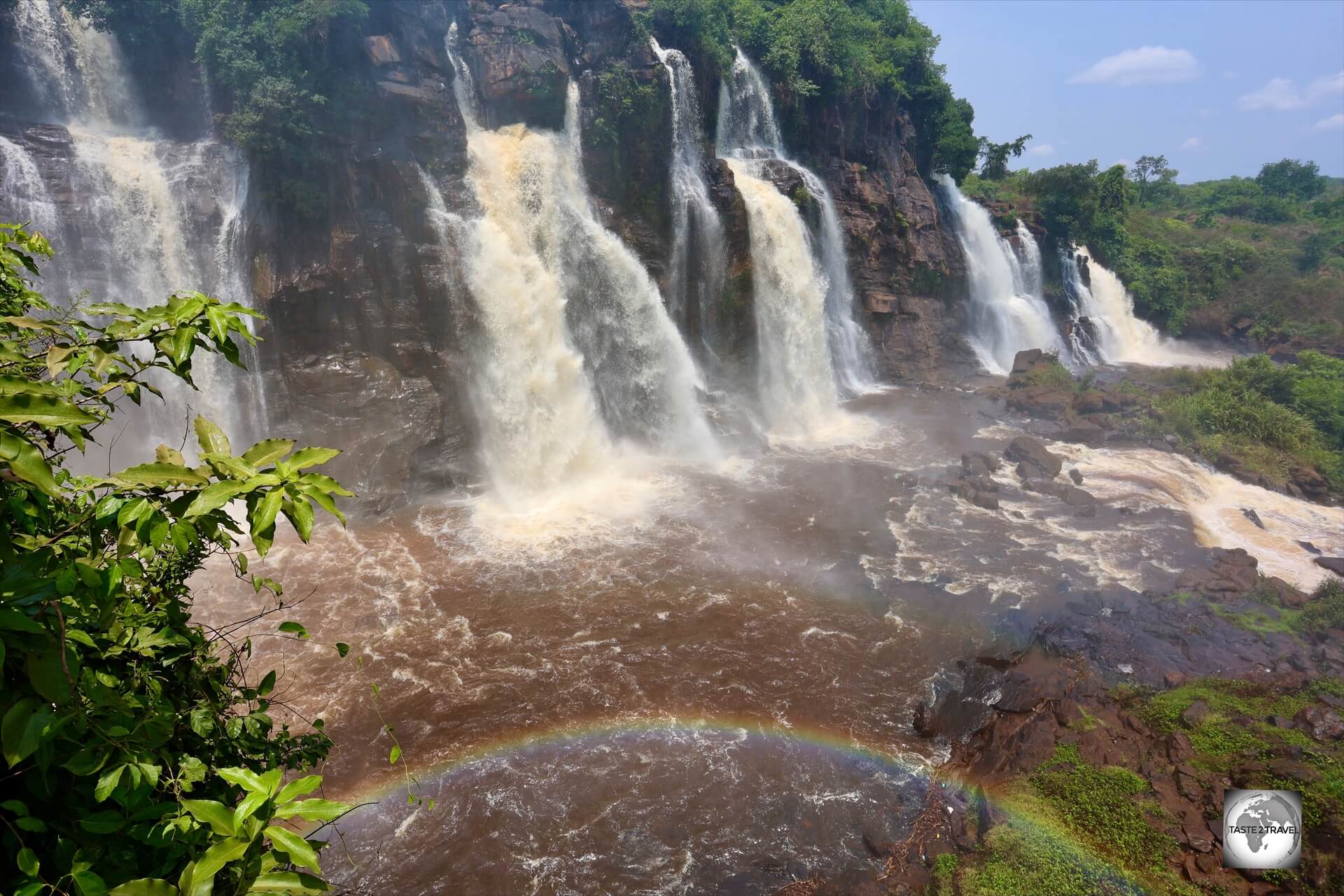
Located 100 km (62 miles) northwest of Bangui, the Chutes de Boali (Boali Falls) are considered to be the most impressive waterfall in Central Africa.
The Chutes de Boali (Boali Falls) are a stunning natural attraction located about 100 kilometres (62 miles) northwest of the capital, Bangui.
These falls are situated on the Mbali River and are among the most impressive in Central Africa.
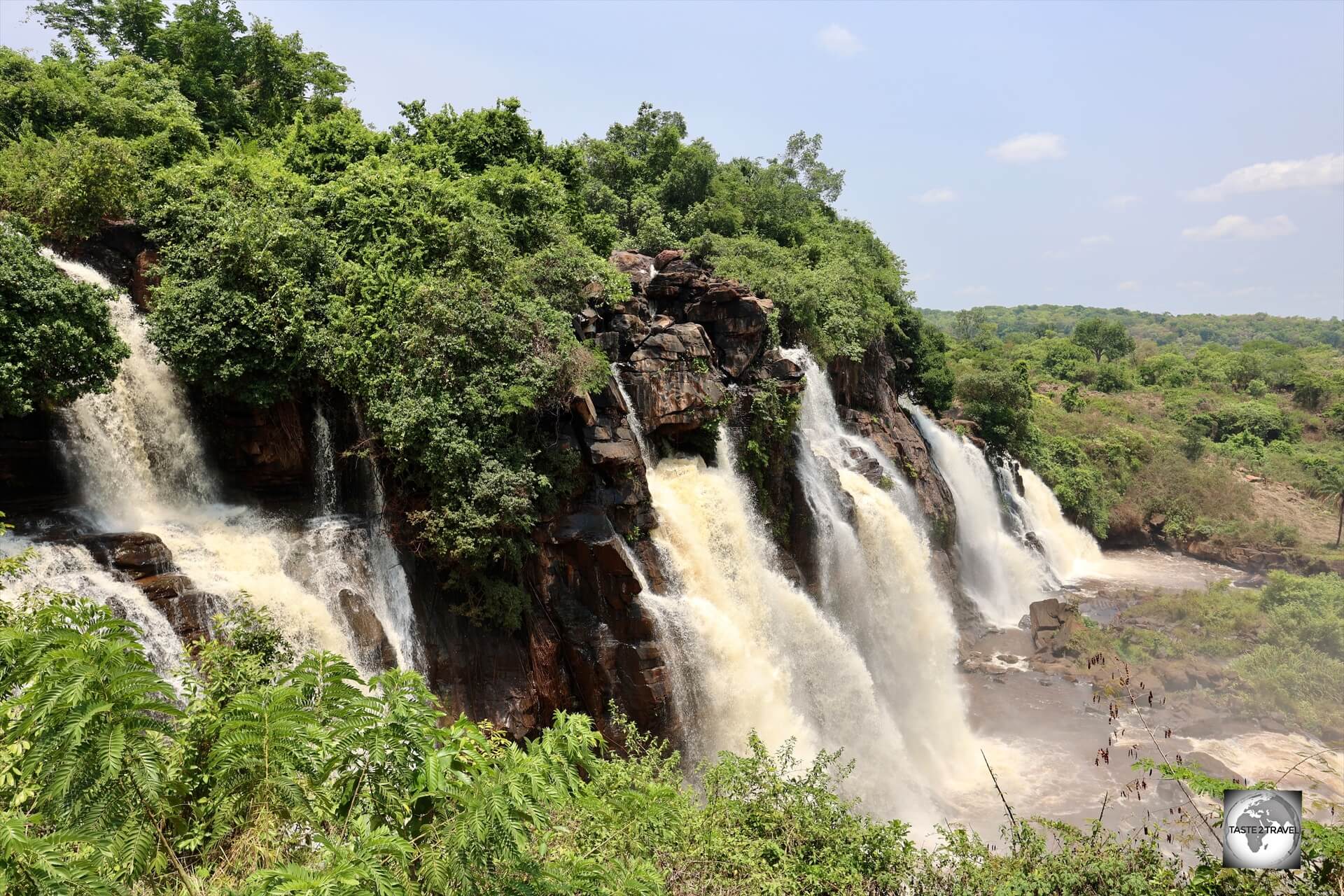
The Chutes de Boali (Boali Falls) are located on the Mbali River, with a drop of about 50 metres (164 ft).
The Chutes de Boali are a popular destination for local tourists and international travelers seeking off-the-beaten-path experiences.
While tourism infrastructure is limited due to the country’s political and economic challenges, the falls remain a symbol of natural beauty and national pride.
Boali Falls have a height of approximately 50 metres (164 feet) and a width which varies, especially during the rainy season, when water flow is at its peak.
I visited the falls in March, which is at the end of the dry season. Despite being the end of the dry season, the water flow was still very impressive.
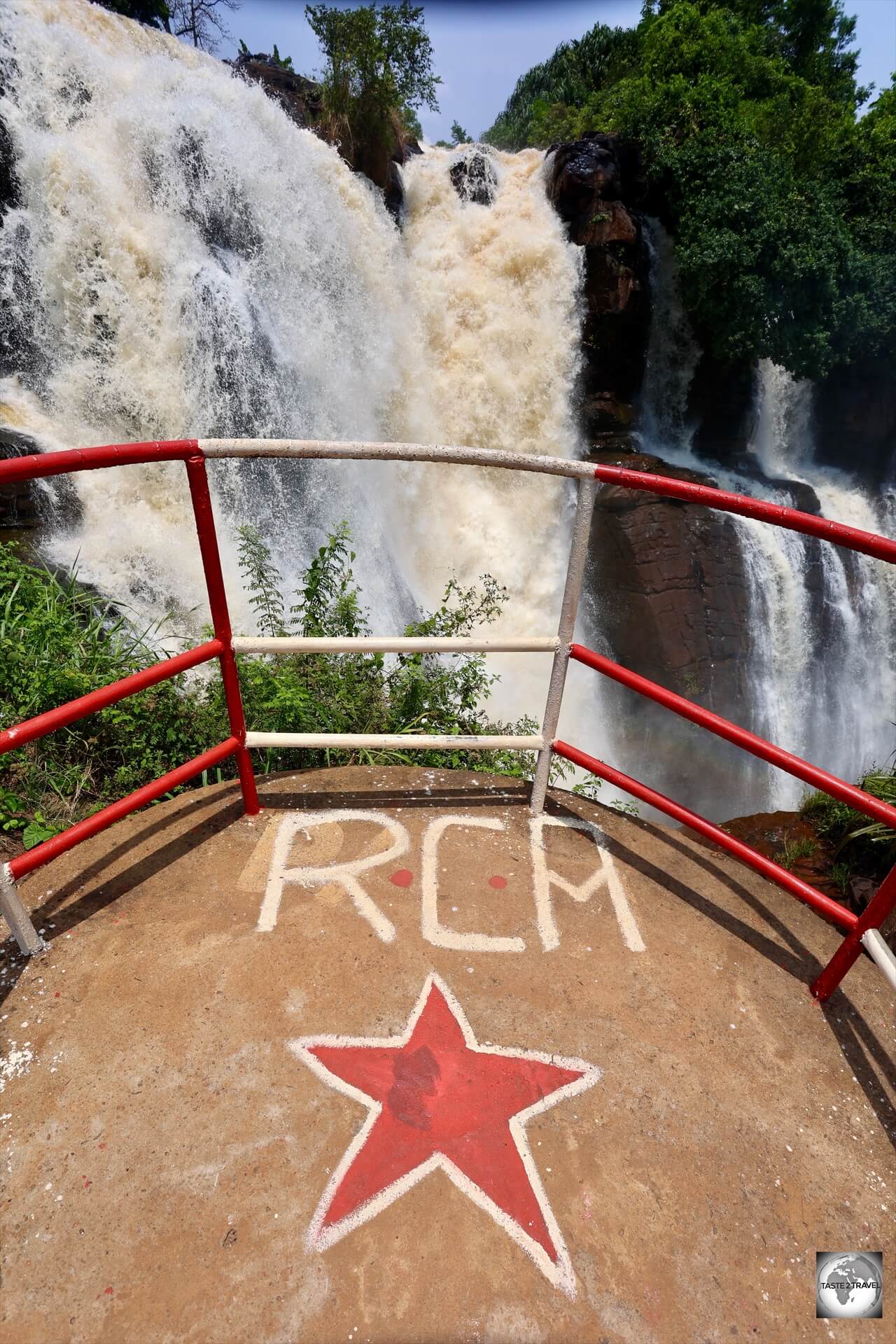
The Chutes de Boali are a popular destination for local tourists and international travelers seeking off-the-beaten-path experiences.
Surrounded by lush, tropical vegetation and dramatic rock formations, the falls offer a striking contrast between the powerful rushing water and the serene natural landscape.
The appearance of the fall’s changes dramatically between the dry and rainy seasons.
During the dry season, water flow is lower, but the geological formations become more visible.

The Chutes de Boali are an impressive sight and totally worth the 2-hour drive from Bangui.
In the rainy season, the falls become a roaring torrent of water
The Boali Falls also play an important role in the region’s infrastructure, with a hydroelectric power station nearby that supply’s electricity to Bangui and surrounding areas.
Aka Pygmy Village
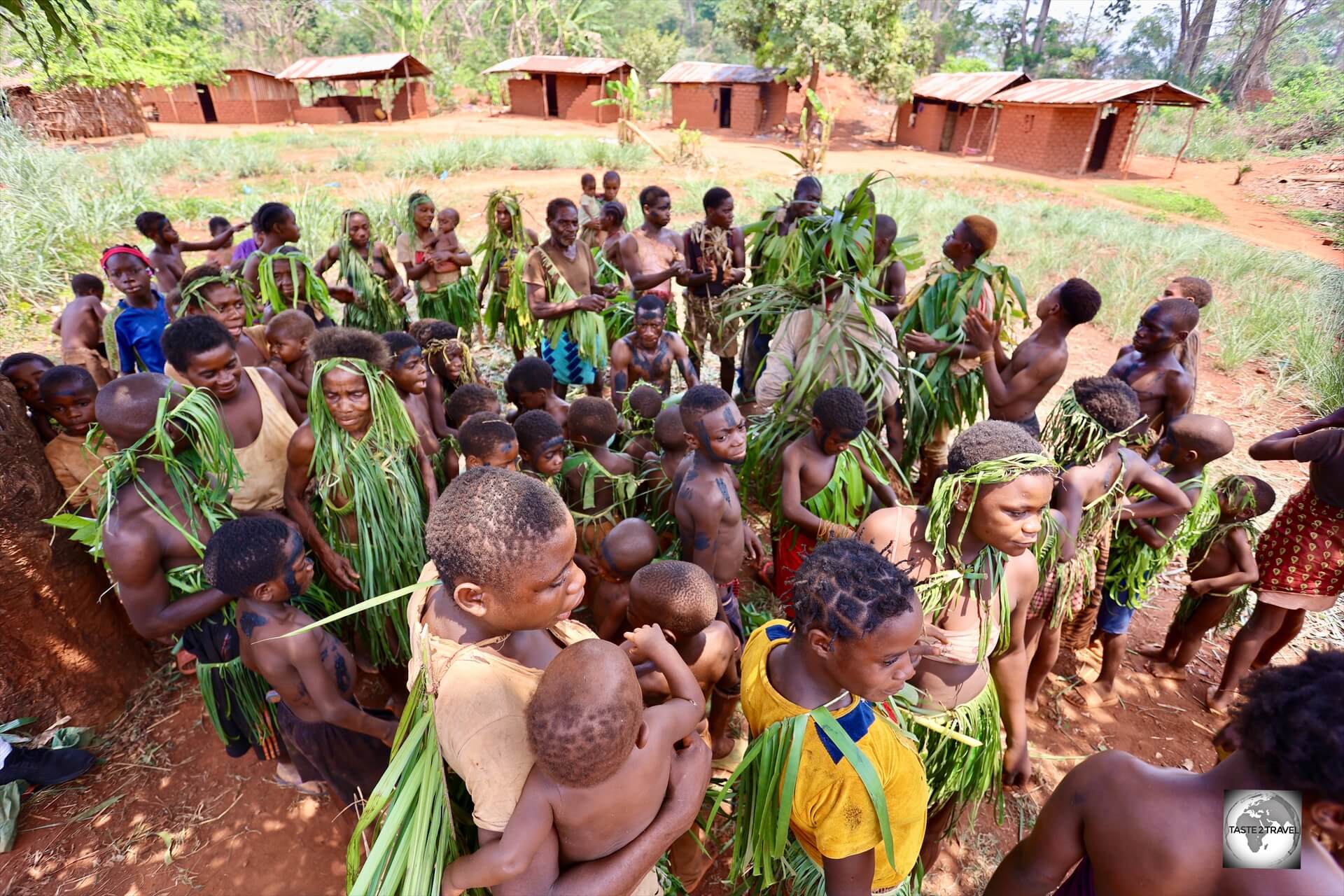
A highlight of my trip to CAR was a visit to an Aka Pygmy village in the south-west of the country.
A highlight of my trip to CAR was a visit to an Aka Pygmy village in the village of Kpèkèto, which is located 2 hours’ drive south-west of Bangui, near Mbaïki, which is the capital of Lobaye, one of the 14 prefectures of the Central African Republic.
Who are the Pygmies?
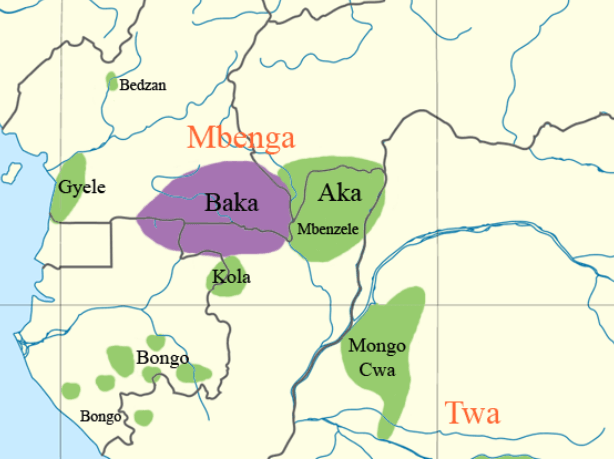
A map showing the distribution of different Pygmy groups in the Congo Basin.
Source: Wikipedia.
In anthropology, pygmy peoples are ethnic groups whose average height is unusually short.

Aka Pygmy youth in the village of Kpèkèto, which is a 2-hour drive south-west of Bangui, close to the border of the Republic of the Congo.
The term pygmyism is used to describe the phenotype of endemic short stature (as opposed to disproportionate dwarfism occurring in isolated cases in a population) for populations in which adult men are on average less than 150 cm (4 ft 11 in) tall.
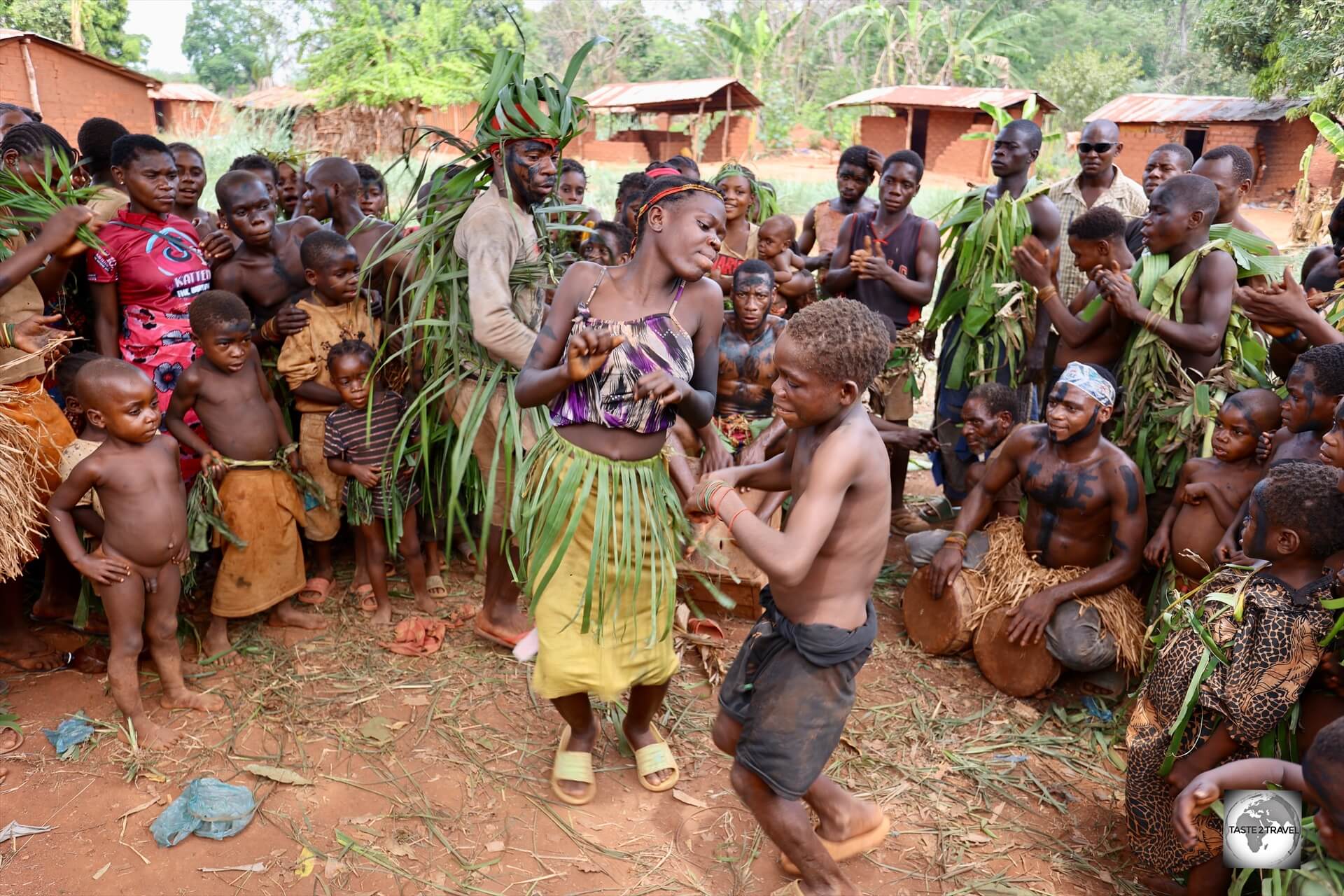
A tribe of Aka Pygmies perform for our group during a visit to their village at Kpèkèto in south-west Central African Republic.
Although the term is sometimes considered derogatory because it focuses on a physical trait, it remains the primary term associated with the African Pygmies, the hunter-gatherers of the Congo Basin (comprising the Aka, Bambenga, Bambuti and Batwa).
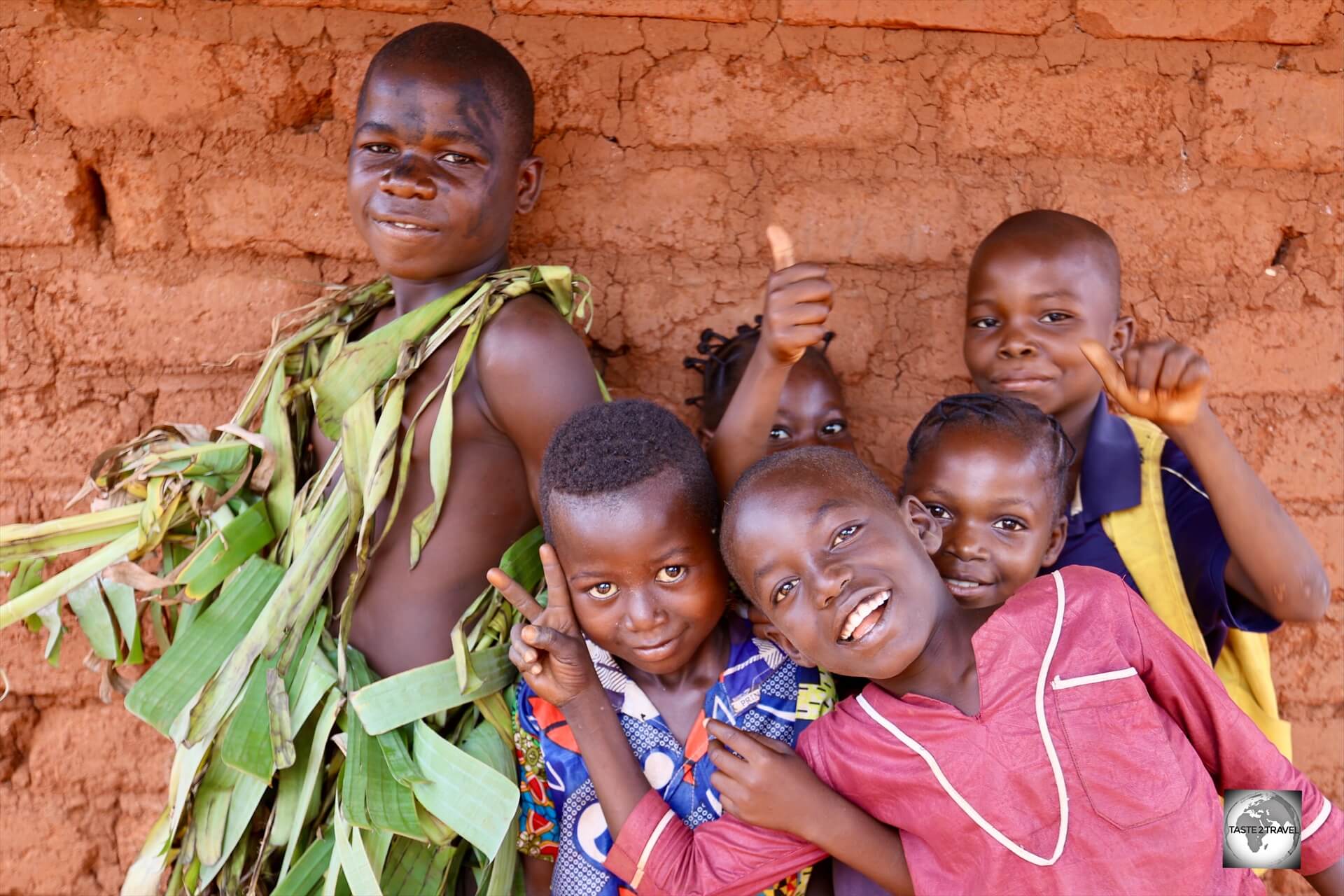
The Aka Pygmies were very friendly and welcoming and the children were especially photogenic.
African Pygmies live in several ethnic groups in Rwanda, Burundi, Uganda, Democratic Republic of the Congo, Republic of the Congo, Central African Republic, Cameroon, Equatorial Guinea, Gabon, Angola, Botswana, Namibia, Madagascar, and Zambia.
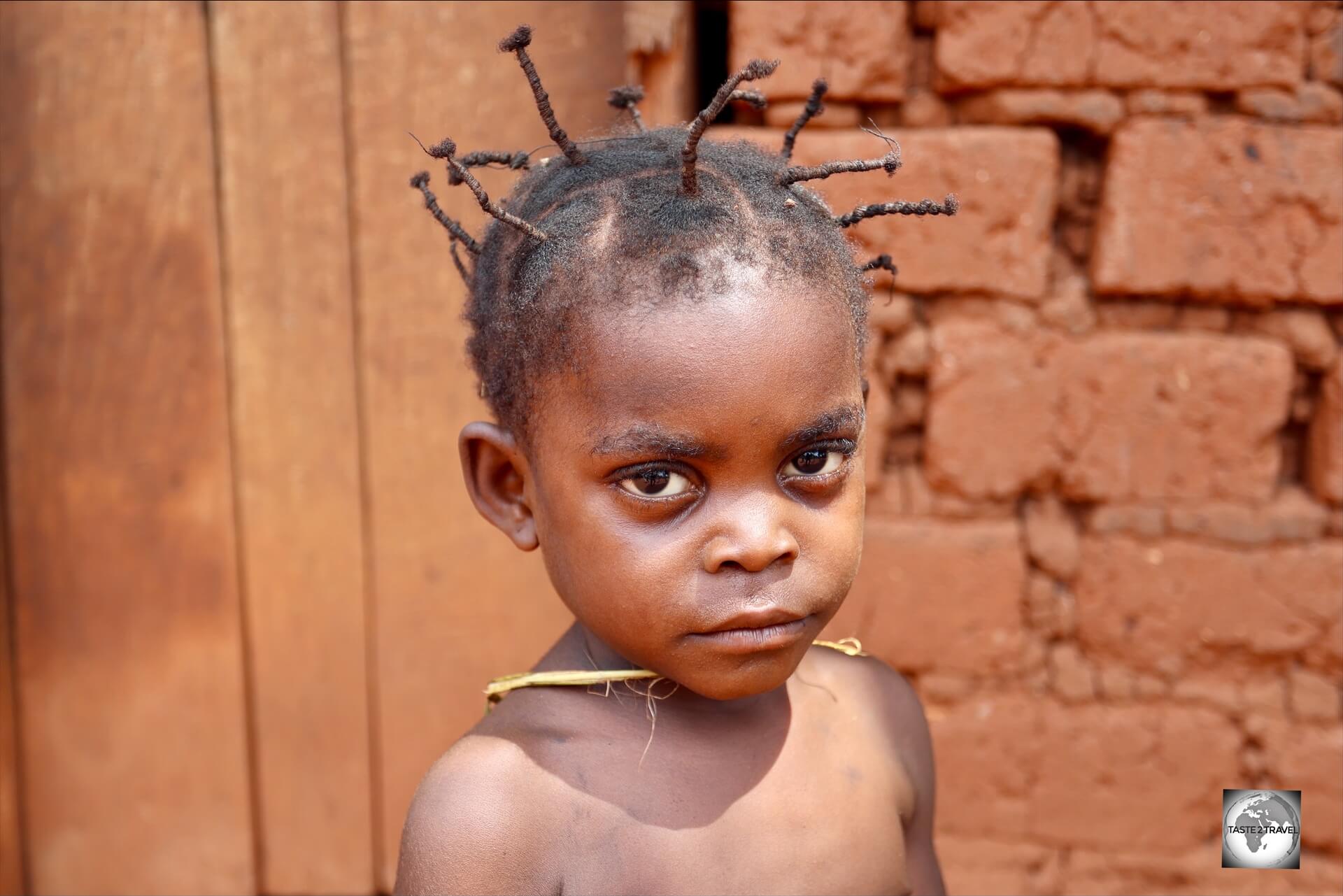
An Aka Pygmy girl, being a little shy.
There are at least a dozen pygmy groups, sometimes unrelated to each other.
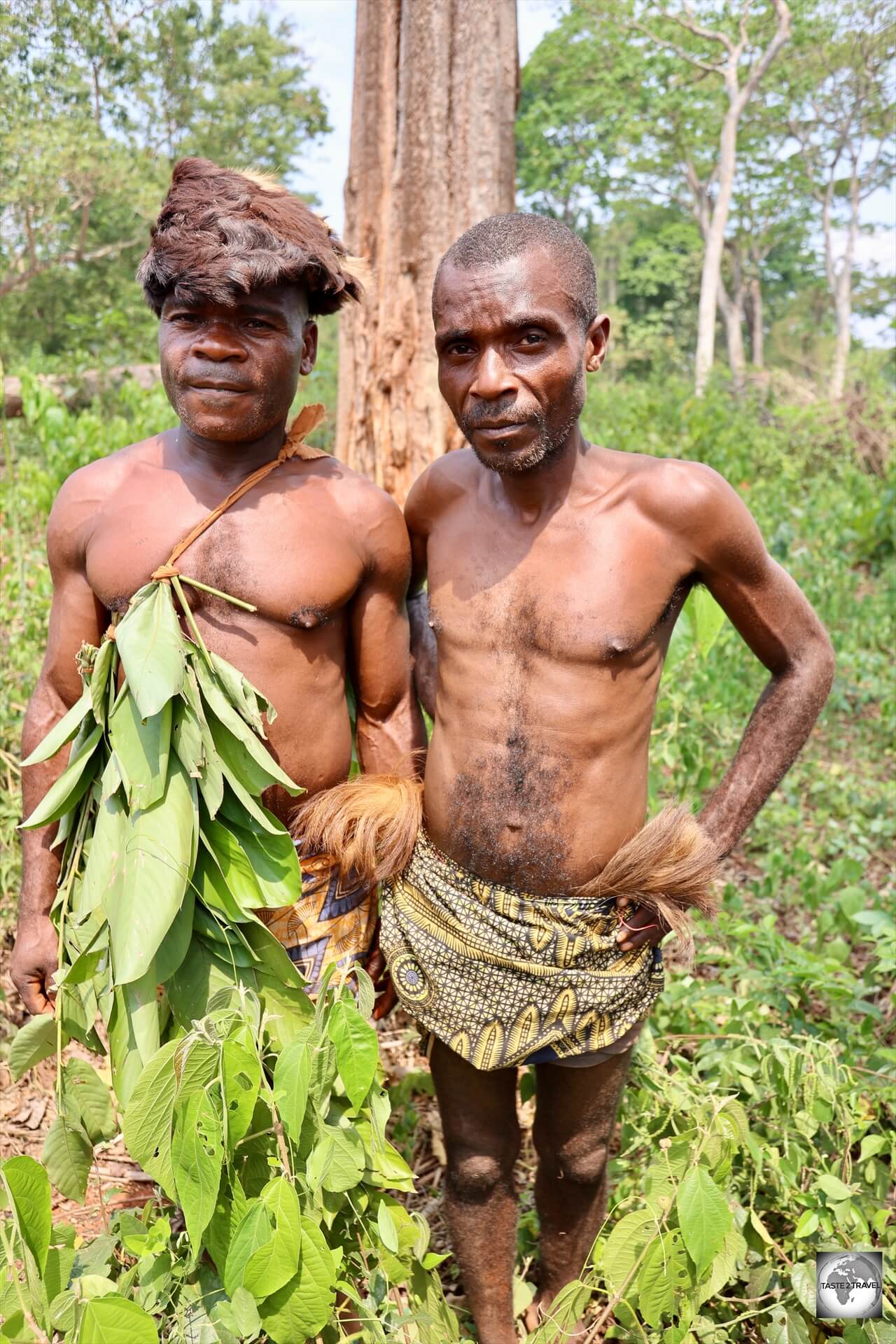
The chief of the Aka Pygmy village (left), wearing his traditional head-dress.
The best known are the Mbenga (Aka and Baka) of the western Congo Basin, who speak Bantu and Ubangian languages.
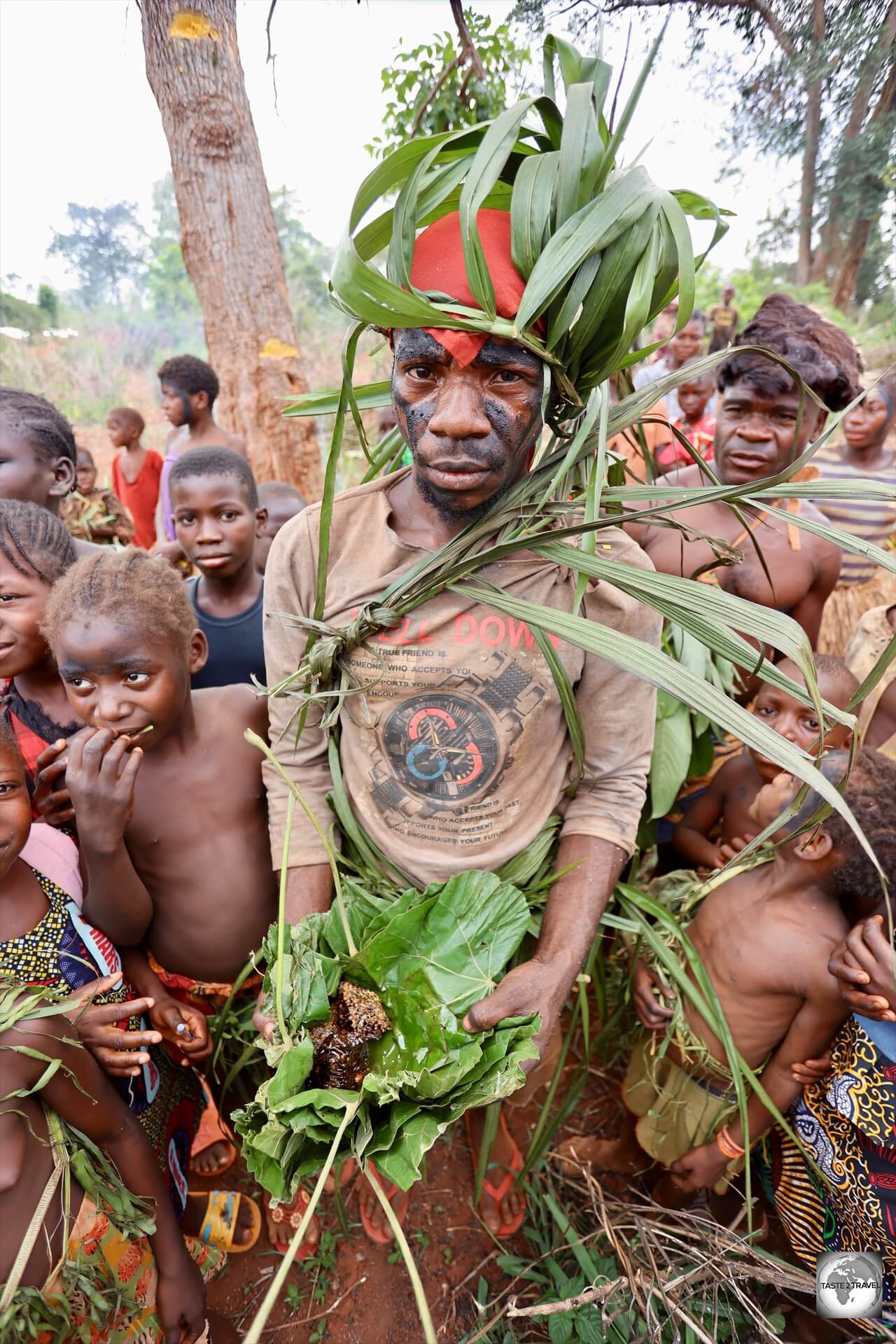
During our visit, the Aka Pygmies demonstrated how they collect wild bush honey, which we got to taste. Very rich and full of flavour!
Most pygmy communities are partially hunter-gatherers, living partially but not exclusively on the wild products of their environment.
They trade with neighbouring farmers to acquire cultivated foods and other material items; no group lives deep in the forest without access to agricultural products.
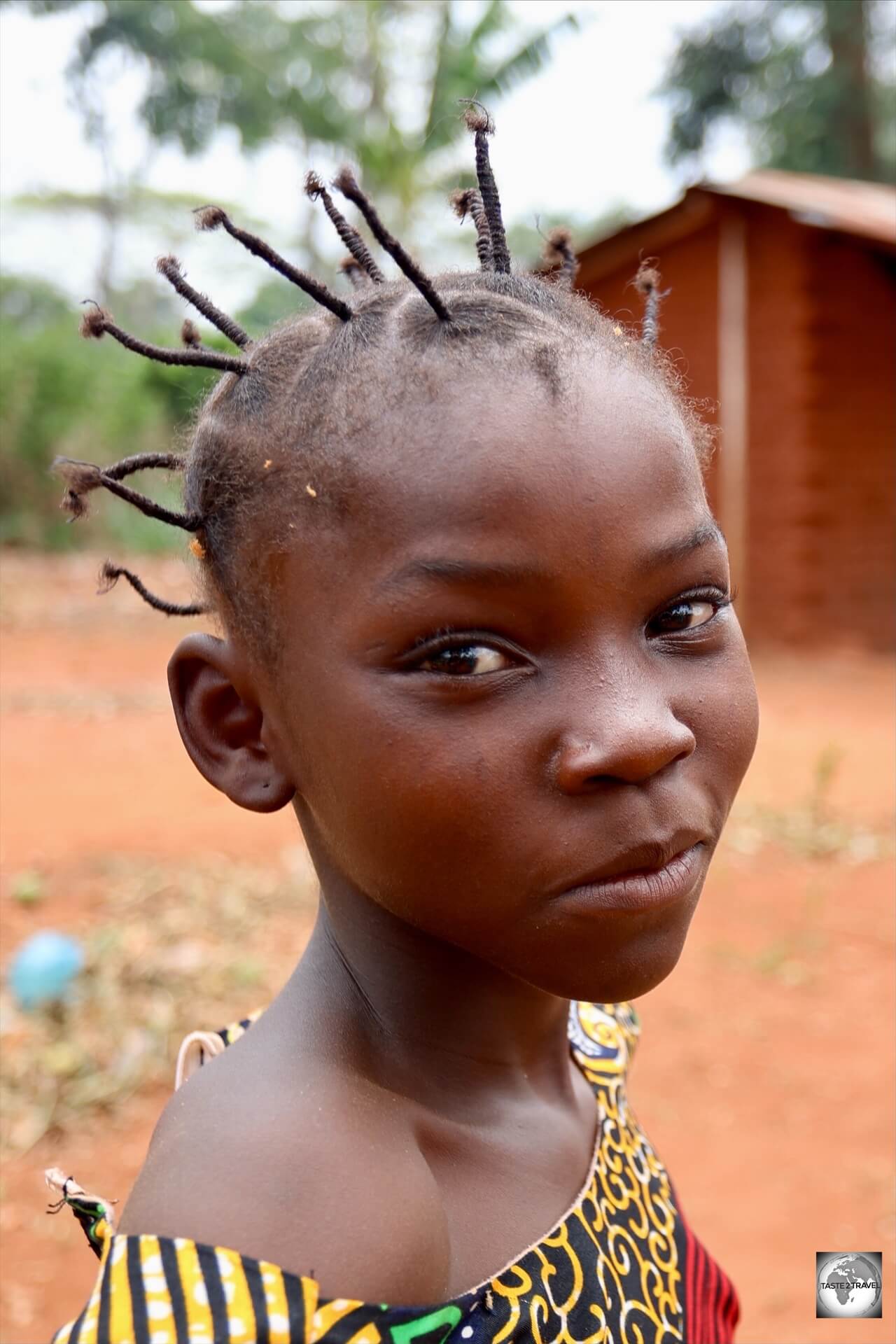
A young Aka Pygmy girl.
It is estimated that there are between 250,000 and 600,000 Pygmies living in the Congo rainforest
On my trip, we visited a tribe of Aka Pygmies who primarily live in the southwestern region of the Central African Republic and northern Republic of the Congo.
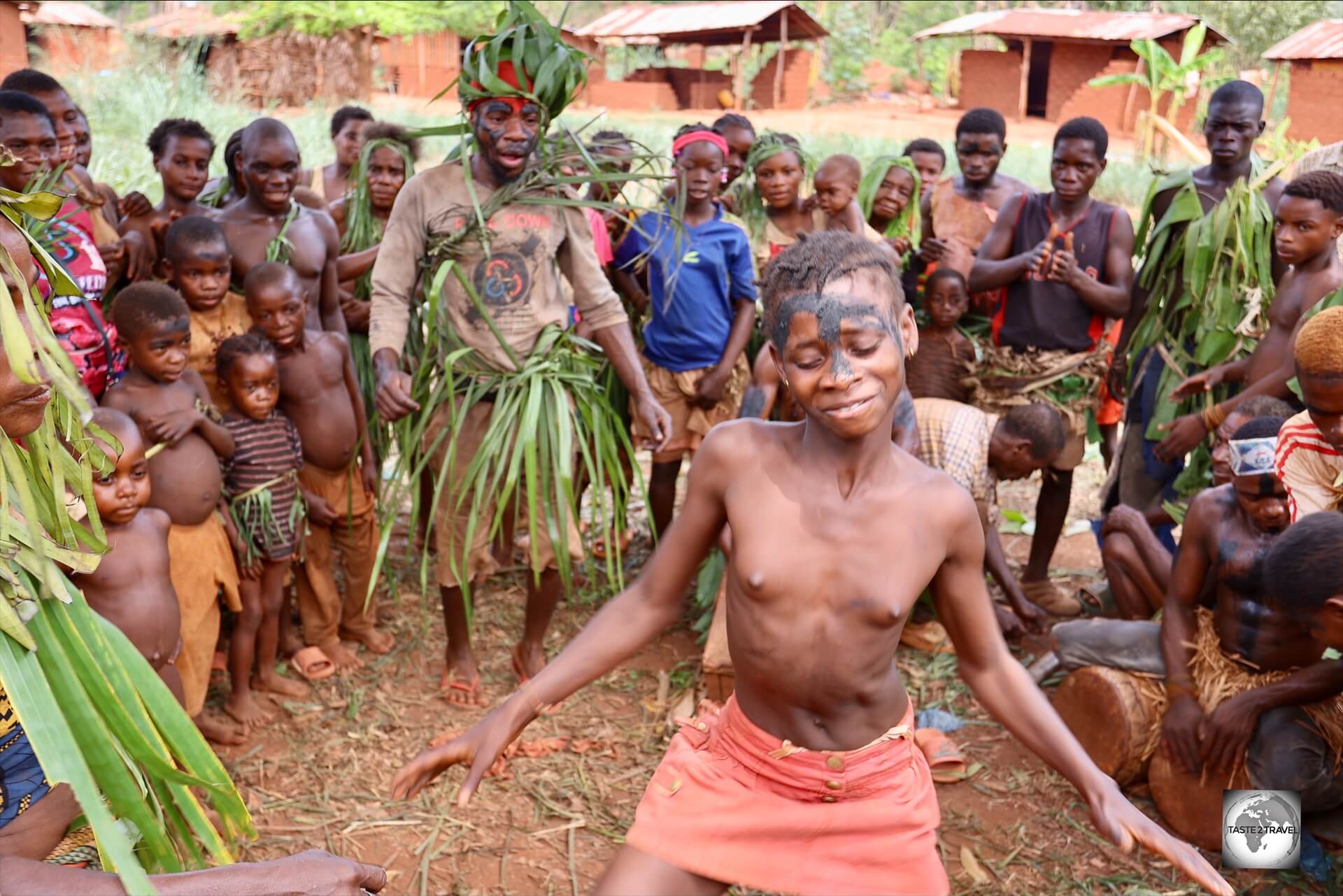
Aka Pygmies are known for their traditional song and dance.
They are known for their unique vocal musical tradition and their close connection to the tropical rainforest environment.
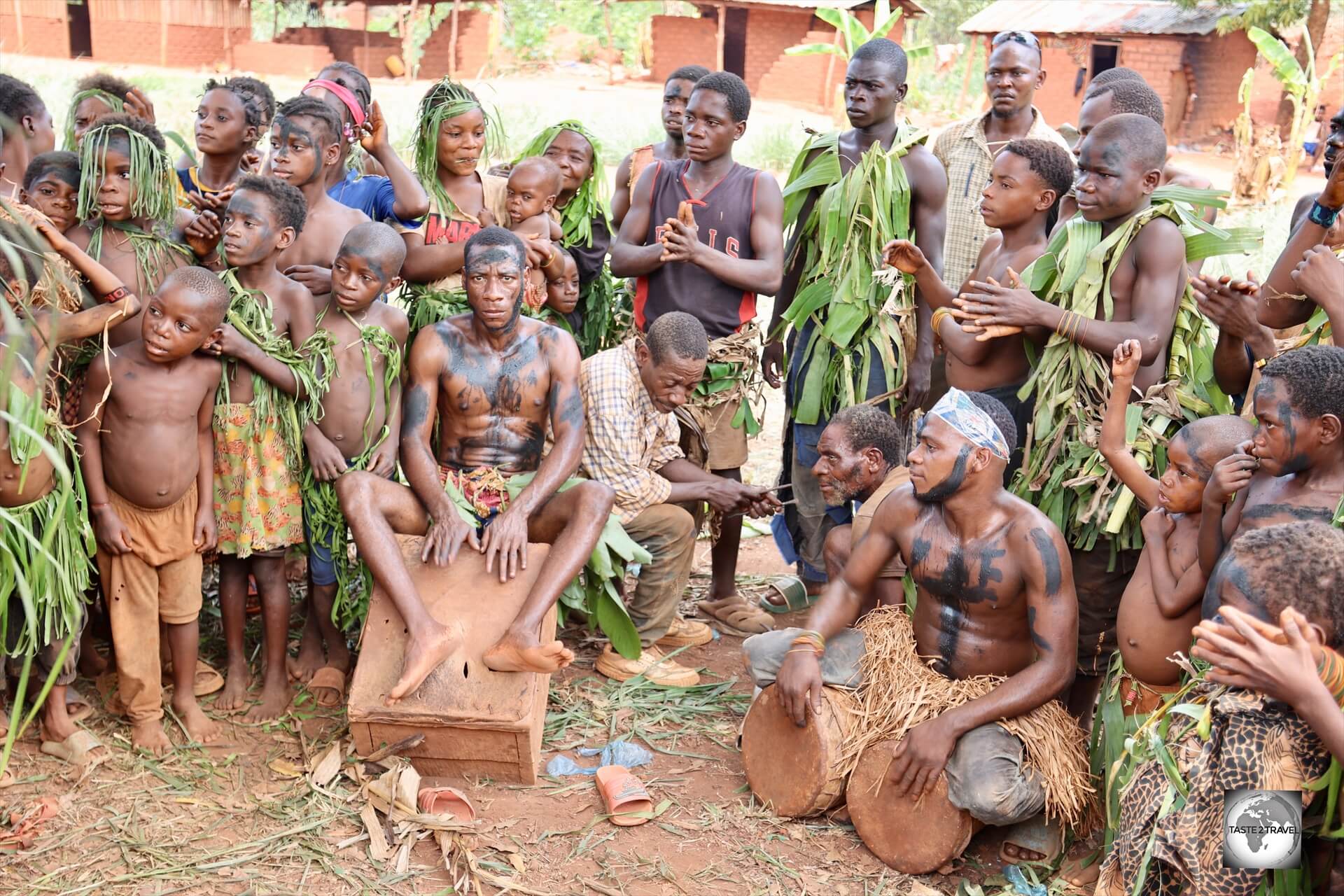
The Ata Pygmies are known for their musical and dancing traditions.
Pygmies have a strong cultural and religious connection to the forest, often viewing it as sacred.
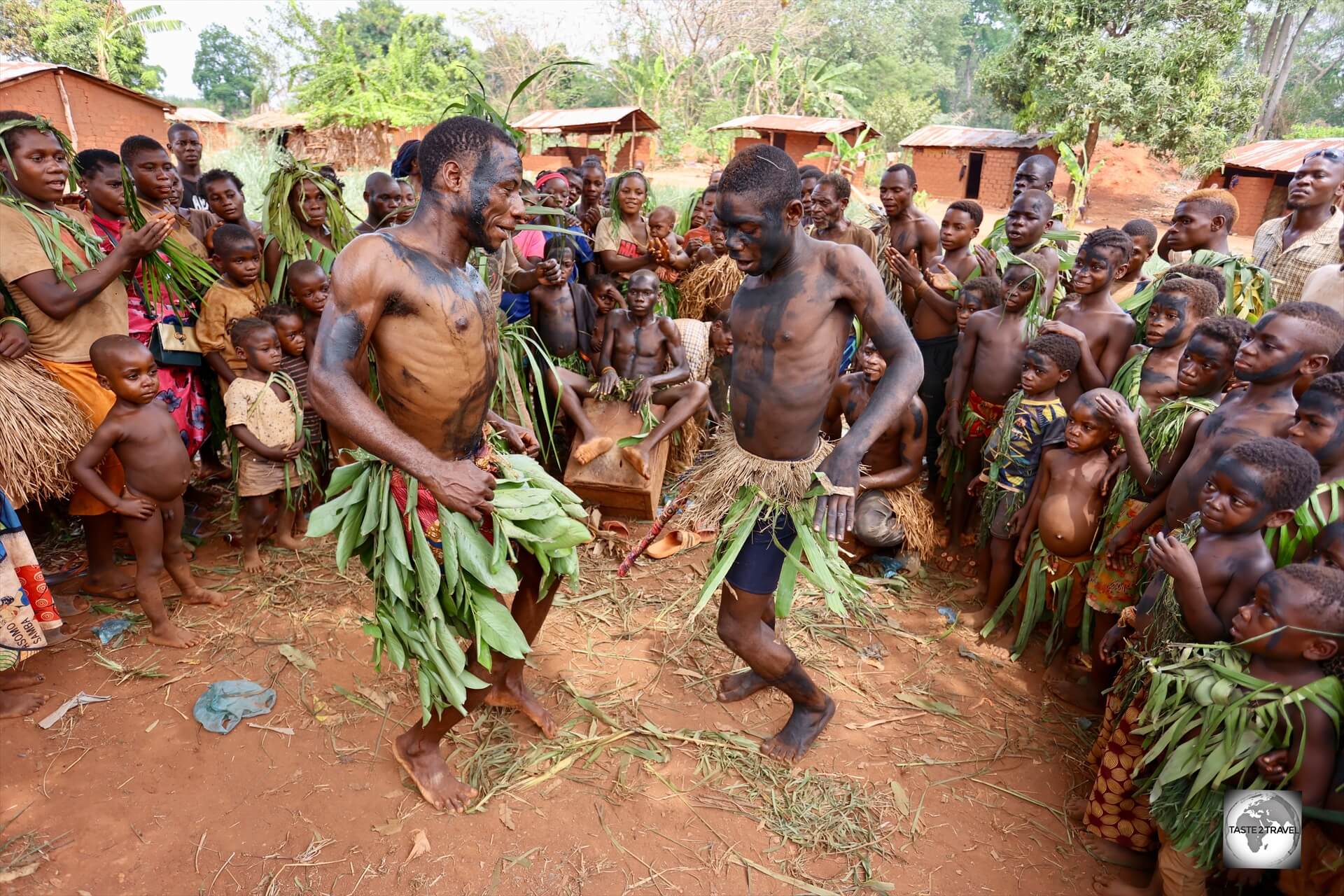
The Ata Pygmies are known for their musical and dancing traditions.
Pygmies in the Central African Republic, particularly the Aka, are known for their traditional hunter-gatherer lifestyle in the rainforests and traditionally simple, non-hierarchical society.

The Ata Pygmies are a small ethnic group who inhabit the Congo Basin.
They are a small ethnic group native to the Congo Basin, traditionally subsisting on hunting and gathering wild forest resources.
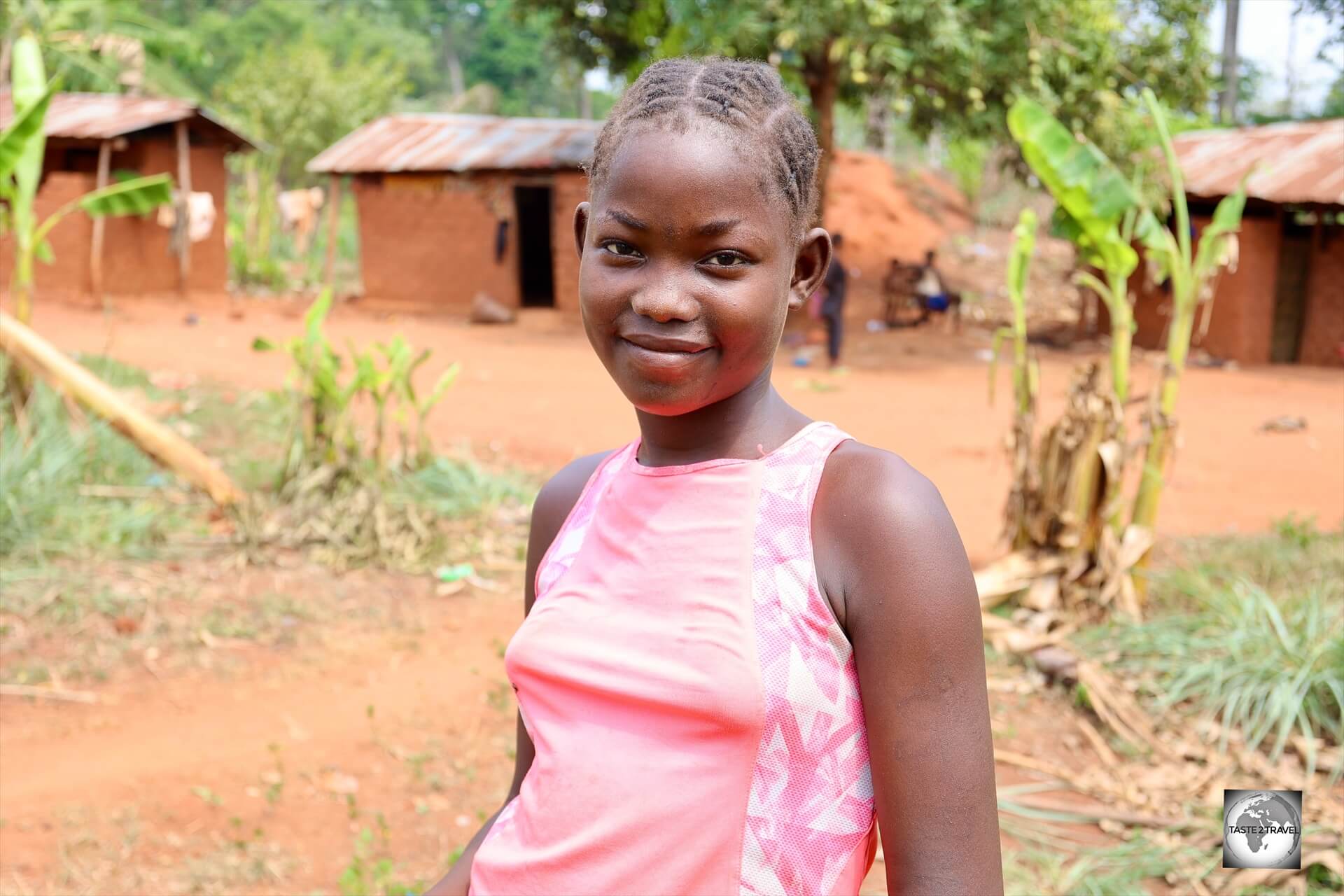
The Ata Pygmies split their time between living in the rainforest and living in established villages.
They spend their time between living in the forest, and in established villages, where they work with local farmers to earn extra income.
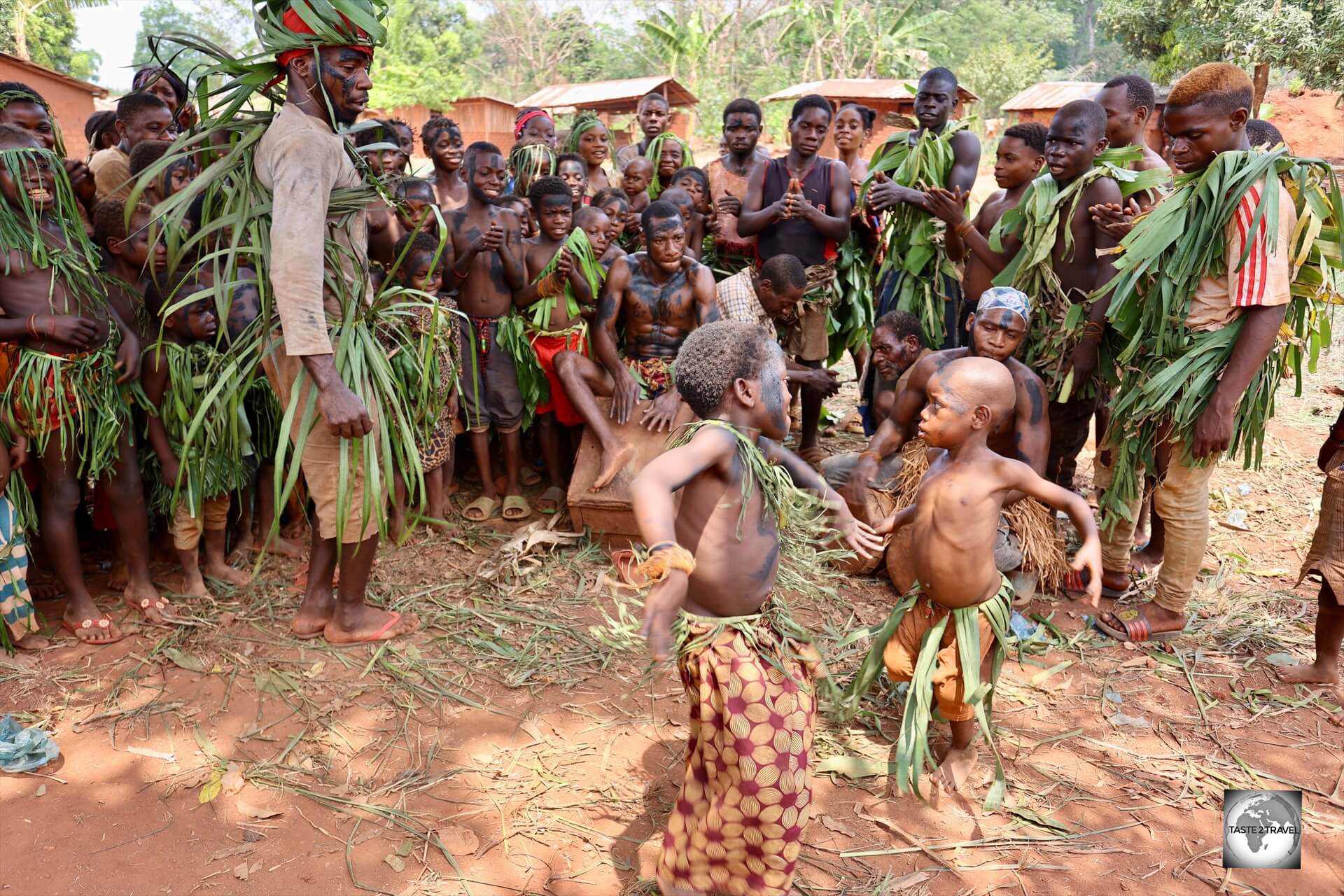
Known for their unique singing and dancing traditions, the Ata Pygmies know how to put on a show.
They are known for their unique singing and dancing traditions.
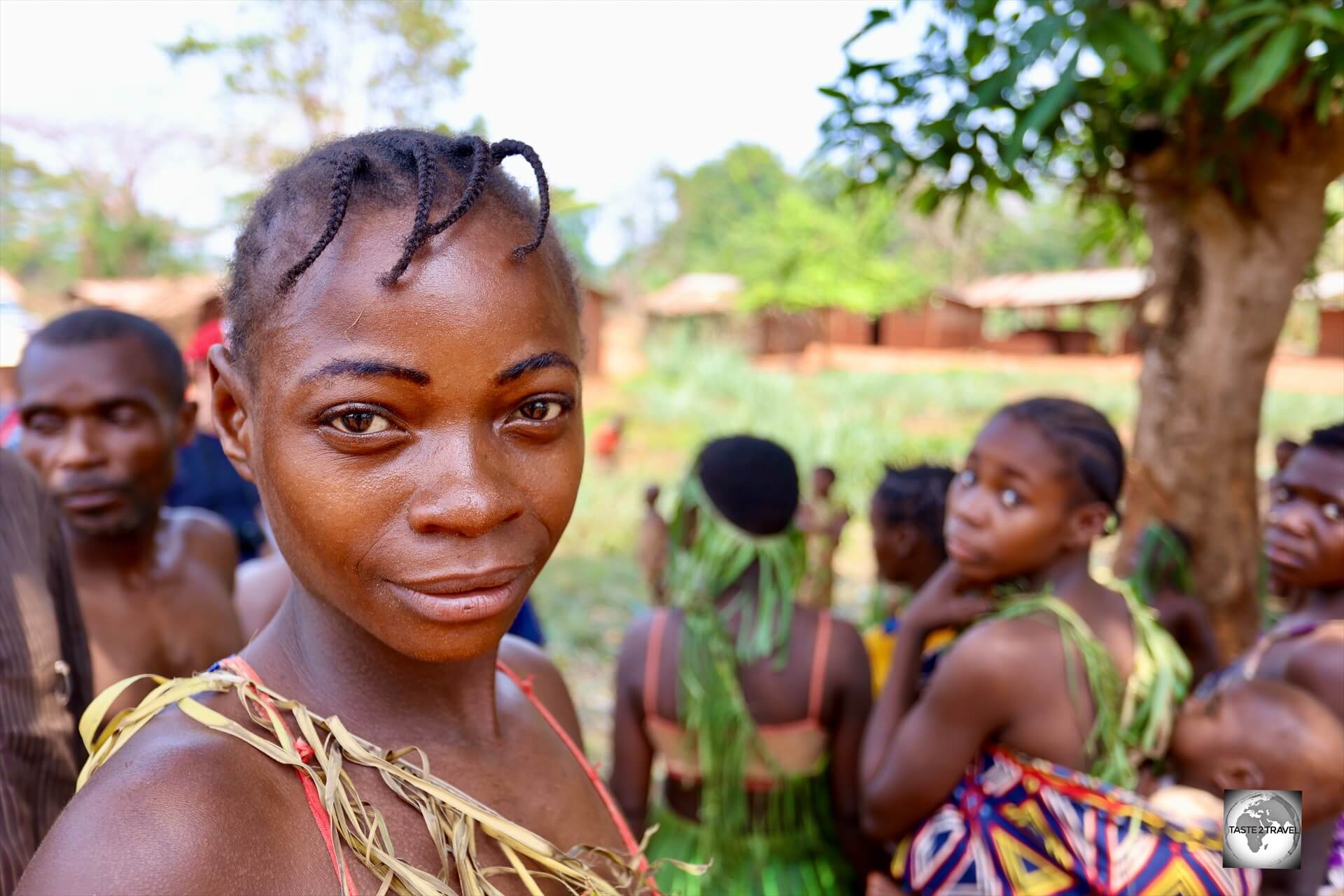
The Ata Pygmies gather to perform traditional song and dance for our group.
During our visit to the Aka Pygmy village at Kpèkèto, we were treated to a show of traditional music and dancing which was very energetic.
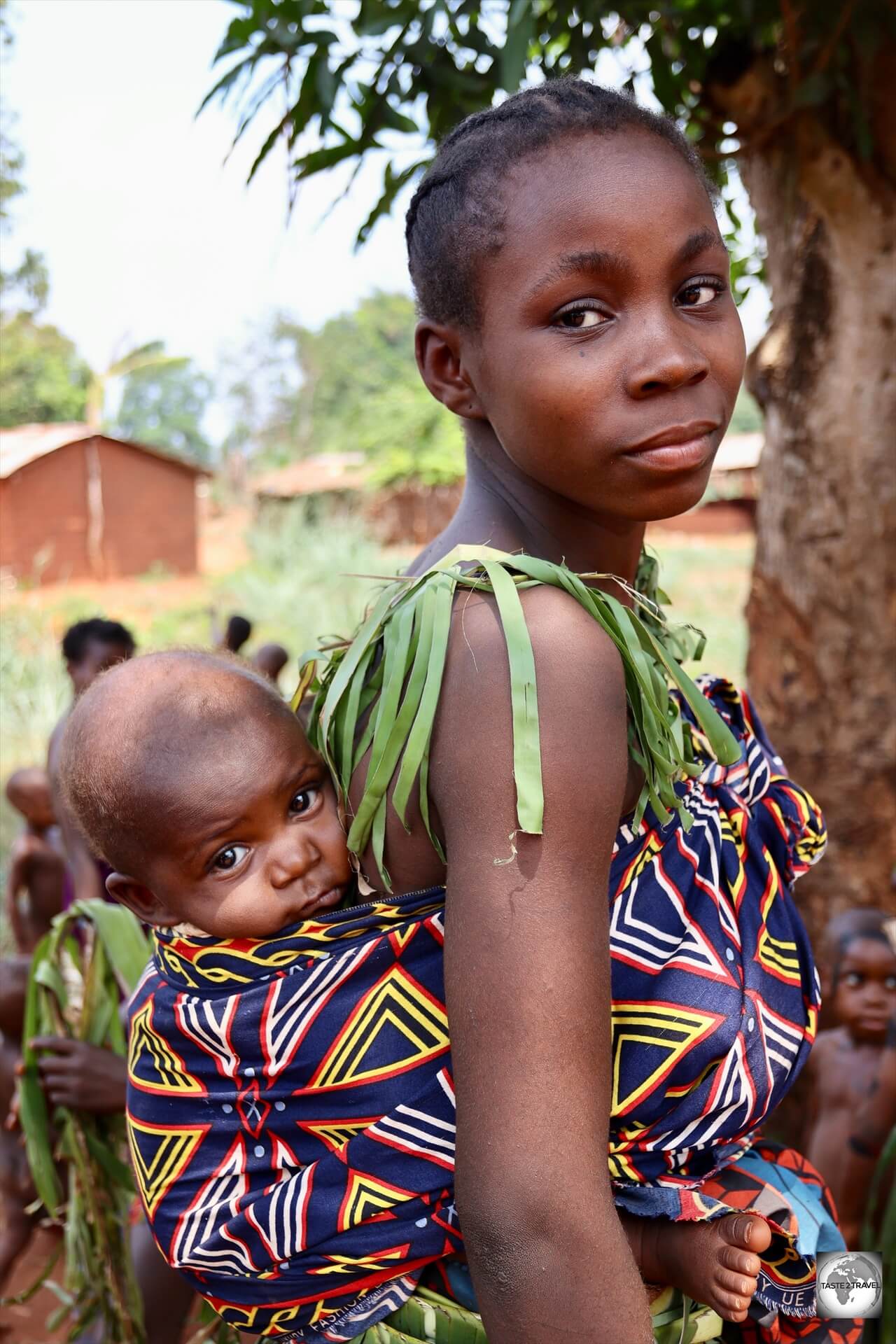
An Ata Pygmy mother and child.
Videos: A singing and dancing performance by a tribe of Aka Pygmies in Central African Republic.
For the performance, the pygmies clad themselves in vegetation, with everyone, young and old, participating.

During our visit to the Aka Pygmy village, we were shown how traditional bush medicine is collected.
Post performance, we adjourned to the nearby forest where three pygmy women showed us how they collect traditional bush medicine.
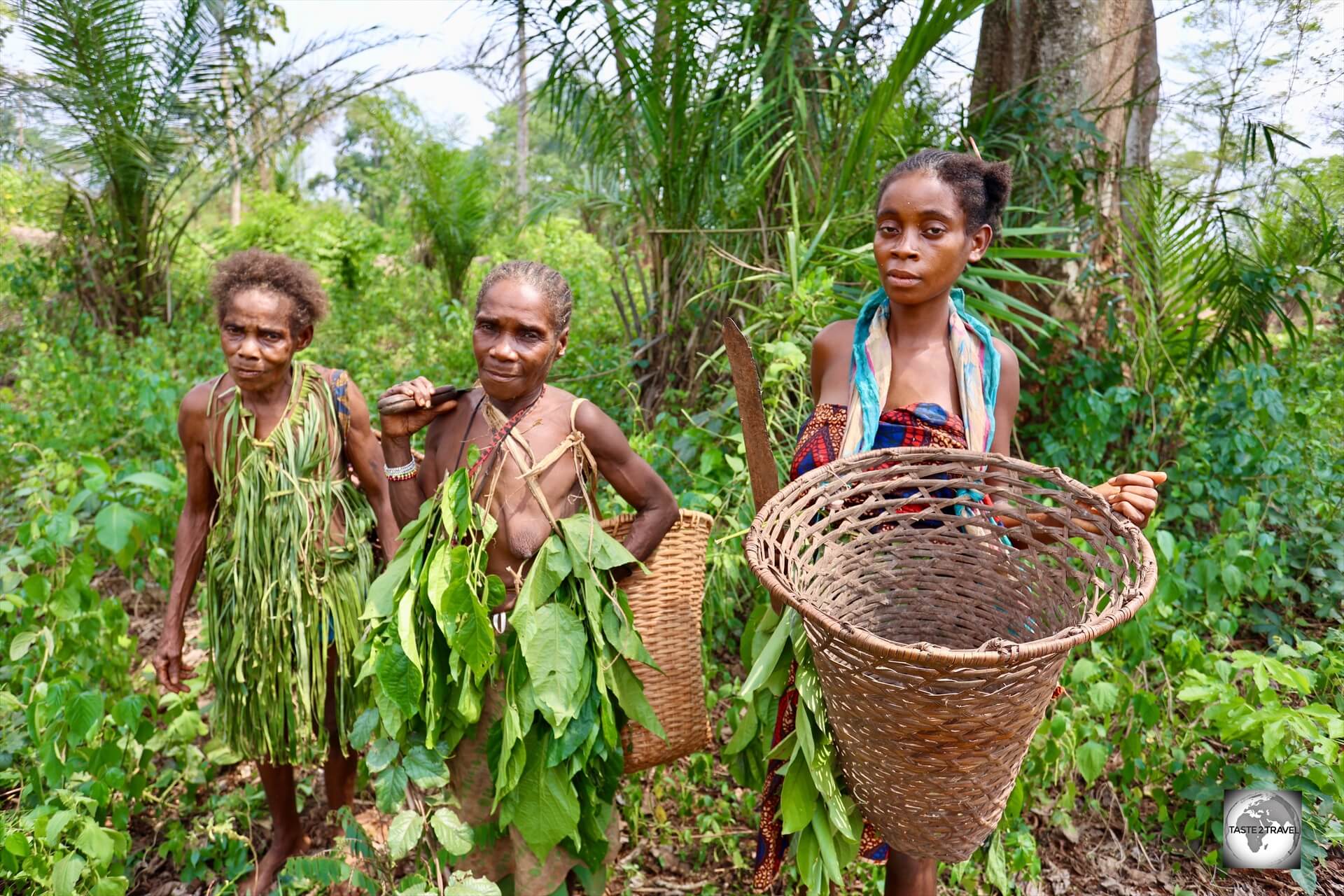
These ladies demonstrated the collection of traditional bush medicine which is vital to the pygmy communities.
In another demonstration, two brave men, totally unprotected, battled bees to show us how the pygmies collect traditional wild honey.
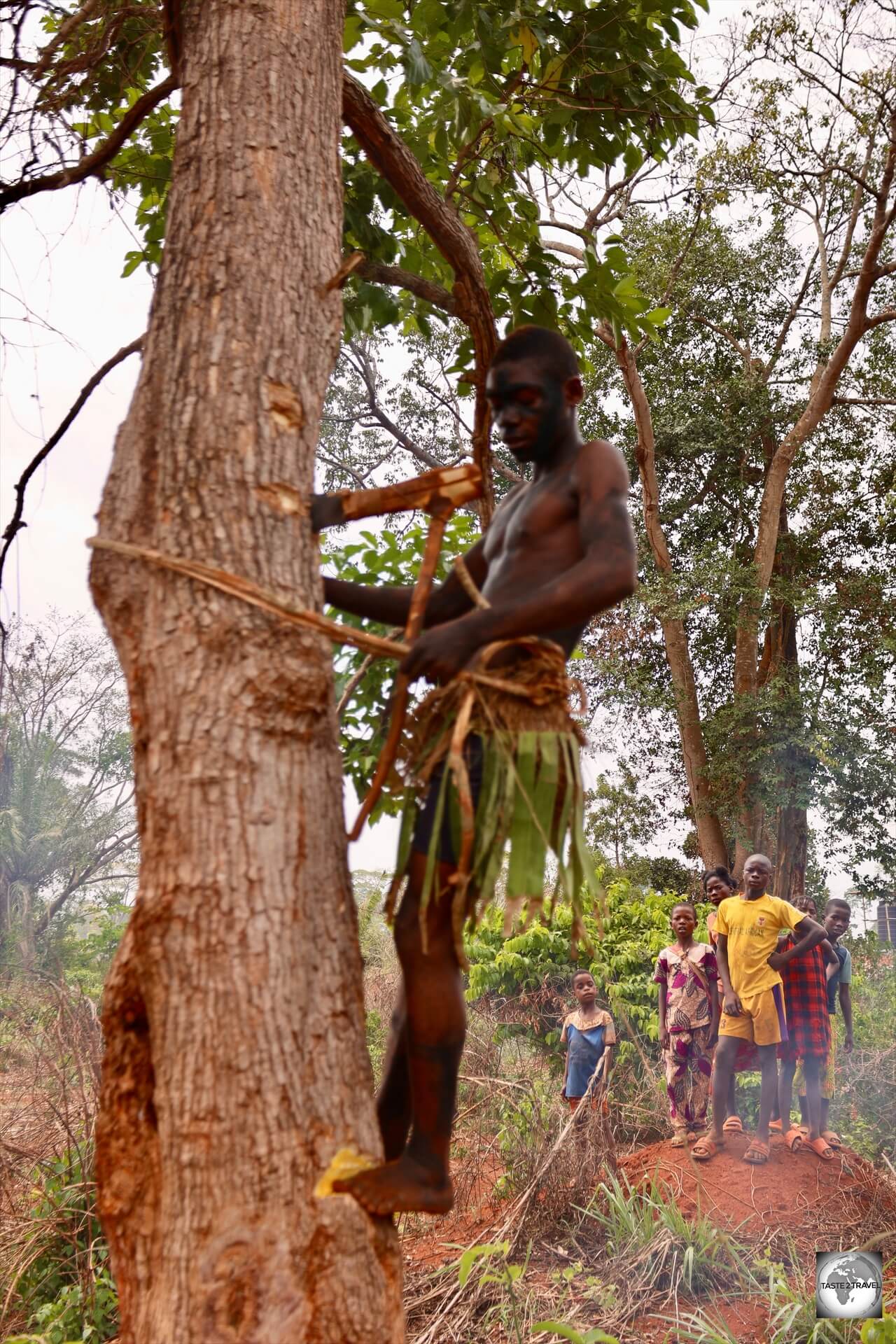
An Ata Pygmy demonstrating how wild honey is collected.
The honey, which was very dark in colour, was rich, and full of flavour.

I got to taste this wild honey which was very rich and full of flavour.
Despite this being a contrived tourist experience for the benefit of our group, our visit to the Ata Pygmy tribe was informative, entertaining and a real highlight of the trip.

An unforgettable musical and dance performance, especially by the children, by the Ata Pygmy community in the remote village of Kpèkèto
Accommodation
Ledger Plaza Bangui
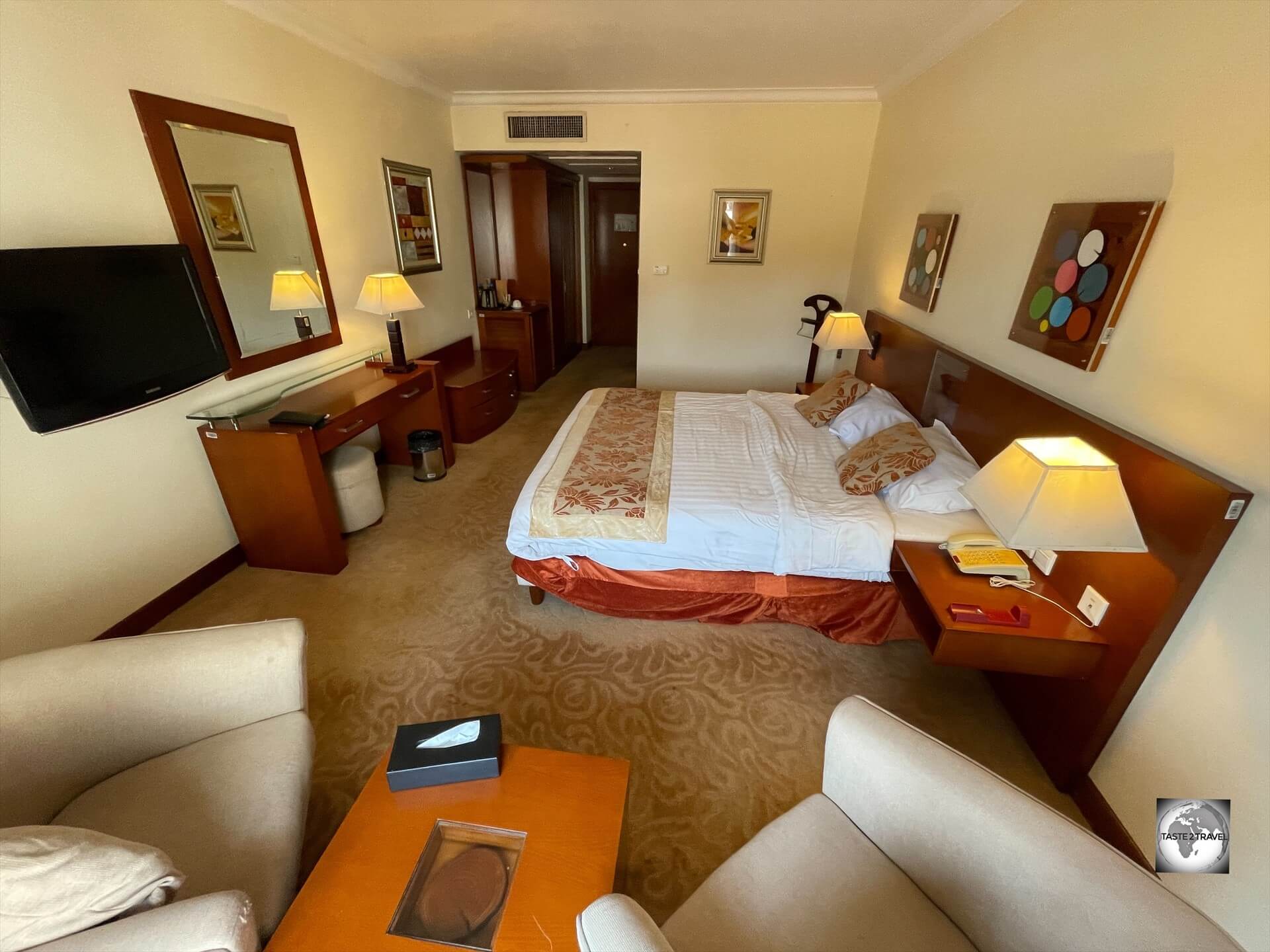
My room at the Ledger Plaza Bangui, the best hotel in the Central African Republic.
The Ledger Plaza Bangui is a prominent 5-star hotel located in a secured compound in downtown Bangui.
Inaugurated on September 15, 2012, by then-President François Bozizé, Sylvie Annick Mazoungou, and the Libyan Ambassador to the CAR, the hotel was established as a symbol of luxury and international investment in the region.
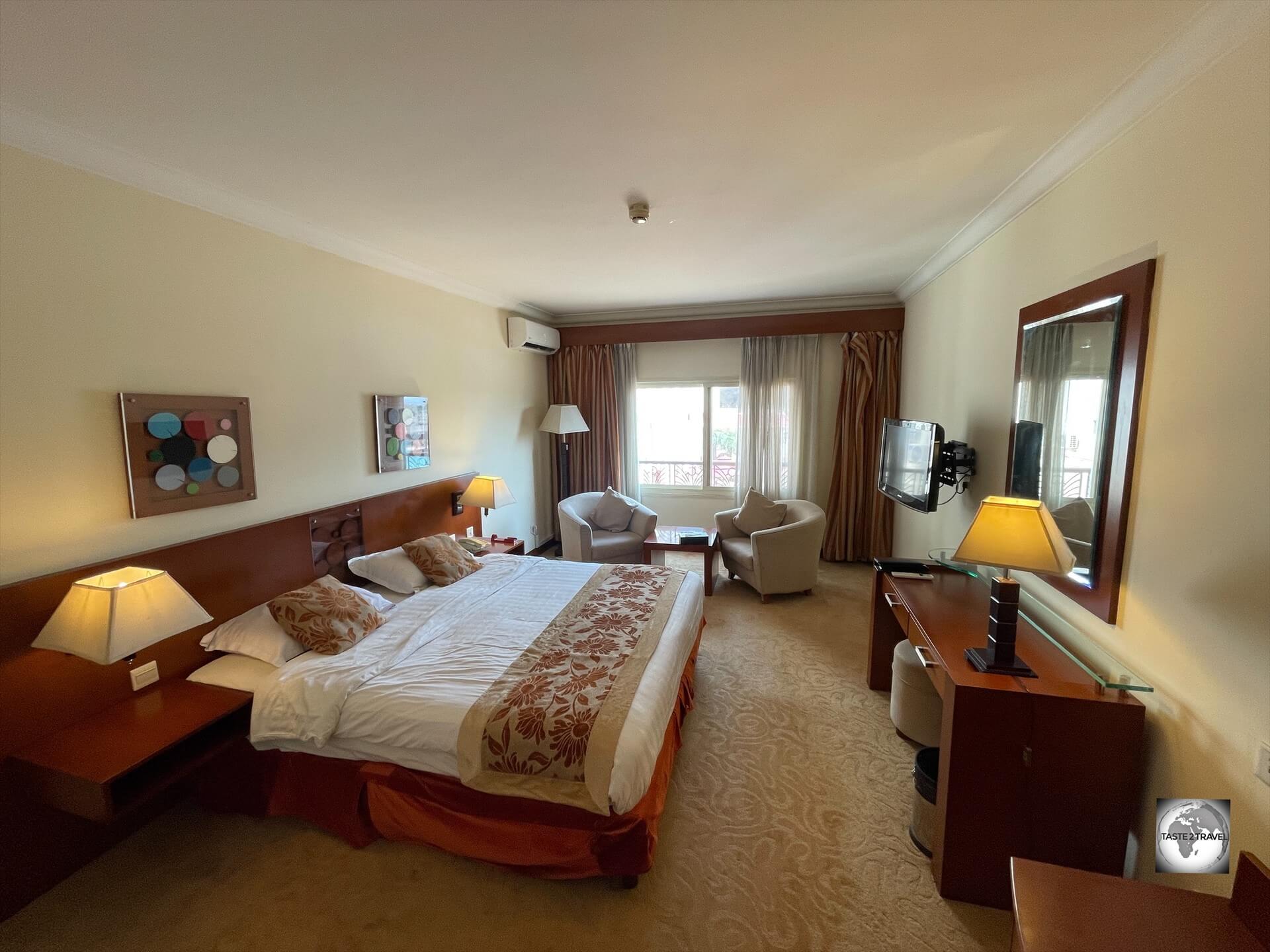
Although it was inaugurated in 2012, the rooms at the Ledger Plaza Bangui, which cost €210 per night, are already dated.
Fully funded by Colonel Gaddafi, and formerly owned by the Libyan African Investment Company (LAICO), the hotel features 156 rooms and offers amenities such as a swimming pool, spa, fitness centre, tennis court, and multiple dining options.
During the Seleka government’s rule, the hotel was occupied by militia forces, with leader Michel Djotodia residing in the presidential suite.
In March 2022, the Arem Group acquired the hotel from LAICO, with Tunisian businessman Walid Arem taking over its operations.
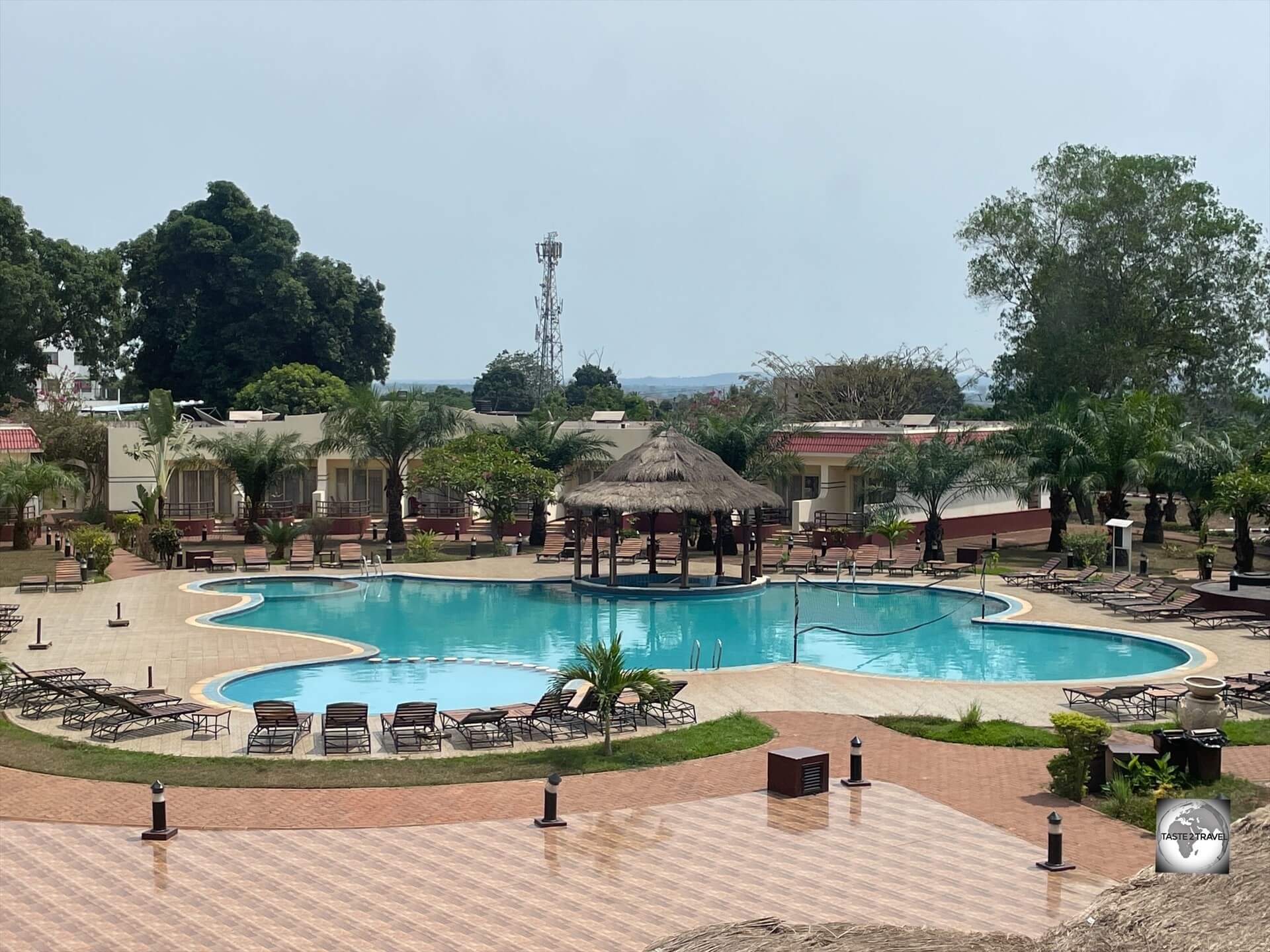
A view of the swimming pool at the Ledger Plaza Bangui.
Despite its luxurious offerings, the hotel has faced challenges, including labor disputes in 2020, where local staff protested against poor working conditions and wage disparities compared to expatriate employees.
The WiFi system works, but at a snail’s pace. It’s extremely slow and will not support anything beyond checking emails. This is not a place to be uploading videos to social media.
Annoyingly, you have to log in every time you enter the hotel!
During my 5-night stay, there were constant power outages with no generators providing backup service.
Also, the room card-key expired every day and needed to be renewed by reception each morning.
Despite all the short-comings, the Ledger Plaza Bangui remains a significant establishment in the city, offering the best accommodation in the country, albeit at a high price with the average room price being €210 per night.
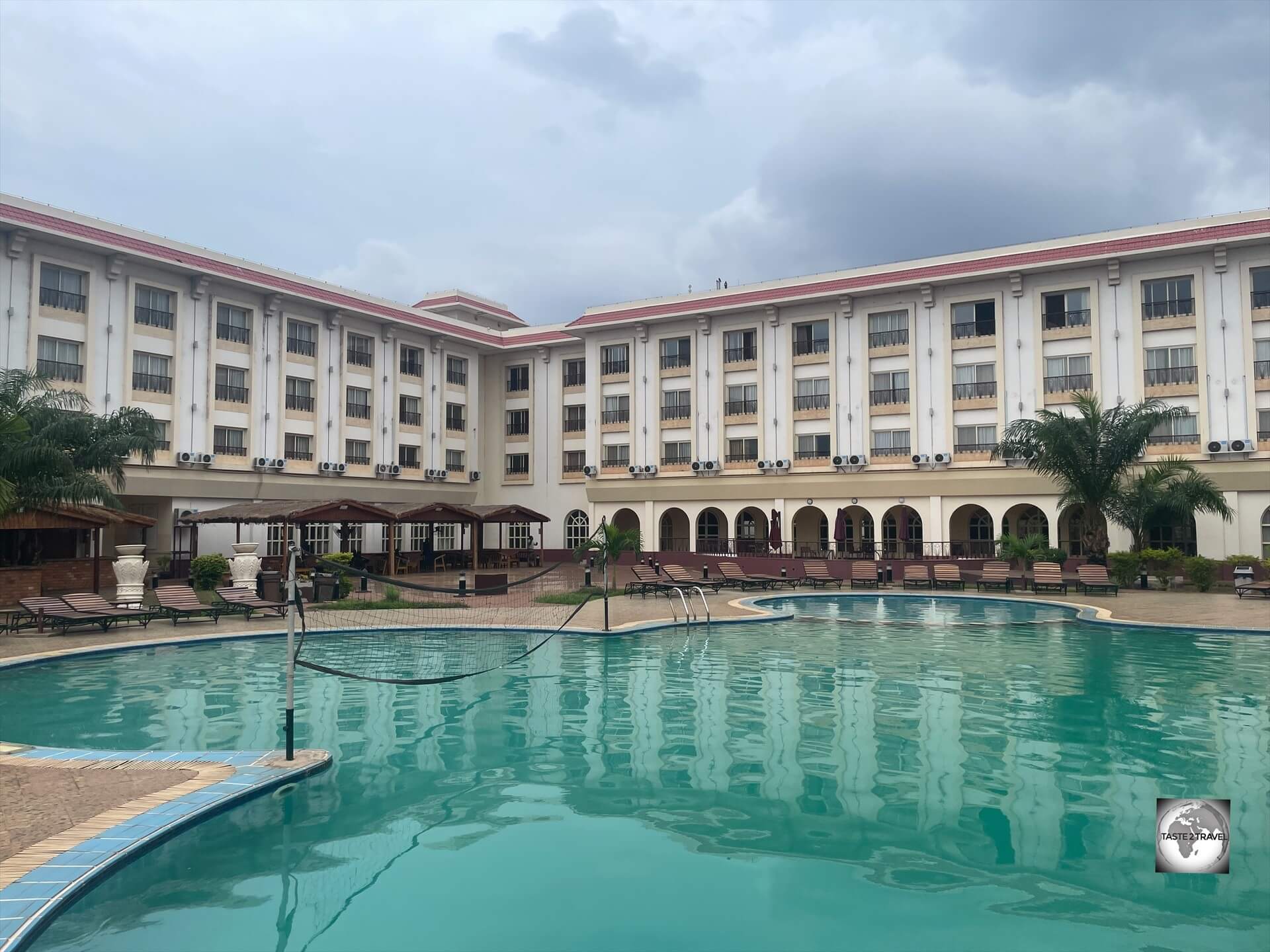
A view of the Ledger Plaza Bangui, which was funded by the former Libyan dictator – Colonel Gaddafi.
Rooms at the Ledger Plaza Bangui can be booked on booking.com
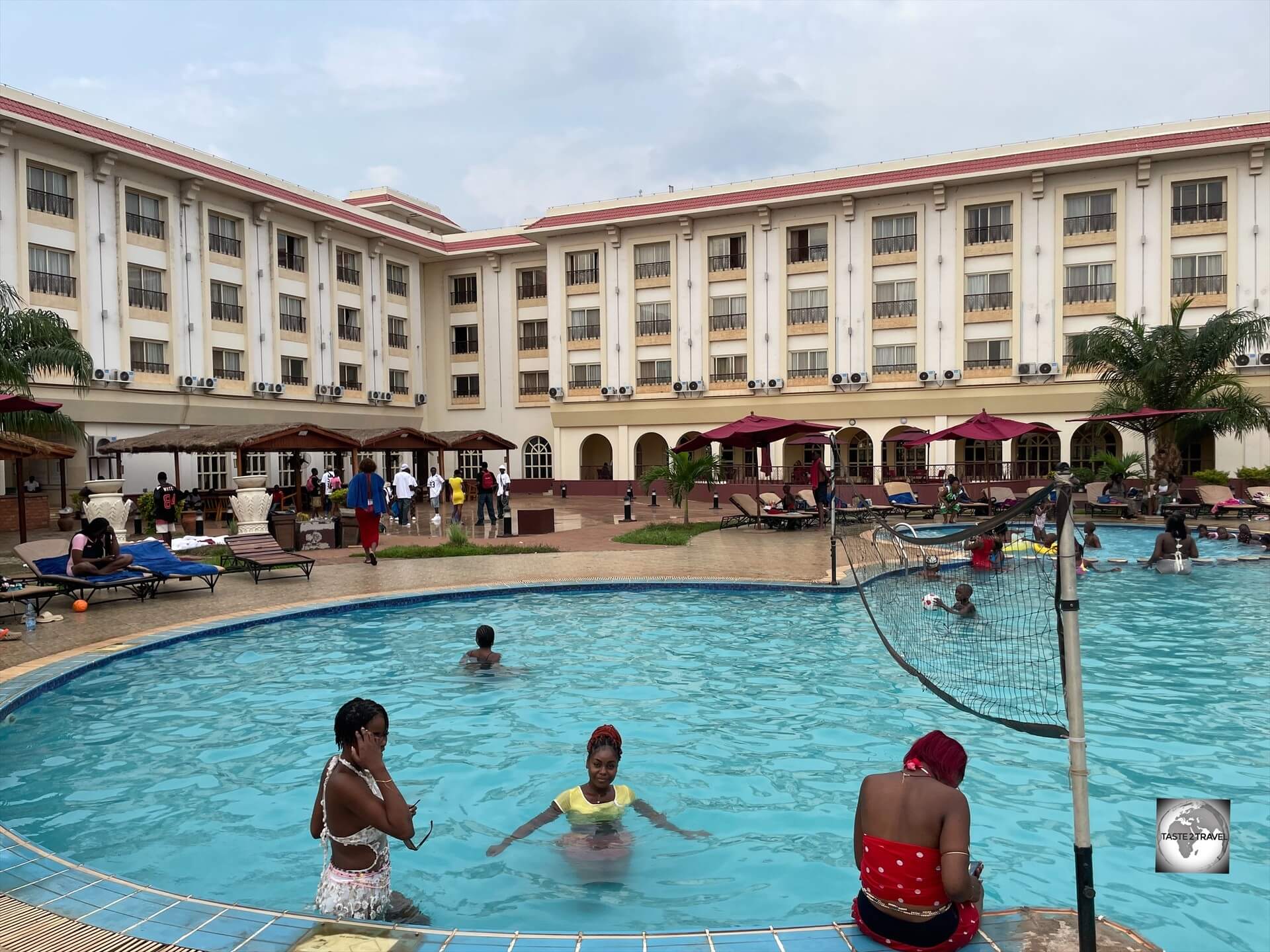
The swimming pool at the Ledger Plaza Bangui is very popular with visiting locals on the weekends.
Always at night, its best to have a torch next to your bed in case you need to get up during the night, when the power is normally off!
For those who need cash, there is an Eco Bank ATM in the lobby which accepts Visa and Mastercard.
Hotel Oubangui
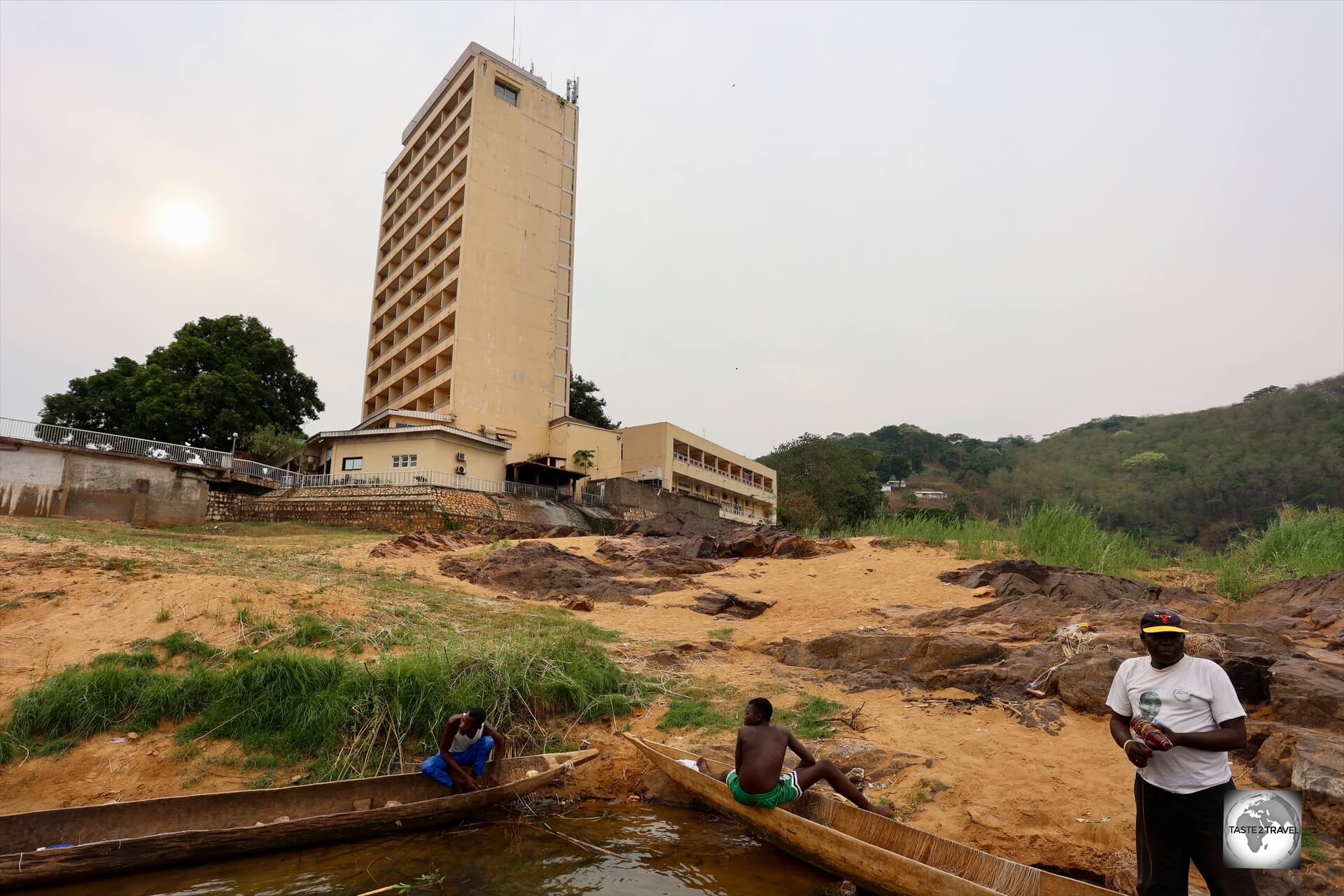
A view of the Hotel Oubangui, which offers the best views in Bangui, but is an old and tired hotel which rates poorly among visitors.
Overlooking the Ubangi River, a short walk from the Maison Russe, the Hotel Oubangui offers panoramic views of the Ubangi River, and the Democratic Republic of Congo (DRC) on the opposite shore.
The hotel is old, tired and run down and has received plenty of negative reviews online from disappointed travellers.
Eating Out
During my time in Central African Republic, I ate most meals at the Ledge Plaza Bangui which offers OK food with OK service.
The hotel is aware of its monopoly position in a market which is under-served by quality hotels so the kitchen, and the staff, do not need to try too hard.
All meals in the hotel restaurant are served buffet-style while the hotel bar offers an à la carte menu of pizzas, hamburgers and sandwiches.
Visa Requirements
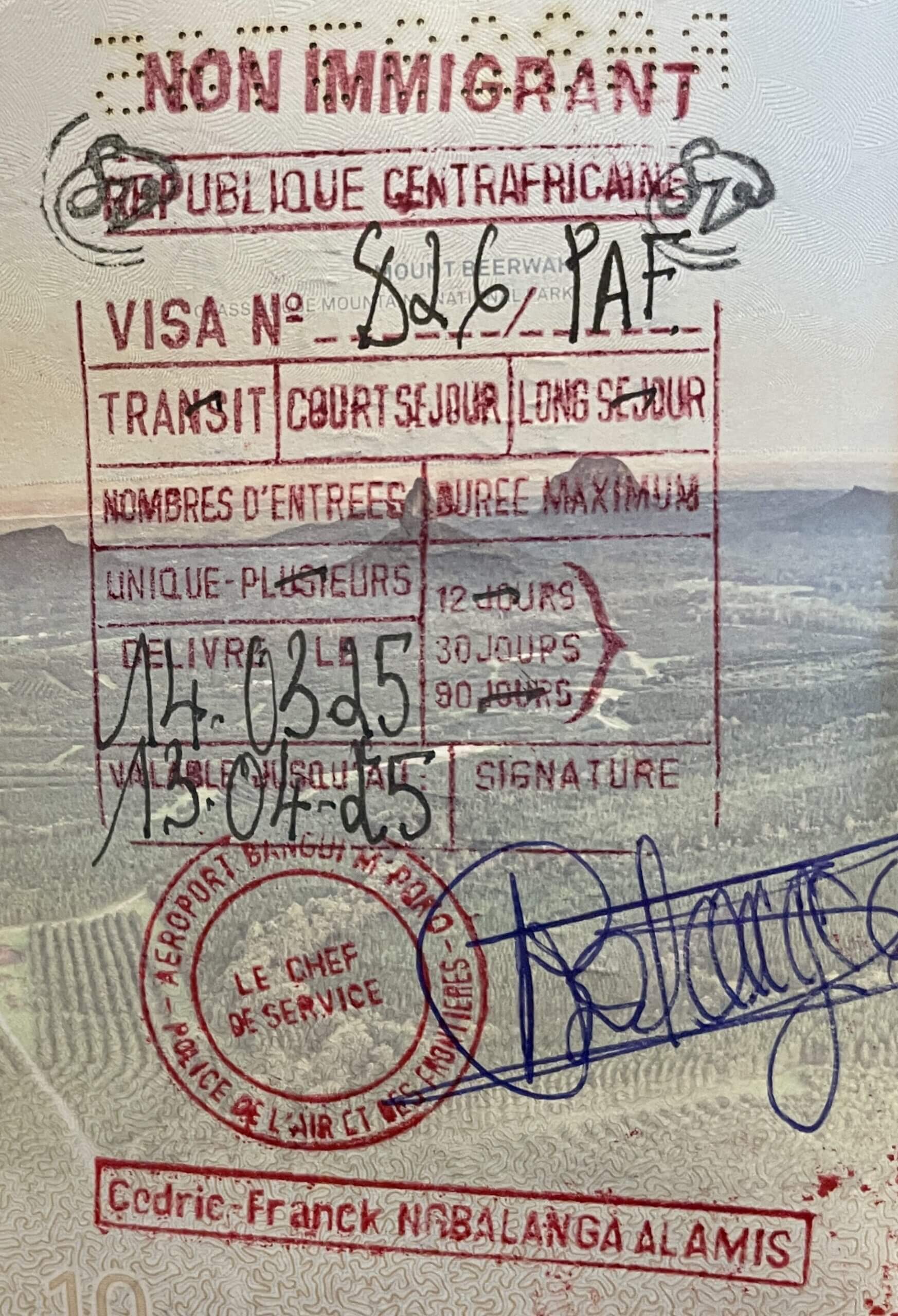
My visa for the Central African Republic, which was issued at Bangui Airport.
Almost everyone requires a visa to enter the Central African Republic.
Citizens of CEMAC (Economic and Monetary Community of Central Africa) enjoy visa-free travel.
This includes citizens of Cameroon, Chad, Republic of the Congo, Equatorial Guinea and Gabon.
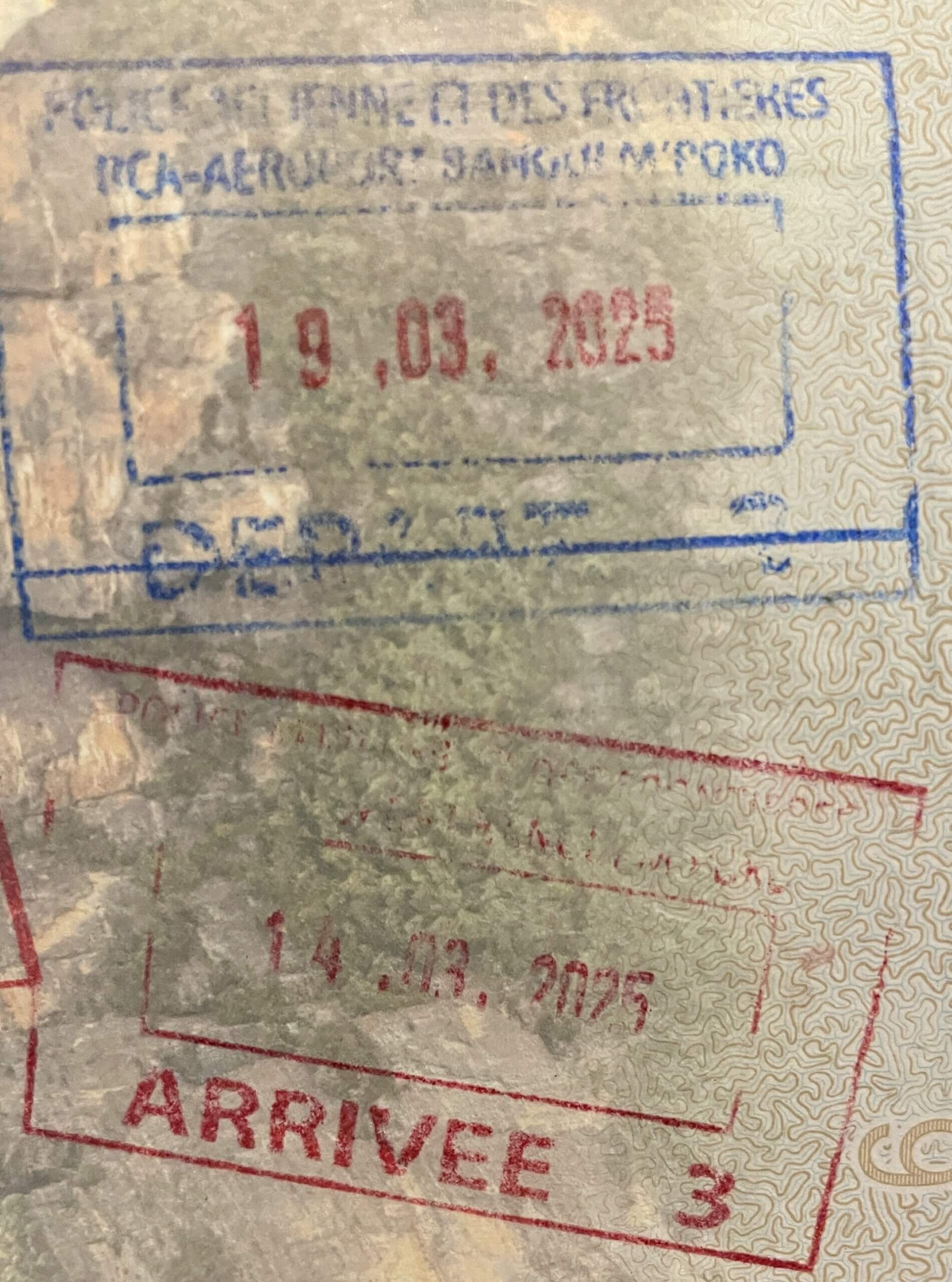
My entry and exit stamps for the Central African Republic.
Generally, visas must be obtained in advance from an embassy.
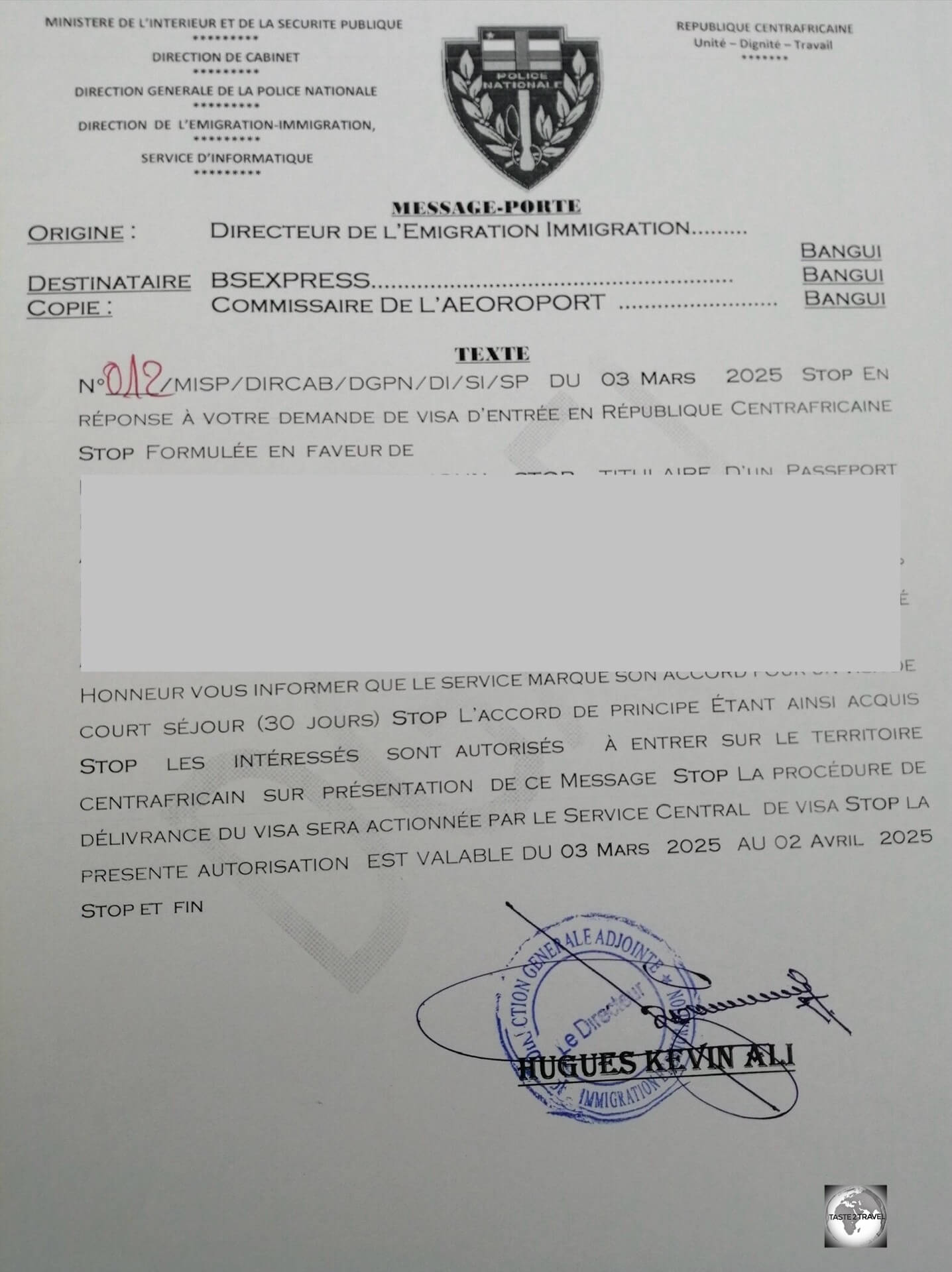
My Message Porte which allowed me to fly to Bangui Airport where a visa was then issued upon arrival.
However, a visa-on-arrival (VOA) is possible for those visitors who have been issued with a Message Porte, which is similar to a Letter of Invitation (LOI) that you receive from a local contact, such as a local tour company.
This allows a person to fly to Bangui Airport where a visa will be placed into their passport.
A Message Porte, which takes around 2 weeks to issue, is the easiest way to enter the Central African Republic!
For more details, or to apply for a Message Porte, I recommend contacting my guide, Steve of Sway Travel in Bangui (please refer to the ‘Tour Guide‘ section above for more details).
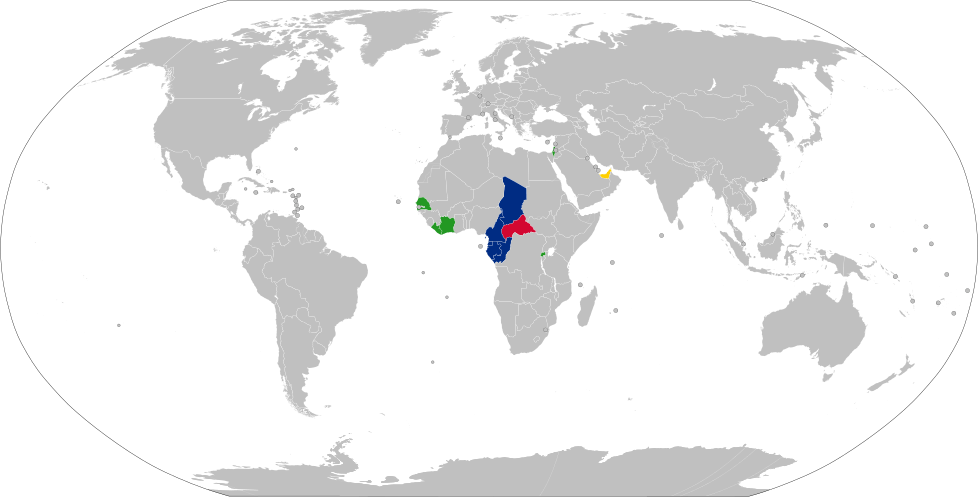
The Visa Policy Map of the Central African Republic with countries in grey needing a visa.
Prior to travel, you should check your requirements by consulting the Visa Policy of the Central African Republic.
Getting There
Air
Bangui M’Poko International Airport (IATA: BGF) is an international airport located seven kilometres northwest of Bangui.
The airport has a small passenger terminal offering basic services.
It can handle a limited number of international flights.
Facilities are modest and often considered underdeveloped, reflecting the economic situation of the country.
International flights are relatively limited and subject to change due to political and security issues in the country.
Despite its limited capacity, Bangui M’Poko remains a critical transportation hub for international aid, government travel, and connecting CAR to the outside world.
The following airlines operate scheduled services to/from Bangui M’Poko International Airport:
- Afrijet – flies to/from Libreville
- Air France – flies to/from Paris–Charles de Gaulle
- ASKY Airlines – flies to/from Douala
- Camair-Co – flies to/from Douala
- Ethiopian Airlines – flies to/from Addis Ababa
- Royal Air Maroc – flies to/from Casablanca
- RwandAir – flies to/from Kigali
I flew to Bangui with Ethiopian Airlines which offers one daily flight from Addis Ababa.
Airport Transport
Hotels, such as the Ledger Plaza Hotel, offer airport shuttle services for guests.
It’s best to organise a shuttle transfer in advance.
Land
The Central African Republic is a landlocked country located in the heart of Africa.
It shares land borders with six neighbouring countries which include:
Chad – North
- Border length: ~1,197 km (744 miles)
- Geography: Mostly savanna and Sahel region; semi-arid and flat.
- Key crossing point: Sido (CAR) to Sarh (Chad)
Sudan – Northeast
- Border length: ~174 km (108 miles)
- Terrain: Sparsely populated, with arid and rugged landscapes.
South Sudan – East
- Border length: ~1,055 km (656 miles)
- Terrain: Woodland and savanna, often remote and undeveloped.
- Context: Border area has seen cross-border movements and instability.
Democratic Central African Republic (DRC) – South
- Border length: ~1,577 km (980 miles)
- Features: Includes the Ubangi River, which forms much of the natural border.
- Important towns: Bangui (CAR’s capital) lies right along this river border.
Republic of the Congo – Southwest
- Border length: ~487 km (303 miles)
- Terrain: Dense rainforest and river systems.
Cameroon – West
- Border length: ~901 km (560 miles)
- Geography: A mix of forest, savanna, and rolling hills.
- Key trade route: Douala (Cameroon) to Bangui, via the main road corridor.
Getting Around

A Central African Republic car license plate.
Public transport in the Central African Republic is relatively underdeveloped and informal, largely due to the country’s economic challenges and infrastructure limitations.
Roads outside of Bangui are often unpaved and poorly maintained, especially during the rainy season, which significantly impacts the availability and reliability of public transport.
Minibuses and Shared Vans (taxi-brousse)
These are used both within Bangui and for intercity travel.
They are often overcrowded and follow semi-fixed routes.
This is the most accessible form of public transport for many people.
Taxis
In Bangui, taxis are a common mode of transportation.
These are often shared among multiple passengers and can be flagged down on the street.
There are no formal meters, so fares must be negotiated in advance.
Rental Car
A car with a driver can be rented through the Ledger Plaza Bangui.
That’s the end of my travel guide for the Central African Republic.
If you wish to leave feedback/ comments, you can do so using the form below.
Safe Travels!
Darren
Further Reading
Following is a list of my travel content from the region:

